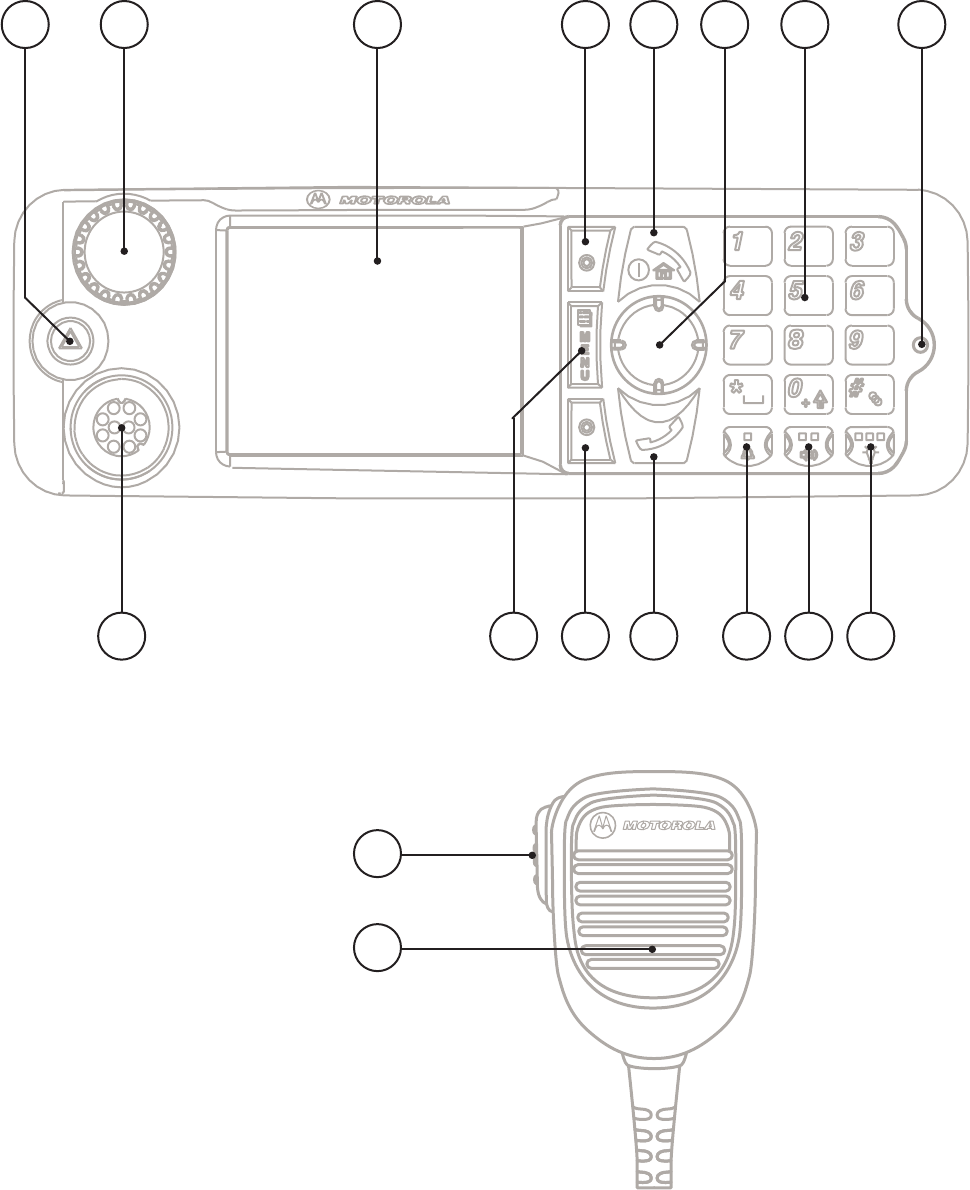Motorola Solutions 92FT5869 2 Way Mobile Radio User Manual Manual
Motorola Solutions, Inc. 2 Way Mobile Radio Manual
Contents
- 1. RF Safety Manual
- 2. Manual
Manual
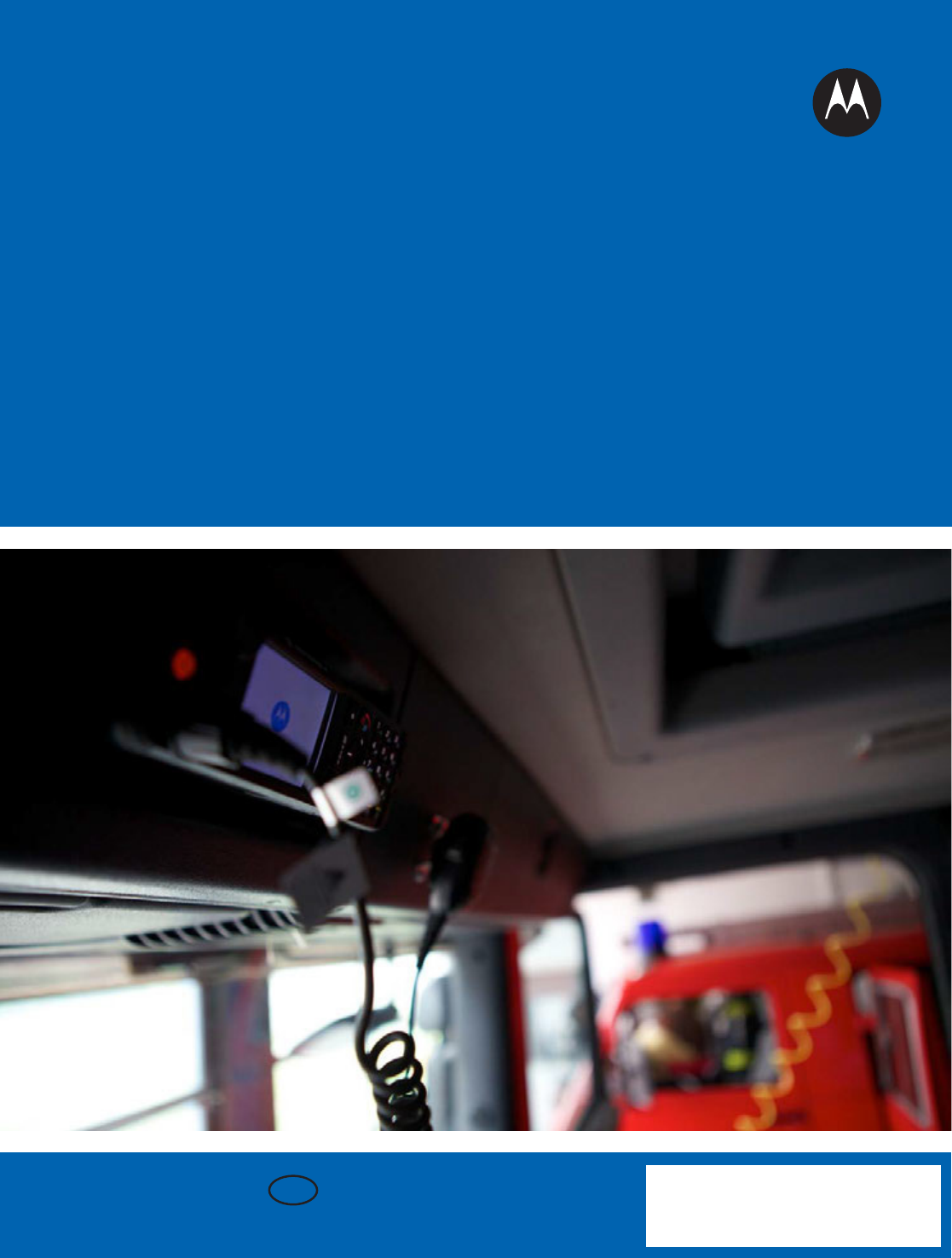
MN001670A01-A
*MN001670A01*
March 201 5 EN
© 2015 Motorola Solutions, Inc. All rights reserved.
FEATURE USER
GUIDE - USA and
Canadian version
Mobile Release 14.0
MTM5x00
Contents
List of Figures............................................................................................................13
List of Tables............................................................................................................. 15
Copyrights................................................................................................................. 17
Chapter 1: General Information.............................................................................. 19
Icon Conventions......................................................................................................................... 19
Declaration of Conformity............................................................................................................ 19
Important Safety Information....................................................................................................... 20
Informations importantes sur la sécurité......................................................................................21
Using this Guide.......................................................................................................................... 21
Feature and Service Availability.................................................................................................. 21
Chapter 2: Getting Started.......................................................................................23
Product Technical Information..................................................................................................... 23
Controls and Indicators................................................................................................................24
Display......................................................................................................................................... 30
Display Orientation............................................................................................................31
Configurable Idle Screen.................................................................................................. 31
Status Icons................................................................................................................................. 32
Powering On the Radio................................................................................................................36
Unlocking Your Radio.................................................................................................................. 36
Unblocking Your Radio..................................................................................................... 36
Locking/Unlocking the Keys/Buttons........................................................................................... 36
External SIM Card Priority........................................................................................................... 37
Entering TMO / DMO Mode......................................................................................................... 37
Transmit Inhibit Mode.................................................................................................................. 37
Selecting Talkgroups................................................................................................................... 38
Talkgroup Icon Selection............................................................................................................. 38
Using Timed Talkgroup Change.................................................................................................. 38
Activating Talkgroup Scanning.................................................................................................... 39
Broadcast Call............................................................................................................................. 39
Ambience Listening (AL) Call...................................................................................................... 39
One-Touch Button Feature.......................................................................................................... 39
Terminal Temporary Disable/Enable........................................................................................... 41
Terminal Permanent Disable....................................................................................................... 41
During the Call............................................................................................................................. 41
Writing Text..................................................................................................................................41
Contents
Send Feedback 3
Selecting Text Entry Modes.............................................................................................. 41
Selecting Text Entry Methods and Languages................................................................. 42
Text Entry Icons................................................................................................................ 42
Keys Usage.......................................................................................................................43
Writing in iTAP Alphanumeric........................................................................................... 44
Writing in TAP Alphanumeric............................................................................................ 45
Word Locking.................................................................................................................... 45
Adding Words to the Dictionary........................................................................................ 46
Home Display Text Message.......................................................................................................46
Chapter 3: Modes..................................................................................................... 47
Using Networks............................................................................................................................47
Trunked Mode Operation.............................................................................................................47
Entering TMO Mode..........................................................................................................47
Selecting Talkgroups........................................................................................................ 48
Making Group Calls in TMO..............................................................................................48
Receiving Group Calls in Idle............................................................................................48
Receiving Group Calls during Ongoing Group Calls.........................................................48
Dynamic Group Number Assignment (DGNA)..................................................................49
DGNA Reception.............................................................................................................. 49
DGNA Auto Select Group................................................................................................. 49
DGNA Auto Reselect Group............................................................................................. 49
Viewing DGNA Talkgroups............................................................................................... 49
Broadcast Calls Initiated by Users.................................................................................... 50
Initializing Broadcast Calls................................................................................................ 50
Phone and PABX Calls..................................................................................................... 50
Private Call........................................................................................................................50
Making Private Calls......................................................................................................... 51
Assistance Call................................................................................................................. 51
Call Modification................................................................................................................51
Local Site Trunking...................................................................................................................... 52
Entering Local Site Trunking.............................................................................................52
Exiting Local Site Trunking............................................................................................... 52
Direct Mode Operation.................................................................................................................53
Entering DMO Mode......................................................................................................... 53
Selecting Talkgroups........................................................................................................ 53
Making Group Calls in DMO............................................................................................. 53
Receiving Group Calls in Idle............................................................................................54
Private Call........................................................................................................................54
Making Private Calls......................................................................................................... 54
Contents
4 Send Feedback
Private Call With Presence Check.................................................................................... 55
DMO Private Priority Call.................................................................................................. 55
Talkgroup for Individual Calls............................................................................................55
Communication through Repeaters.................................................................................. 55
Communication through Gateways...................................................................................56
Selecting DMO Group Call Options.................................................................................. 56
Transmit Inhibit Mode.................................................................................................................. 57
Emergency Operations................................................................................................................ 58
Emergency Group Call......................................................................................................58
Making Emergency Group Calls....................................................................................... 59
Receiving Emergency Group Calls................................................................................... 59
Non-Tactical Emergency...................................................................................................59
Emergency Individual Calls (Private or MS-ISDN)............................................................59
Emergency Alarm............................................................................................................. 60
Emergency SDS Status.................................................................................................... 60
Emergency Hot Microphone............................................................................................. 60
Alternating Hot Microphone.............................................................................................. 60
Silent Emergency Mode....................................................................................................61
Invisible Emergency..........................................................................................................61
Emergency Mode by Dialing............................................................................................. 61
Disaster Alert.................................................................................................................... 62
Initializing Disaster Alert Calls...........................................................................................62
Exiting Emergency Operations......................................................................................... 62
Repeater Mode............................................................................................................................ 62
Entering the Repeater Mode.............................................................................................63
Setting Monitor Option...................................................................................................... 63
Encryption in the Repeater Mode..................................................................................... 63
Gateway Mode.............................................................................................................................64
Entering Gateway Mode................................................................................................... 64
Standby Mode...................................................................................................................65
Forwarding Group Calls.................................................................................................... 65
Setting Monitor Options.................................................................................................... 65
Emergency Calls in Gateway Mode..................................................................................65
Encryption in Gateway Mode............................................................................................ 65
Chapter 4: GPS Location Service........................................................................... 67
Enhancing GPS Performance......................................................................................................68
Enabling GPS.............................................................................................................................. 68
GPS Icon..................................................................................................................................... 68
GPS Different Location Displays................................................................................................. 68
Contents
Send Feedback 5
Viewing Your Position..................................................................................................................69
GPS – Things to Keep in Mind.................................................................................................... 69
Chapter 5: Main Menu..............................................................................................71
Scrolling through the Menu..........................................................................................................71
Menu Icons.................................................................................................................................. 71
Messages.................................................................................................................................... 72
New Message................................................................................................................... 72
Sending Messages to Private/Phone..................................................................... 73
Sending Messages to Groups................................................................................73
Sending Store and Forward Messages..................................................................73
Delivery Report...................................................................................................... 74
Viewing Delivery Reports....................................................................................... 74
Configuring Delivery Reports................................................................................. 74
Inbox................................................................................................................................. 75
Entering the Inbox.................................................................................................. 75
Receiving New Messages......................................................................................75
Using Submenus in the Inbox and the Outbox.......................................................75
Embedded Number................................................................................................ 76
Storing Numbers from Messages...........................................................................76
Calling Numbers in Messages............................................................................... 76
Making Group Calls on theTalkgroup of the Message Sender.............................. 77
Immediate Message...............................................................................................77
Outbox.............................................................................................................................. 77
CO Box............................................................................................................................. 78
RMS Box...........................................................................................................................78
WAP Box...........................................................................................................................78
Templates......................................................................................................................... 78
Sending User-Defined Templates.......................................................................... 78
Setting User-Defined Templates............................................................................ 78
Predefined Templates.......................................................................................................79
Viewing Predefined Templates.............................................................................. 79
Sending Predefined Templates..............................................................................79
Status Messages.............................................................................................................. 79
Viewing a Status Message Number....................................................................... 79
Sending Status Messages..................................................................................... 80
Targeted Status Messages.................................................................................... 80
Sending Targeted Status Messages...................................................................... 80
Contacts.......................................................................................................................................80
Creating Contacts............................................................................................................. 81
Contents
6 Send Feedback
Editing Contacts................................................................................................................81
Deleting Numbers............................................................................................................. 82
Deleting Contacts..............................................................................................................82
Checking Capacity............................................................................................................ 82
Dialing through the Contact List........................................................................................83
Browser........................................................................................................................................83
Security........................................................................................................................................83
PIN Protect........................................................................................................................83
Protecting the Radio with a PIN Code....................................................................83
Unblocking Your Radio.......................................................................................... 83
Changing PIN Codes............................................................................................. 84
Keylock Setup................................................................................................................... 84
Keypad Lock Notification........................................................................................84
Setting Automatic Keylock Delay........................................................................... 84
Setting Keylock on Startup.....................................................................................85
Air Encryption....................................................................................................................85
Viewing the Air Encryption State............................................................................85
Air Encryption Key Deletion................................................................................... 85
K Validity........................................................................................................................... 86
Verifying K Validity................................................................................................. 86
SCK (Air Interface Encryption Class 2).............................................................................86
TMO SCK...............................................................................................................86
DMO SCK.............................................................................................................. 86
Changing DMO SCK.............................................................................................. 86
Verifying TMSCK Validity..................................................................................................87
Verifying DMSCK Validity................................................................................................. 87
Covert Mode..................................................................................................................... 87
Activating the Covert Mode.................................................................................... 88
SDS Remote Control........................................................................................................ 88
Setting SDS Remote Control................................................................................. 88
Setup........................................................................................................................................... 88
Ring Style..........................................................................................................................88
Setting Ring Style...................................................................................................88
Set Volume....................................................................................................................... 89
Setting Volume.......................................................................................................89
Language.......................................................................................................................... 89
Setting Language................................................................................................... 89
Data Setup........................................................................................................................ 90
Setting Data Function.............................................................................................90
Contents
Send Feedback 7
Audio.................................................................................................................................90
Audio Profiles......................................................................................................... 90
Setting Audio Profiles.............................................................................................90
Volume Adjustment Mode...................................................................................... 91
Setting Volume Adjustment Mode..........................................................................91
Tones................................................................................................................................ 91
Keypad Tone..........................................................................................................91
Setting Keypad Tone..............................................................................................91
All Tones................................................................................................................ 91
Setting All Tones.................................................................................................... 91
Talk Permit............................................................................................................. 92
Setting Talk Permit.................................................................................................92
Clear to Send......................................................................................................... 92
Setting Clear to Send............................................................................................. 92
Periodic Alert..........................................................................................................92
Setting Periodic Alert..............................................................................................92
D-PTT Tones..........................................................................................................93
Setting D-PTT Tones............................................................................................. 93
Display.............................................................................................................................. 93
Setting Font Level.................................................................................................. 93
Setting Large Idle Font...........................................................................................93
Setting Extended Status Icons............................................................................... 94
Setting Screen Saver............................................................................................. 94
Setting Backlight.................................................................................................... 94
Setting Wallpaper...................................................................................................95
Time and Date.................................................................................................................. 95
Setting Time and Date on the Display....................................................................95
Setting the Time Format.........................................................................................95
Setting the Time Manually......................................................................................96
Setting the Date Format......................................................................................... 96
Setting the Date Manually...................................................................................... 96
Setting Time Offset................................................................................................ 96
Setting Automatic Updates for the Time and Date ................................................97
Active Accry (Accessory) Type......................................................................................... 97
Selecting the Active Accessory (Accry) Type.........................................................97
Volume Cntrl (Control)...................................................................................................... 97
Setting Volume Cntrl (Control)............................................................................... 97
Accry (Accessory) Setup...................................................................................................98
Configuring Control Head Accessories.................................................................. 98
Contents
8 Send Feedback
Configuring Transceiver Accessories.....................................................................98
Book On............................................................................................................................ 99
Editing Book On Settings....................................................................................... 99
Rotary Knob...................................................................................................................... 99
Setting Rotary Knob Mode..................................................................................... 99
Setting Rotary Lock..............................................................................................100
Setting In Keypad Lock........................................................................................ 100
Setting Rotary Knob Wrap Around.......................................................................100
Setting Rotary Knob Scroll Range....................................................................... 101
Setting Rotary Knob Talkgroup Selection............................................................ 101
Group Setup.............................................................................................................................. 101
Standard Home Group....................................................................................................101
Operations Parameters........................................................................................ 101
Scan................................................................................................................................102
Activating Talkgroup Scanning.............................................................................102
Setting Talkgroups in the Active Scan List...........................................................103
Setting Scan Lists................................................................................................ 103
Deleting Talkgroups from Scan Lists................................................................... 103
My Groups...................................................................................................................... 103
Favorites.................................................................................................................................... 104
Making Private Calls to Favorite Contact Numbers........................................................ 104
Adding Folders to Favorites............................................................................................ 104
Adding Contact Numbers to Favorites............................................................................ 104
Adding Talkgroups to Favorites...................................................................................... 104
Managing Folders in Favorites........................................................................................105
Deleting Items from Favorites Folder..............................................................................105
Deleting All Items from Favorite Folders.........................................................................105
My Info....................................................................................................................................... 106
Viewing and Modifying Personal Information..................................................................106
Recent Calls.............................................................................................................................. 106
Viewing Recent Calls...................................................................................................... 106
Calling from Recent Calls............................................................................................... 107
Storing Recent Calls to Contacts.................................................................................... 107
Deleting Recent Calls..................................................................................................... 107
Shortcuts....................................................................................................................................108
Creating Menu Shortcuts................................................................................................ 108
Editing Menu Shortcut Lists............................................................................................ 108
RUI.............................................................................................................................................108
Logging On..................................................................................................................... 109
Contents
Send Feedback 9
Logging Off..................................................................................................................... 109
Networks....................................................................................................................................109
Selecting Network Operation Mode................................................................................ 109
Selecting Your Network.................................................................................................. 110
Using the Select Net Registration................................................................................... 110
Using the Foreign Network Registration......................................................................... 110
Using Any Network......................................................................................................... 110
Using the Migrate To Registration.................................................................................. 110
Location..................................................................................................................................... 111
Viewing Your Position..................................................................................................... 111
Viewing Testpage........................................................................................................... 111
Packet Data............................................................................................................................... 111
TETRA Enhanced Data Services (TEDS).......................................................................112
Viewing Data Statistics................................................................................................... 112
Viewing Encryption Status.............................................................................................. 112
Chapter 6: Features............................................................................................... 113
Private Call................................................................................................................................ 113
Making Private Calls....................................................................................................... 113
Radio Messaging System (RMS)...............................................................................................114
RMS Icons...................................................................................................................... 114
Sending an RMS Status..................................................................................................114
One-Touch Dial..........................................................................................................................115
Talkgroup Dialing by Index........................................................................................................ 115
Viewing the Talkgroup Speed Number........................................................................... 115
Selecting Talkgroups by Index........................................................................................115
Phone and PABX Calls..............................................................................................................115
Making Phone or PABX Calls......................................................................................... 115
Phone/PABX Speed Dial........................................................................................................... 116
Using the Phone/PABX Speed Dial................................................................................ 116
DTMF Overdial.......................................................................................................................... 116
Short Number Dial..................................................................................................................... 116
Dual Control Head..................................................................................................................... 116
Interactions between Control Heads...............................................................................117
Dual Control Head Link...................................................................................................117
Audio Accessories.......................................................................................................... 117
Keys Interactions............................................................................................................ 118
RUA/RUI.................................................................................................................................... 118
WAP...........................................................................................................................................118
WAP Browser..................................................................................................................119
Contents
10 Send Feedback
Entering the Browser...................................................................................................... 119
Entering Browser Menu Panes....................................................................................... 119
Tips for Browsing............................................................................................................ 119
Creating Bookmarks through the Navigate Pane.................................................119
Creating Bookmarks through the Bookmarks Pane............................................. 120
Using Bookmarks................................................................................................. 120
Creating Hotkeys..................................................................................................120
Using Hotkeys...................................................................................................... 120
Saving Pages....................................................................................................... 120
Selecting Saved Pages........................................................................................ 121
Disabled Packet Data Service........................................................................................ 121
Disabled Browser Entry.................................................................................................. 121
Keys Usage.....................................................................................................................121
Browser Menu Panes Overview......................................................................................122
Navigate Pane................................................................................................................ 123
Advanced........................................................................................................................ 123
Bookmarks Pane.............................................................................................................124
Working with the Options Pane for Selected Bookmarks.....................................124
Working with the Saved Pages Folder................................................................. 124
History Pane................................................................................................................... 125
Navigating to Recently Visited URLs................................................................... 125
Tools Pane......................................................................................................................125
Options Pane.................................................................................................................. 125
Image Pane.....................................................................................................................125
Text Input Pane...............................................................................................................126
WAP Push.......................................................................................................................126
New WAP Messages........................................................................................... 126
Viewing WAP Messages...................................................................................... 127
Call-Out......................................................................................................................................127
Types of Call-Out Alerts..................................................................................................128
Call-Out Modes Interaction............................................................................................. 128
Call-Out Service Phases.................................................................................................128
Shadow Groups (Address Bundle)............................................................................................ 128
Appendix A: Tones..................................................................................................131
Appendix B: LED Indications.................................................................................133
Appendix C: Troubleshooting................................................................................135
Contents
Send Feedback 11
This page intentionally left blank.
List of Figures
Figure 1: Trunked Mode Operation ....................................................................................................... 47
Figure 2: Direct Mode Operation ........................................................................................................... 53
Figure 3: Repeater Mode Operation ......................................................................................................63
Figure 4: Gateway Mode Operation ...................................................................................................... 64
Figure 5: Call-Out Message .................................................................................................................127
List of Figures
Send Feedback 13
This page intentionally left blank.
List of Tables
Table 1: Special Notations .....................................................................................................................21
Table 2: Product Technical Information .................................................................................................23
Table 3: Controls and Indicators — New Generation Control Head (NGCH) / Remote Ethernet
Control Head (RECH) .......................................................................................................................25
Table 4: Controls and Indicators — Telephone Style Control Head (TSCH) .........................................27
Table 5: Controls and Indicators — Cradle ........................................................................................... 29
Table 6: Display .....................................................................................................................................30
Table 7: Colors of the Soft Key Area ..................................................................................................... 31
Table 8: Status Icons .............................................................................................................................32
Table 9: Talkgroup Icon .........................................................................................................................38
Table 10: One-Touch Button Features .................................................................................................. 39
Table 11: During the Call .......................................................................................................................41
Table 12: Text Entry Screen Icons ........................................................................................................ 42
Table 13: Keys Usage ........................................................................................................................... 43
Table 14: Other Keys .............................................................................................................................44
Table 15: Different Location Displays ....................................................................................................68
Table 16: Menu Icons ............................................................................................................................ 71
Table 17: Inbox Icons ............................................................................................................................ 75
Table 18: Outbox Icons ......................................................................................................................... 77
Table 19: Contact Types ....................................................................................................................... 81
Table 20: RMS Icons ........................................................................................................................... 114
Table 21: Browser Keys Usage ........................................................................................................... 122
Table 22: Browser Menu Panes .......................................................................................................... 122
Table 23: Additional Menu Panes ........................................................................................................123
Table 24: Browser Text Input Icons .....................................................................................................126
Table 25: Radio Tones ........................................................................................................................ 131
Table 26: LED Indications ................................................................................................................... 133
Table 27: Displayed Messages ........................................................................................................... 135
List of Tables
Send Feedback 15
This page intentionally left blank.

Copyrights
The Motorola products described in this document may include copyrighted Motorola computer
programs. Laws in the United States and other countries preserve for Motorola certain exclusive rights
for copyrighted computer programs. Accordingly, any copyrighted Motorola computer programs
contained in the Motorola products described in this document may not be copied or reproduced in any
manner without the express written permission of Motorola.
© 2015 Motorola Solutions, Inc. All Rights Reserved.
No part of this document may be reproduced, transmitted, stored in a retrieval system, or translated
into any language or computer language, in any form or by any means, without the prior written
permission of Motorola Solutions, Inc.
Furthermore, the purchase of Motorola products shall not be deemed to grant either directly or by
implication, estoppel or otherwise, any license under the copyrights, patents or patent applications of
Motorola, except for the normal nonexclusive, royalty-free license to use that arises by operation of law
in the sale of a product.
Disclaimer
Please note that certain features, facilities, and capabilities described in this document may not be
applicable to or licensed for use on a particular system, or may be dependent upon the characteristics
of a particular mobile subscriber unit or configuration of certain parameters. Please refer to your
Motorola contact for further information.
Trademarks
MOTOROLA, MOTO, MOTOROLA SOLUTIONS, and the Stylized M Logo are trademarks or
registered trademarks of Motorola Trademark Holdings, LLC and are used under license. All other
trademarks are the property of their respective owners.
European Union (EU) Waste of Electrical and Electronic Equipment (WEEE)
directive
The European Union's WEEE directive requires that products sold into EU countries must have the
crossed out trashbin label on the product (or the package in some cases).
As defined by the WEEE directive, this cross-out trashbin label means that customers and end-users in
EU countries should not dispose of electronic and electrical equipment or accessories in household
waste.
Customers or end-users in EU countries should contact their local equipment supplier representative or
service centre for information about the waste collection system in their country.
Open Source Software (OSS) Legal Notices
For details on OSS Legal Notices visit Motorola Online (emeaonline.motorolasolutions.com) or browse
the CPS Plus disc.
Copyrights
Send Feedback 17
This page intentionally left blank.
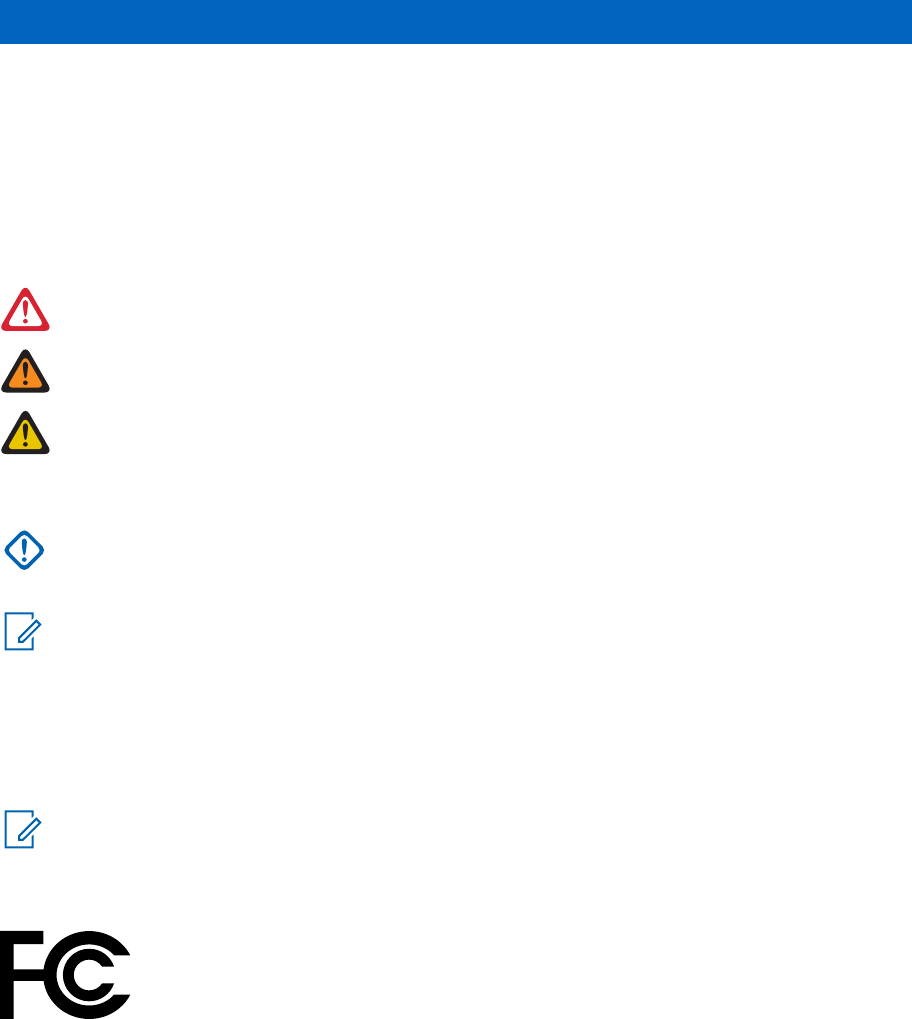
Chapter 1
General Information
Icon Conventions
The documentation set is designed to give the reader more visual clues. The following graphic icons
are used throughout the documentation set. These icons and their associated meanings are described
below.
DANGER: The signal word DANGER with the associated safety icon implies information that, if
disregarded, will result in death or serious injury.
WARNING: The signal word WARNING with the associated safety icon implies information that,
if disregarded, could result in death or serious injury, or serious product damage.
CAUTION: The signal word CAUTION with the associated safety icon implies information that,
if disregarded, may result in minor or moderate injury, or serious product damage.
CAUTION: The signal word CAUTION may be used without the safety icon to state potential
damage or injury that is not related to the product.
IMPORTANT: IMPORTANT statements contain information that is crucial to the discussion at
hand, but is not CAUTION or WARNING. There is no warning level associated with the
IMPORTANT statement.
NOTICE: NOTICE contains information more important than the surrounding text, such as
exceptions or preconditions. They also refer the reader elsewhere for additional information,
remind the reader how to complete an action (when it is not part of the current procedure, for
instance), or tell the reader where something is located on the screen. There is no warning level
associated with a notice.
Declaration of Conformity
NOTICE: Typical use case for MTM5x00 series radio is installation in a vehicle.
Declaration of Conformity is applicable to your radio only if your radio is labeled with the FCC logo
shown below.
DECLARATION OF CONFORMITY
Per FCC CFR 47 Part 2 Section 2.1077(a)
Responsible Party Name:
Motorola Solutions, Inc.
Address:
1303, East Algonquin Road, Schaumburg, Illinois 60196, U.S.A. Phone Number: 1-800-927-2744
Hereby declares that the product:
Model Name: MTM5x00
conforms to the following regulations:
General Information
Send Feedback 19

FCC Part 15, subpart B, section 15.107(a), 15.107(d) and section 15.109(a)
Class B Digital Device
As a personal computer peripheral, this device complies with Part 15 of the FCC Rules. Operation is
subject to the following two conditions:
1This device may not cause harmful interference, and
2This device must accept any interference received, including interference that may cause undesired
operation.
NOTICE: This equipment has been tested and found to comply with the limits for a Class B
digital device, pursuant to part 15 of the FCC Rules. These limits are designed to provide
reasonable protection against harmful interference in a residential installation. This equipment
generates, uses and can radiate radio frequency energy and, if not installed and used in
accordance with the instructions, may cause harmful interference to radio communications.
However, there is no guarantee that interference will not occur in a particular installation.
While the device is communicating with the laptop, the laptop charger must be disconnected.
If this equipment does cause harmful interference to radio or television reception, which can be
determined by turning the equipment off and on, the user is encouraged to try to correct the
interference by one or more of the following measures:
• Reorient or relocate the receiving antenna.
• Increase the separation between the equipment and receiver.
• Connect the equipment into an outlet on a circuit different from that to which the receiver is
connected.
• Consult the dealer or an experienced radio/TV technician for help.
Important Safety Information
RF Energy Exposure and Product Safety Guide For Two-Way Radios
CAUTION: Before using this product, read the RF Energy Exposure and Safety Guide For Two-
Way Radios that ships with the radio. The Guide contains operating instructions for safe usage,
important RF energy awareness and control information as well as regulatory information, to
help ensure compliance with applicable standards and regulations. This radio is restricted to
occupational use only. Any modification to this device, not expressly authorized by Motorola,
may void the user’s authority to operate this device.
Under Industry Canada regulations, this radio transmitter may only operate using an antenna of a type
and maximum (or lesser) gain approved for the transmitter by Industry Canada. To reduce potential
radio interference to other users, the antenna type and its gain should be so chosen that the equivalent
isotropically radiated power (e.i.r.p.) is not more than that necessary for successful communication.
This radio transmitter has been approved by Industry Canada to operate with the Motorola-approved
antenna types with the maximum permissible gain and required antenna impedance for each antenna
type indicated. Antenna types not included, having a gain greater than the maximum gain indicated for
that type, are strictly prohibited for use with this device.
Notice to Users (FCC and Industry Canada)
This device complies with Part 15 of the FCC rules and RSS 210 of the Industry Canada rules per the
conditions listed below:
1This device may not cause harmful interference.
2This device must accept any interference received, including interference that may cause undesired
operation.
Chapter 1: General Information
20 Send Feedback

3Changes or modifications made to this device, not expressly approved by Motorola, could void the
user's authority to operate this equipment.
Informations importantes sur la sécurité
Exposition aux radiofréquences et sécurité du produit pour radios
bidirectionnelles portatives
CAUTION: Cette radio ne doit être utilisée qu'à des fins professionnelles. Avant d'utiliser la
radio, lisez le guide Exposition aux radiofréquences et sécurité du produit pour radios
bidirectionnelles portatives, qui contient d'importantes instructions de fonctionnement pour une
utilisation sécuritaire et des informations sur l'exposition aux fréquences radioélectriques afin
d'assurer la conformité aux normes et règlements applicables.
Selon la règlementation d'Industrie Canada, cet émetteur radio ne peut être utilisé qu'avec une
antenne dont le type et le gain maximal (ou minimal) sont approuvés par Industrie Canada pour cet
émetteur. Afin de limiter les interférences radio pour les autres utilisateurs, le type et le gain de
l'antenne doivent être choisis de façon à ce que la puissance isotrope rayonnée équivalente (P.I.R.E.)
ne soit pas plus forte qu'il ne le faut pour établir la communication.
Le présent émetteur a été approuvé par Industrie Canada pour fonctionner avec les types d'antenne
agréés par Motorola et ayant un gain admissible maximal ainsi que l'impédance requise pour chaque
type d'antenne indiqué. Les types d'antenne non inclus, dont le gain est supérieur au gain maximal
indiqué, sont strictement interdits pour l'exploitation de l'émetteur.
Avis aux utilisateurs (FCC et Industrie Canada)
Cet appareil est conforme à la Partie 15 des règlements de la FCC et RSS 210 du règlement
d'Industrie Canada selon les conditions énumérées ci-dessous:
1Ce dispositif ne doit pas causer d'interférences nuisibles.
2Cet appareil doit accepter toute interférence reçue, y compris les interférences qui peuvent
perturber le fonctionnement.
3Les changements ou les modifications apportées à ce dispositif, non expressément approuvées par
Motorola, peuvent annuler le droit de l'utilisateur à utiliser cet équipement.
Using this Guide
The following special notations are used throughout the text to highlight certain information or items:
Table 1: Special Notations
Example Description
MENU key or EMERGENCY button Capital letters indicate a name of a key or button.
Entering TMO tone Italic words indicate a name of the tone.
Powering Off Bold words indicate the soft menu items, MMI
strings, or messages displayed on the radio.
Setup → Tones → All Tones Bold words with the arrow between indicate naviga-
tion structure in the menu items.
Feature and Service Availability
This guide describes all available radio features and services. Your service provider may have
customized your radio to optimize its use for your individual needs. Check with you service provider to
find out the differences from this guide.
Chapter 1: General Information
Send Feedback 21
This page intentionally left blank.
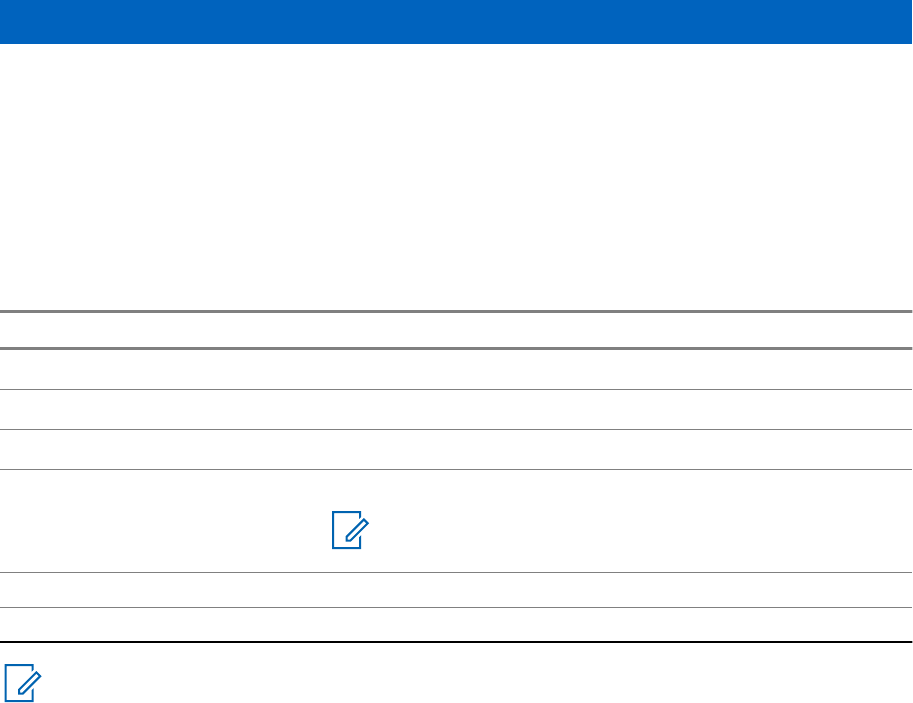
Chapter 2
Getting Started
This chapter contains basic information on how to use the radio.
Product Technical Information
Table 2: Product Technical Information
Description Value
Rated RF Power 10 W
Maximum Speaker Load 10 W at 4 Ω
Antenna Impedance 50 Ω
Ambient Temperature Range -30 °C to +60 °C
NOTICE: If the radio is in service, the surface tempera-
ture can rise up to 70 °C. Do not touch the hot surface.
Operating Time Continuous/Intermittent
Enhanced Data Transfer Support of TETRA Enhanced Data Service (TEDS).
NOTICE: The communication system determines the radio transmit and receive time (operating
cycle time). During overload, or beyond the systems specifications at high ambient
temperatures, the thermal control cuts down the RF power output, which reduces the radio
coverage range.
You can attach a colorful o-ring to a radio antenna to distinguish radios from one another.
An RFID knob is available as an optional accessory which allows tracking radios easily. The
knob contains an RFID tag which can be read by handheld scanners greatly enhancing the
speed of radio identification. The knob is a retrofit option and can replace an existing volume
knob.
Getting Started
Send Feedback 23
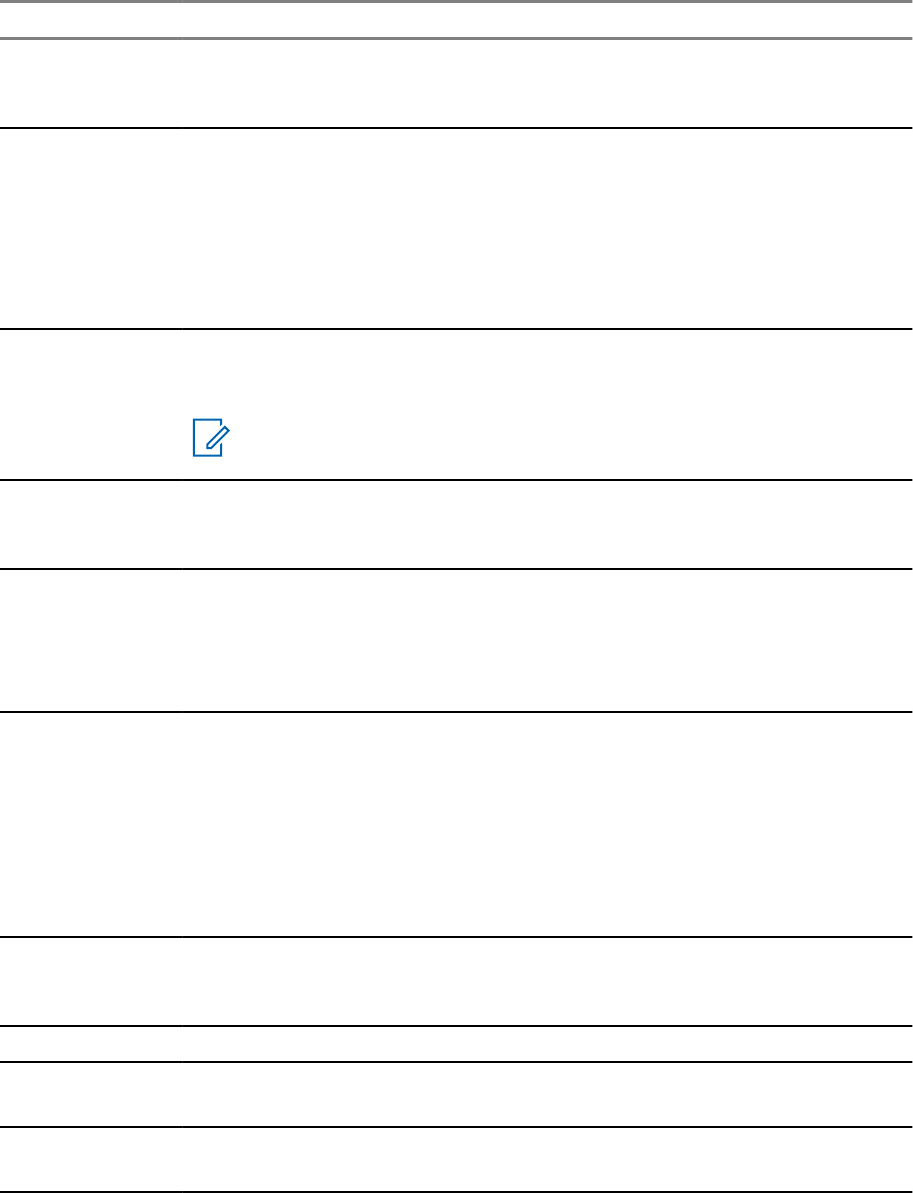
Table 3: Controls and Indicators — New Generation Control Head (NGCH) / Remote Ethernet Control
Head (RECH)
Annotation Description
1 EMERGENCY button
Press and hold EMERGENCY button to enter Emergency operation. By default, when
your radio is off, press and hold to power on in Emergency Mode.
2 ROTARY KNOB
• Press and hold to turn your radio on.
• Rotate to set the volume.
• Press and rotate to select a different talkgroup.
• Press and hold the ROTARY KNOB to lock/unlock it. Powering off also unlocks a
locked ROTARY KNOB.
3 DISPLAY
Provides alphanumeric text and images within 65,536 colors and 640 x 480 pixels
with backlighting and scalable fonts.
NOTICE: Before using your radio for the first time, remove the plastic lens
protector from the display.
4 SOFT key
Press upper or lower SOFT key, to select the option that appears on the screen next
to it.
5 ON/OFF/END/HOME key
• Press and hold to turn on/off your radio.
• Press to end calls.
• Press to return to the home screen.
6 NAVIGATION key
Press up, down, left or right NAVIGATION key for list scrolling, while moving around the
menu hierarchy, or for alphanumeric text editing.
From the home screen, press to activate one of the following:
• Down NAVIGATION key — enters Recent Calls menu item.
• Up NAVIGATION key — changes My Groups talkgroup folder.
• Left and right NAVIGATION key — toggles through the talkgroups.
7 Alphanumeric KEYPAD
Use the keypad to enter alphanumeric characters for dialing, contact entries, and
text messages.
8 LED Status Indicator
9 MOBILE MICROPHONE PORT
Provides connection for accessories such as fist microphone with PTT.
10 MENU key
Press to enter the main menu and the context-sensitive menu.
11 SEND key
Press to initiate or answer duplex calls, or send messages.
Table continued…
Chapter 2: Getting Started
Send Feedback 25

Annotation Description
Press in home screen to enter Recent Dialed Calls.
12 FUNCTION key 1
By default:
• Short press — activates/deactivates the horn and lights feature.
• Long press — adjusts backlight.
13 FUNCTION key 2
By default:
• Short press — turns the speaker on/off.
• Long press — activates/deactivates screen saver.
14 FUNCTION key 3
By default:
• Short press — adjusts backlight.
• Long press — unassigned.
15 PTT (Push-To-Talk) button
• Press and hold to talk in simplex calls or to initiate a group call, release it to listen.
16 MICROPHONE
NOTICE: While pressing the expansion PTT (on the expansion head), other PTT press on an
accessory connected to the control head is ignored. This only applies to MTM5200, MTM5400,
and MTM800 FuG.
Chapter 2: Getting Started
26 Send Feedback
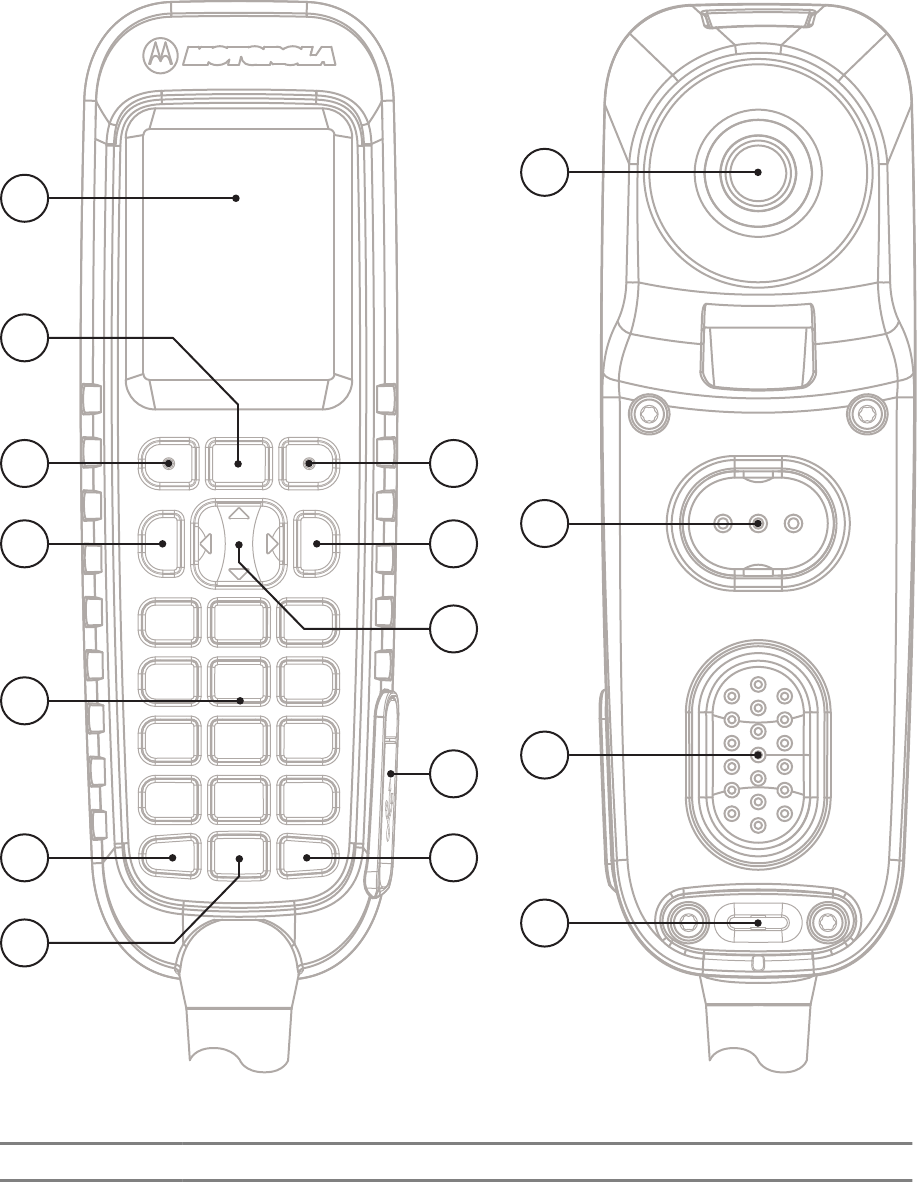
Telephone Style Control Head (TSCH)
12
13
14
15
1
2
3 3
8
9
4
5
11
7
6
10
Table 4: Controls and Indicators — Telephone Style Control Head (TSCH)
Annotation Description
1 DISPLAY
Provides alphanumeric text and images within 65,536 colors and 240 x 320 pixels
with backlighting and scalable fonts.
Table continued…
Chapter 2: Getting Started
Send Feedback 27
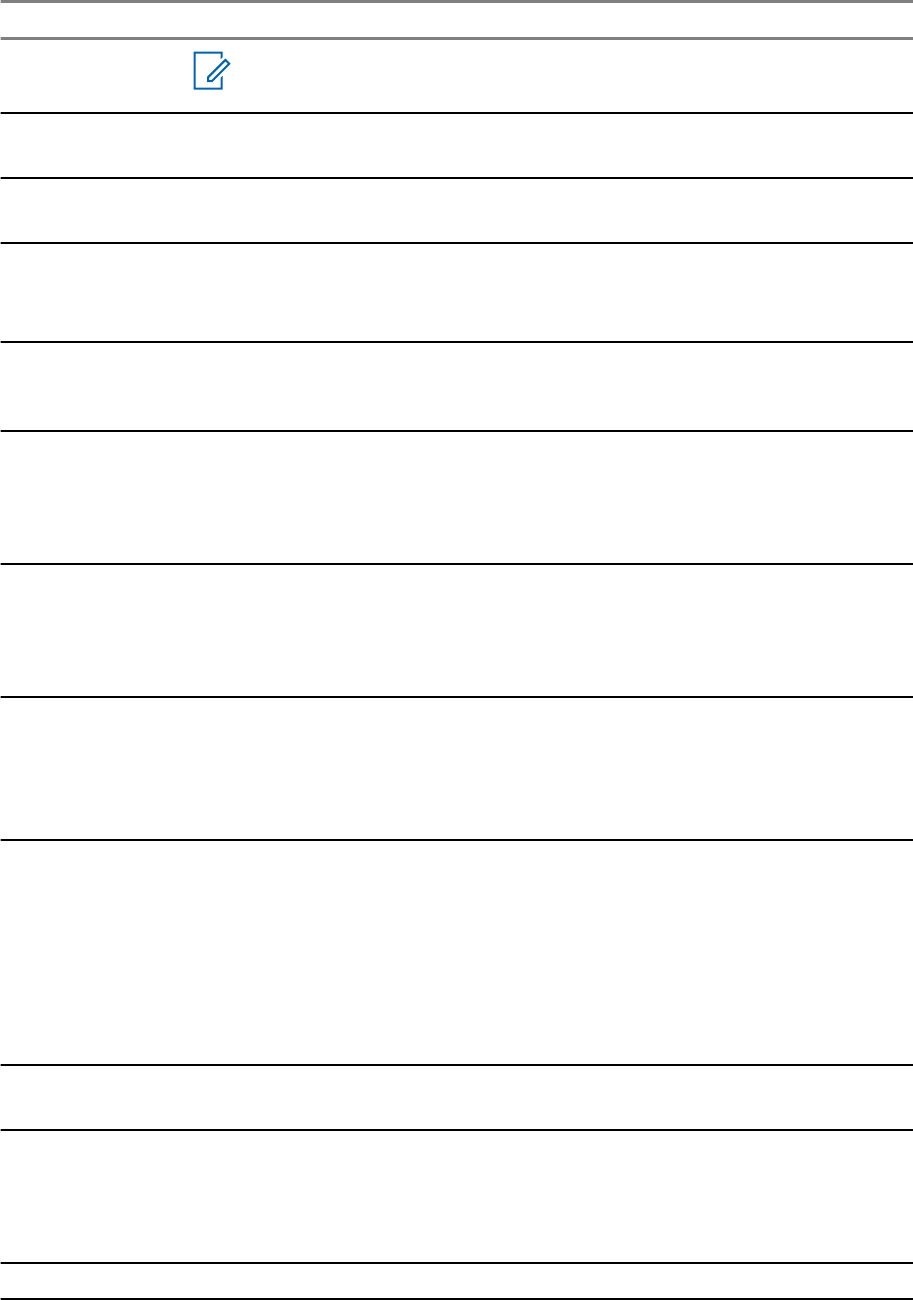
Annotation Description
NOTICE: Before using your radio for the first time, remove the plastic lens
protector from the display.
2 MENU key
Press to enter the main menu and the context-sensitive menu.
3 SOFT keys
Press left or right SOFT key, to select the option that appears on the screen above it.
4 SEND key
Press to initiate or answer duplex calls, or send messages.
Press in home screen to enter Recent Dialed Calls.
5 Alphanumeric KEYPAD
Use the keypad to enter alphanumeric characters for dialing, contact entries, and
text messages.
6 FUNCTION key 1
By default:
• Short press — activates/deactivates the horn and lights feature.
• Long press — adjusts backlight.
7 FUNCTION key 2
By default:
• Short press — turns the speaker on/off.
• Long press — activates/deactivates screen saver.
8 ON/OFF/END/HOME key
• Press and hold to turn on/off your radio.
• Press to end calls.
• Press to return to the home screen.
9 NAVIGATION key
Press up, down, left or right NAVIGATION key for list scrolling, while moving around the
menu hierarchy, or for alphanumeric text editing.
From the home screen, press to activate one of the following:
• Down NAVIGATION key — enters Recent Calls menu item.
• Up NAVIGATION key — changes My Groups talkgroup folder.
• Left and right NAVIGATION key — toggles through the talkgroups.
10 MICRO USB PORT
Provides connection between the radio and a computer.
11 FUNCTION key 3
By default:
• Short press — adjusts backlight.
• Long press — unassigned.
12 EARPIECE
Table continued…
Chapter 2: Getting Started
28 Send Feedback
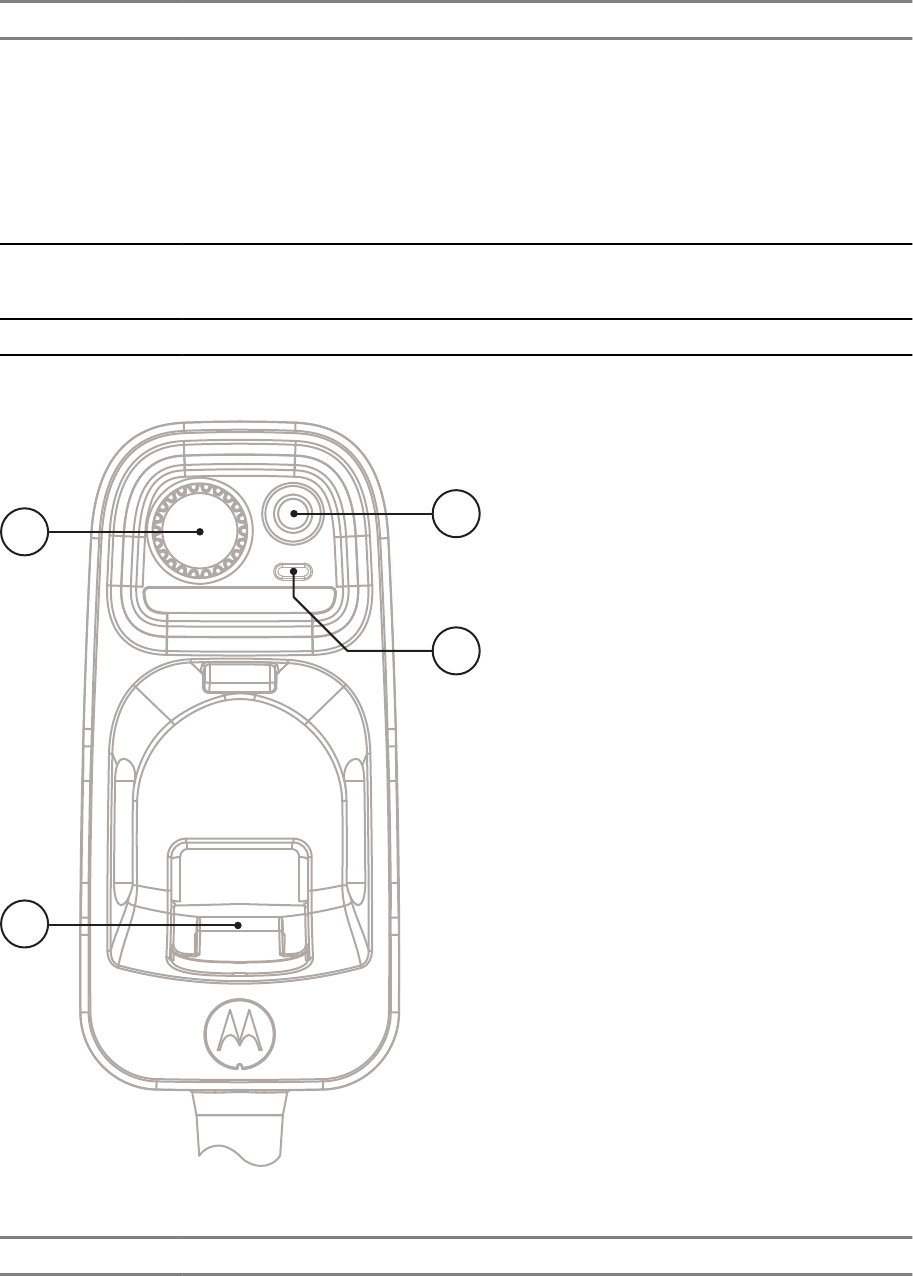
Annotation Description
13 Upper PTT (Push-To-Talk) button
By default, this PTT button is disabled. However, your service provider can assign
one of the following functions to it:
• Upper PTT button works in the same way as the lower PTT button (you can use
both interchangeably).
• Upper PTT supports a roof speaker. Roof speaker allows sound to be transferred
through an external speaker connected to the transceiver.
14 Lower PTT (Push-To-Talk) button
• Press and hold to talk in simplex calls or to initiate a group call, release it to listen.
15 MICROPHONE
Cradle
16
17
18
19
Table 5: Controls and Indicators — Cradle
Annotation Description
16 ROTARY KNOB
Table continued…
Chapter 2: Getting Started
Send Feedback 29
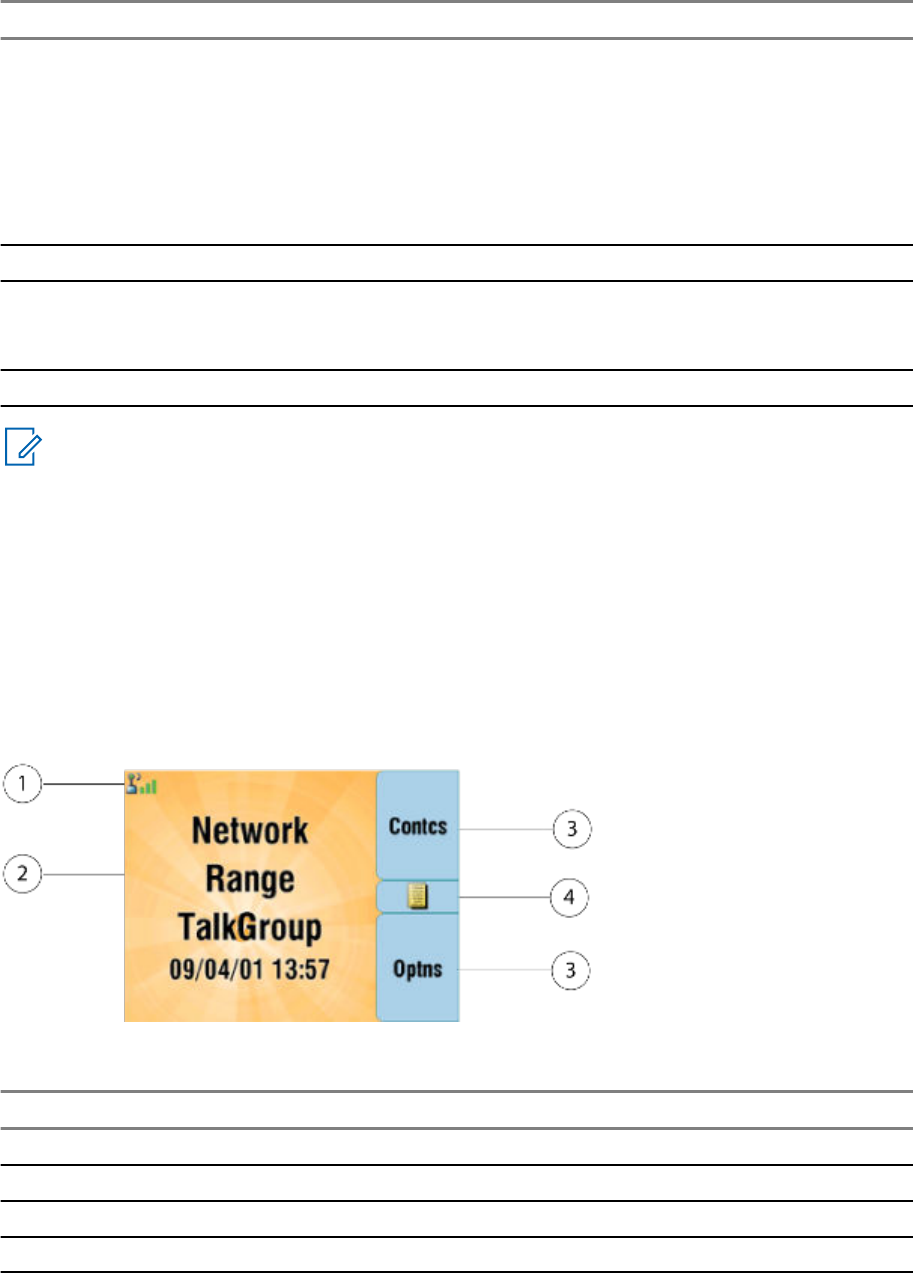
Annotation Description
• Press and hold to turn your radio on.
• Rotate to set the volume.
• Press and rotate to select a different talkgroup.
• Press and hold the ROTARY KNOB to lock/unlock it. Powering off also unlocks a
locked ROTARY KNOB.
• Press to make the ROTARY KNOB operate like left/right navigation keys.
17 HOOK
18 EMERGENCY button
Press and hold EMERGENCY button to enter Emergency operation. By default, when
your radio is off, press and hold to power on in Emergency Mode.
19 LED Status Indicator
NOTICE:
• It is recommended to turn off the terminal before connecting any of the accessories.
• A detailed list of compatible accessories is included in Accessory Leaflet, part number:
68015000182. To obtain the document, contact your service provider.
Related Links
Interactions between Control Heads on page 117
Dual Control Head on page 116
Display
This section presents the radio's default home screen elements.
Table 6: Display
Annotation Description
1 Status icon area
2 Text display area
3 SOFT key area
4 MENU/Context sensitive icon
The color of the SOFT key area changes according to the mode the radio is in.
Chapter 2: Getting Started
30 Send Feedback

Table 7: Colors of the SOFT Key Area
Color Mode or State
Light blue Normal TMO and DMO Modes
Light red Emergency Mode or Disaster Alert Call
Olive Local Site Trunking Mode
Yellow Call Out — Standby
Red Call Out — Alert
Green Call Out — Accepted
Blue Radio Messaging Service (RMS)
Grey Radio User Assignment (RUA) — Limited service
Related Links
Display on page 93
Display Orientation
The display on the Telephone Style Control Head can rotate, which increases its readability and
facilitates operation. When a single TSCH or a combination of TSCH and RECH (Remote Ethernet
Control Head) is used, the following display orientation is possible:
• When the TSCH is off-hook, its display orientation is portrait.
• When the TSCH is on-hook, its display orientation can take one of the following positions
(depending on your service provider configuration):
- Fixed portrait
- Clockwise
- Counter clockwise
Configurable Idle Screen
Your service provider can configure the information that is displayed on the idle screen below the
status icon area. Depending on the radio configuration and services supported, the following
information can be displayed:
• Network alias
• Range alias
• Talkgroup alias
• Time and date
• Home mode display
• RMS/FMS
• ISSI
• Radio status
• Audio profile name
• Radios with the gateway feature enabled: gateway TMO zone, gateway TMO talkgroup, gateway
DMO zone, gateway DMO talkgroup
Chapter 2: Getting Started
Send Feedback 31
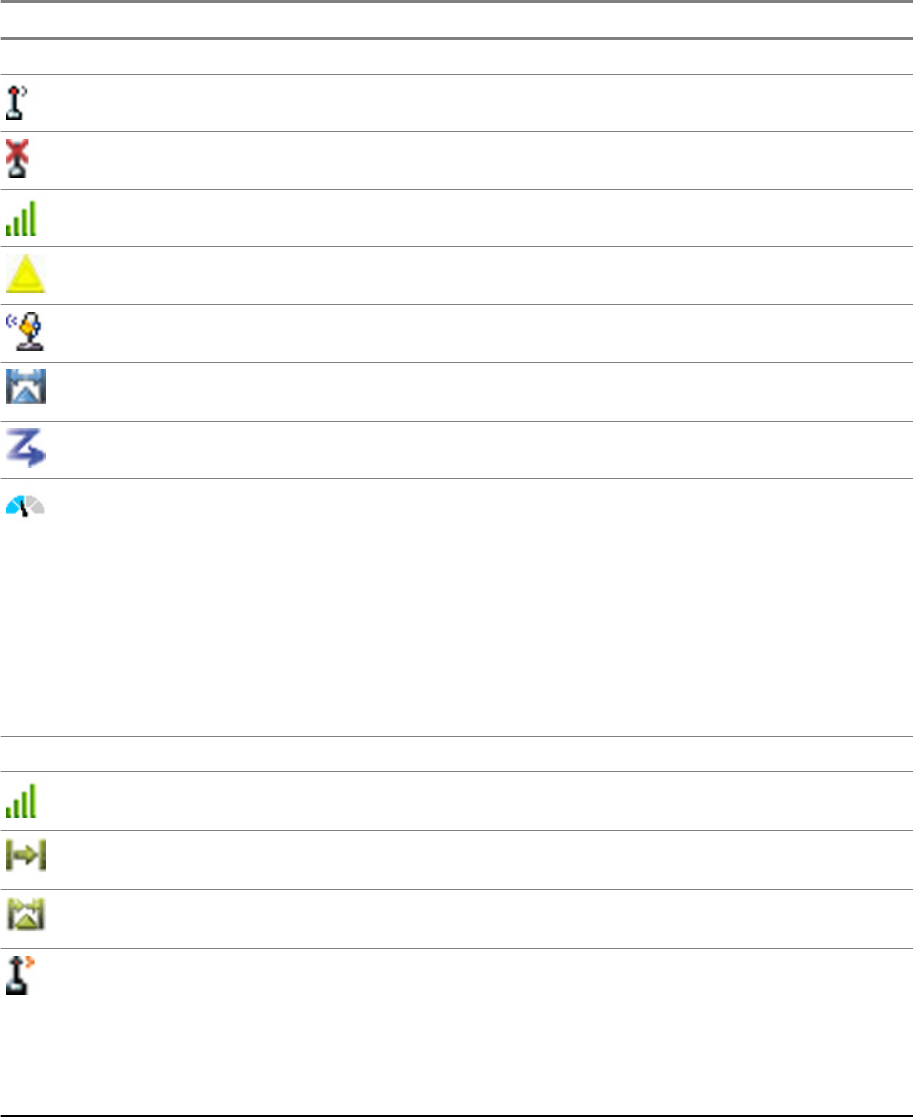
Status Icons
Status icons appear when your radio is engaged in certain activities or when you have activated certain
features.
Table 8: Status Icons
Icon Description
Trunked Mode Operation
In Service
No Service
Signal Strength – The more bars, the stronger the signal.
Migration — Displayed when your radio is registered to the foreign network.
Broadcast Call — Displayed when the radio is in the Broadcast Call.
Gateway Mode — Displayed when the radio is switched to work as a gateway in
Gateway Mode.
Scan — Indicates talkgroup scanning is activated in the radio.
Packet Data / Multi-Slot Packet Data (MSPD) / TETRA Enhanced Data Services
(TEDS) — The more blue sections on the icon, the faster the data transfer. Possible
five states:
• Four gray sections: context activated – data idle
• One blue (from the left): Packet Data active
• Two blue (from the left): Multi Slot Packet Data active
• Three blue (from the left): TEDS 25 kHz active
• Four blue: TEDS 50 kHz active
Direct Mode Operation
Direct Mode Call — Displayed when the radio is receiving a Direct Mode call. The
more bars, the stronger the signal.
Direct Mode — Displayed when the radio is in Direct Mode (radio-to-radio communi-
cation).
Repeater Mode — Displayed when the radio is switched to work as a repeater in
Repeater Mode.
DMO Gateway Communication Mode — Indicates that gateway is selected. The
icon has the following states:
• Solid — while the radio is synchronized with the gateway.
• Blinking — while the radio is not synchronized or during attachment.
• No icon — during a radio to radio and repeater call.
Table continued…
Chapter 2: Getting Started
32 Send Feedback
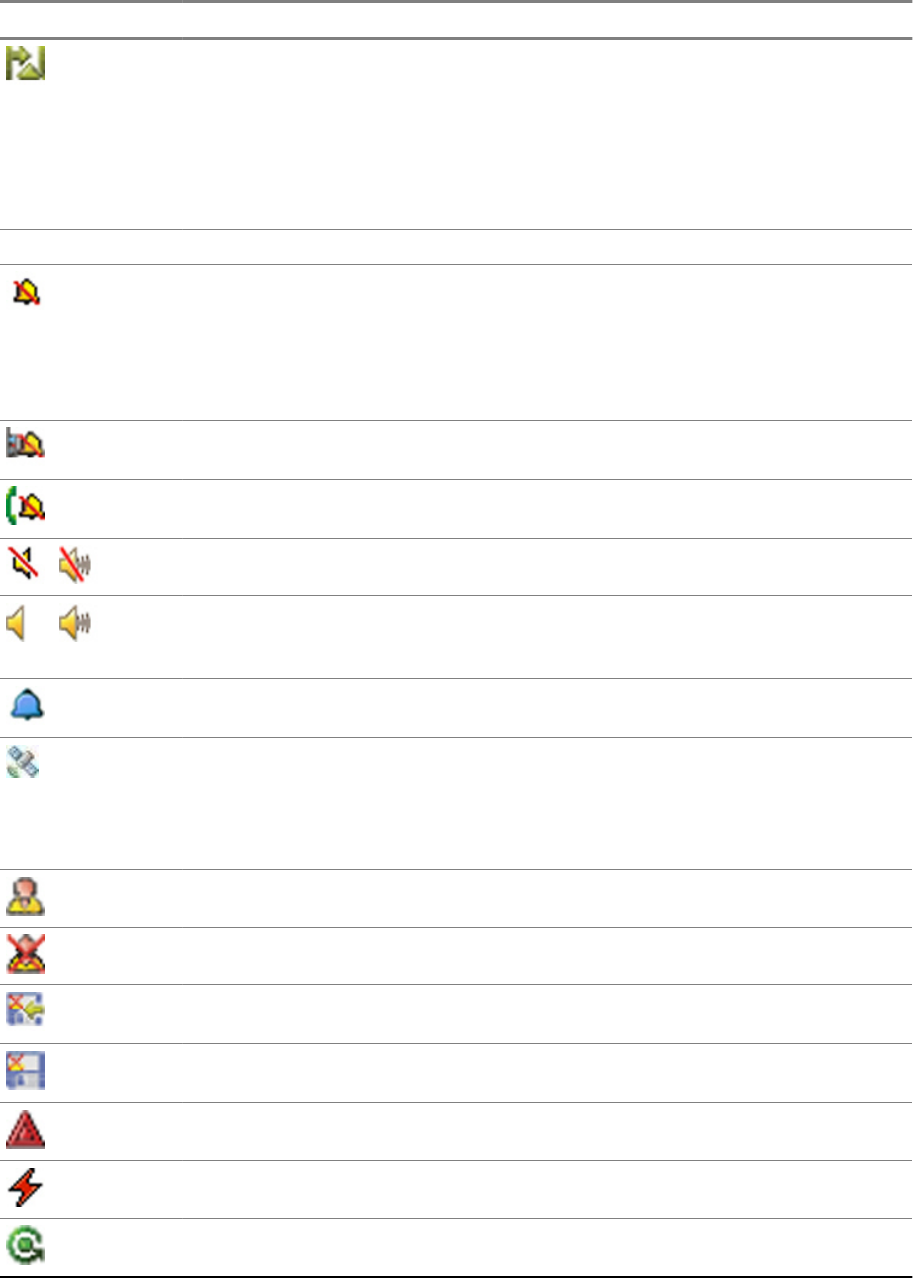
Icon Description
DMO Repeater Communication Mode — Displayed when the Repeater or GW +
Rep option in DMO Mode is selected. This icon has the following states:
• Solid — while the radio has detected the repeater (for example when the radio
receives a presence signal).
• Blinking — while the radio has not detected the repeater or during attachment.
• No icon — during a radio to radio and gateway call.
General Icons
All Tones Off and Duplex and Simplex Ring Muted — Indicates that all alert tones
are off and both duplex an simplex ring volume is set to 0.
• Volume is set to 0 (when Volume Adj. Mode is set to Common).
• Both simplex and duplex ring volume is set to 0 (when Volume Adj. Mode is set
to Individual).
Simplex Ring Muted — Indicates that simplex ring volume is set to 0 and duplex ring
volume is set to more than 0.
Duplex Ring Muted — Indicates that duplex ring volume is set to 0 and simplex ring
volume is set to more than 0.
/
Speaker Off — Indicates that audio will not sound through the speaker.
/
Audio Profile Selected — Indicates that an audio profile associated with a particular
icon is active. For details on audio profiles available on the radio, contact your serv-
ice provider.
Horn and Lights — Indicates that an external alarm (for example, horn and lights) is
activated.
GPS Icon
• Solid - the radio has a location fix
• Blinking - the radio is acquiring a location fix. This is an optional setting and may
not be enabled on your radio.
RUI Logged on — Indicates that you are logged on into the radio.
RUI Pseudo Log On — Indicates that you are in pseudo logged on state.
RUI Packet Data — Indicates Pseudo Log On state when the Packet Data feature is
activated and active data session is in progress.
RUI Packet Data — Indicates Pseudo Log On state when the Packet Data feature is
activated and the external device sets up data connection with the radio.
Emergency — Appears while the radio is in Emergency Operation.
Disaster Alert Call — Appears while the radio is in the Disaster Alert Call.
List Scrolling — Displayed to indicate that the ROTARY KNOB is in list scrolling mode.
Table continued…
Chapter 2: Getting Started
Send Feedback 33
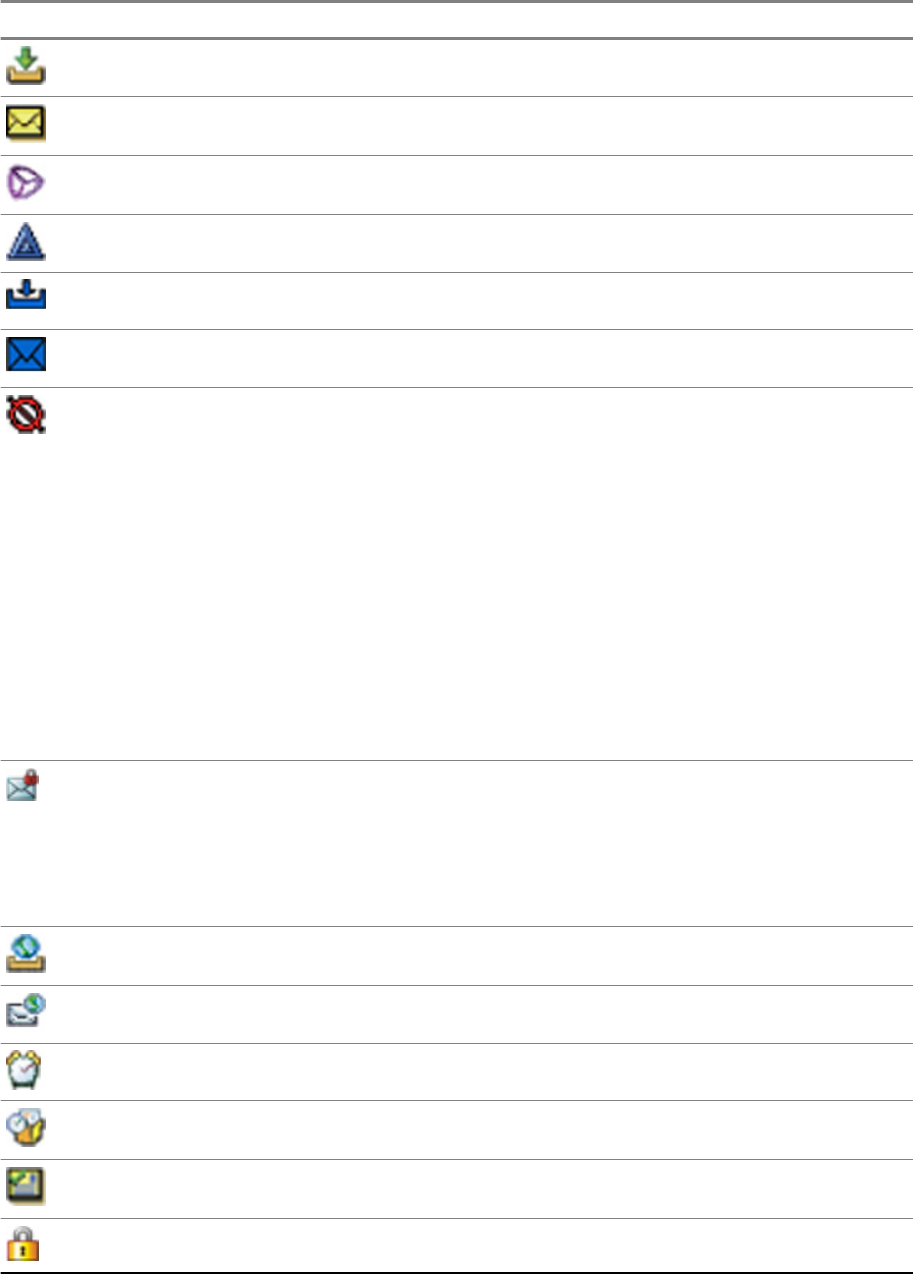
Icon Description
New Message Has Arrived — Indicates a new message just arrived.
New Message(s) in Inbox — Indicates that you have unread messages in your In-
box.
Unread (New) WAP Message — Indicates that new page was loaded to the brows-
er.
Call-Out — Indicates Call-Out alert.
Call-Out Alert Arrived — Indicates a receipt of a new Call-Out message.
Call-Out Alert Unread — Indicates unread alert in the CO Box.
End-to-End Encryption (E2EE)
Solid, when the E2EE is enabled
• for the selected talkgroup,
• for the highlighted private number,
• for the manually entered private number,
• when transmitting voice in Group Calls,
• when transmitting voice in Simplex Private Calls.
Blinking, when the End-to-End Encryption is enabled
• when receiving voice in Group Calls,
• when receiving voice in Simplex Private Calls,
• during encrypted Duplex Private Calls.
SDS End-to-End Encryption
Solid, when the E2E status of an SDS message, or the E2E status of a message
recipient address.
In High Security mode, when your radio processes only the encrypted informa-
tion, this icon is always visible in when you are in the messages menu (for exam-
ple, Inbox).
Unread (New) WAP Message — Indicates that you have not entered WAP Box
since last WAP message was received (Blinks when the priority is high).
WAP Message Icon — Displayed next to the priority in the message list view.
WAP Message Time — Displayed next to the create date in the message list view.
WAP Message Expiration — Displayed next to the expiry date in the message list
view.
WAP Message Title Icon — Displayed next to the title along with the text in the mes-
sage list view.
Keys Locked — Indicates that keys are locked.
Table continued…
Chapter 2: Getting Started
34 Send Feedback
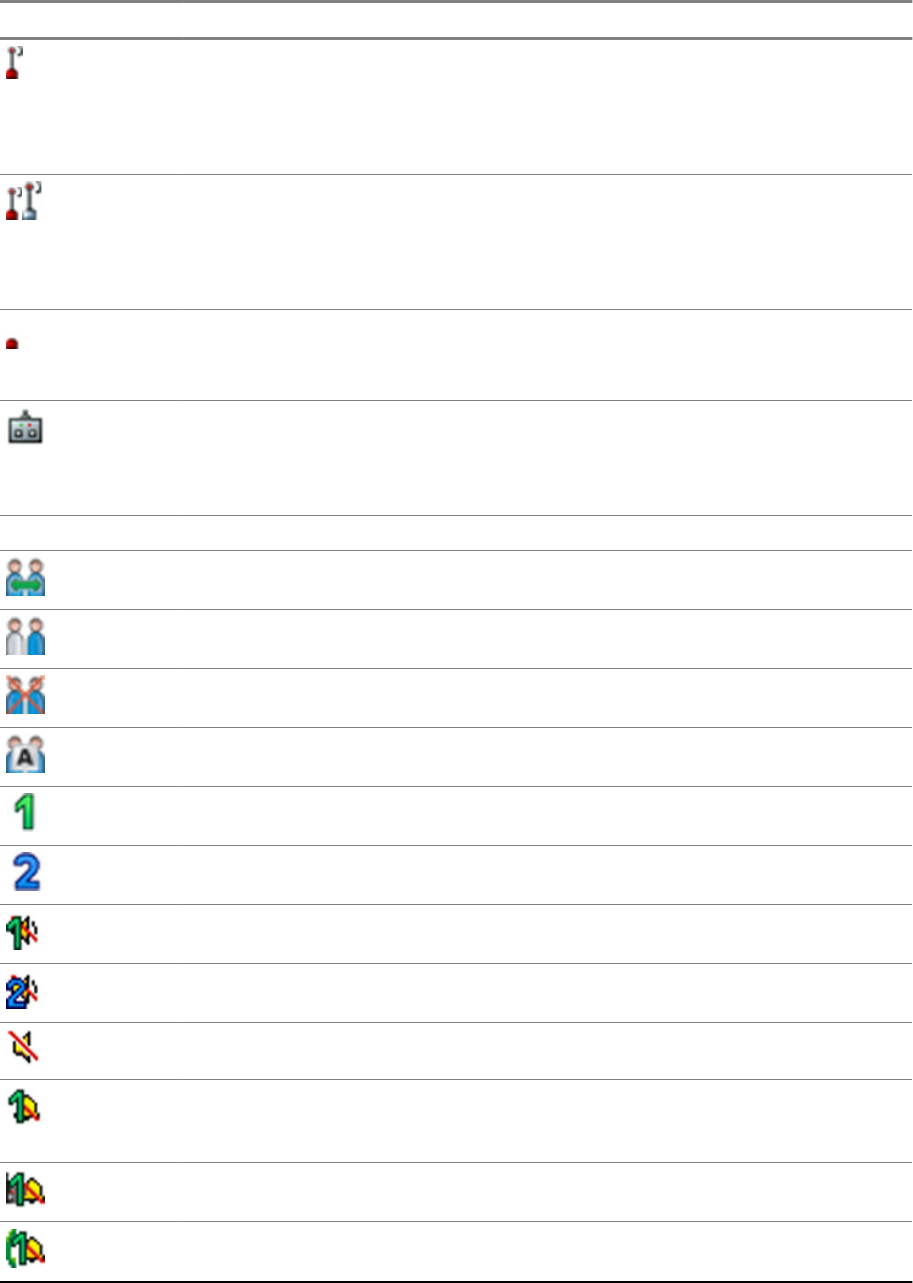
Icon Description
Non Secured Call — Air Encryption Unavailable
Blinking, indicates that Air Encryption is not available when the radio:
• Is in the Local Site Trunking Mode.
• Attempts to connect to a gateway.
Not Secured Call — Air Encryption Unavailable
Alternately blinking, indicates that Air Encryption is not available when the radio:
• Is in TMO Mode.
• Communicates through a gateway.
Not Secured Call — Air Encryption Unavailable
Blinking, indicates that Air Encryption is not available in DMO Mode. The icon ap-
pears after the PTT button is pressed.
Remote Control
Indicates that the radio is being remotely controlled and some commands are be-
ing executed in the background. For example, when the radio is controlled via
special SDS messages or triggered to send a GPS location report.
Enhanced Dual Control Head
Dual Control Head — Indicates that Dual Control Head feature is enabled, and both
control heads are connected to the transceiver.
Single Control Head — Indicates that Dual Control Head feature is enabled, but only
one control head is connected to the transceiver.
Link Error — Indicates that connection between the control head and the transceiver
has been lost, for example, due to an error.
Key Press Token — In Dual Control Head operation, blinking icon indicates that key
press token is reserved by one of the control heads.
CH1 — Indicates that particular activities/settings apply to Control Head 1. Control
Head 1 is a control head connected to port 1 on the expansion head.
CH2 — Indicates that particular activities/settings apply to Control Head 2. Control
Head 2 is a control head connected to port 2 on the expansion head.
Speaker 1 Off (Low Audio) — Indicates that audio will not sound through the speak-
er of the Control Head 1.
Speaker 2 Off (Low Audio) — Indicates that audio will not sound through the speak-
er of the Control Head 2.
Speakers Off (Low Audio) — Indicates that speakers of both control heads are off.
All Tones Off/Duplex and Simplex Ring Muted — Indicates that all alert tones are off,
or both simplex ring volume is set to 0 and duplex ring volume is set to 0. Applicable
to Control Head 1.
Simplex Ring Muted — Indicates that simplex ring volume is set to 0 and duplex ring
volume is set to more than 0. Applicable to Control Head 1.
Duplex Ring Muted — Indicates that duplex ring volume is set to 0 and simplex ring
volume is set to more than 0. Applicable to Control Head 1.
Table continued…
Chapter 2: Getting Started
Send Feedback 35

Icon Description
All Tones Off/Duplex and Simplex Ring Muted — Indicates that all alert tones are off,
or both simplex ring volume is set to 0 and duplex ring volume is set to 0. Applicable
to Control Head 2.
Simplex Ring Muted — Indicates that simplex ring volume is set to 0 and duplex ring
volume is set to more than 0. Applicable to Control Head 2.
Duplex Ring Muted — Indicates that duplex ring volume is set to 0 and simplex ring
volume is set to more than 0. Applicable to Control Head 2.
Related Links
Air Encryption on page 85
Powering On the Radio
Procedure:
1Press and hold ON button.
2Your radio performs a self-check and registration routine.
3After successful registration, your radio is in service.
NOTICE: Your radio powers on without visible and audible notification if Covert Mode is
activated.
Unlocking Your Radio
Your radio may be locked at power up. To unlock it after powering on, enter the code at the prompt.
Your radio enters the default home display.
NOTICE: The unlock code is originally set to 0000. Your service provider may change this
number before you receive your radio.
Related Links
PIN Protect on page 83
Changing PIN Codes on page 84
Writing Text on page 41
Unblocking Your Radio
Prerequisites: You blocked your radio by entering incorrect PIN code for three times (by default).
Procedure:
1Radio displays Unit BlockedEnter PUK.
2Enter 8–digit PUK (Personal Unblocking Key) number.
NOTICE: The PUK is an eight-digit master code provided by your service provider.
3Enter the new PIN code twice.
Locking/Unlocking the Keys/Buttons
Press MENU key and * key.
Chapter 2: Getting Started
36 Send Feedback

NOTICE: The EMERGENCY button is not locked. Entering Emergency Mode unlocks all keys.
Related Links
Keylock Setup on page 84
External SIM Card Priority
When you insert a SIM card into the external SIM reader, it gets priority over the internal SIM card. The
internal SIM card remains deactivated as long as an external SIM card is plugged in.
Entering TMO / DMO Mode
Procedure:
1From the home screen, press Optns.
2Select Trunked Mode / Direct Mode.
Related Links
Selecting Network Operation Mode on page 109
Networks on page 109
Transmit Inhibit Mode
The Transmit Inhibit Mode is a mode in which the radio sends no radio transmissions. It is
recommended to activate the mode in RF sensitive areas, for example hospitals, airplanes, where
safety can be jeopardized due to transmission radiation.
To activate, select MENU → Networks → TXI Mode → Activate.
In this mode, the radio does not transmit under any circumstances except for the Emergency Calls. All
the functions and keys which cause transmission, for example registration to the network, changing
talkgroup or folder, sending SDS messages, or pressing the PTT button are disabled. Any transmission
trial causes the radio to display Not Allowed In TXI Mode notification and to play a tone.
Your radio can still receive:
• Group calls.
• Messages — stored in the Inbox.
• Private call attempts — stored in the Missed Calls list, without the option to respond.
When no danger to safety exists anymore (for example, you leave the RF sensitive area), you can
deactivate the Transmit Inhibit Mode and the radio returns to standard operation.
You can deactivate the mode by selecting MENU → Networks → TXI Mode → Deactivate, pressing
One-Touch button, or implicitly when initiating an Emergency Call.
NOTICE: RF Transmissions from the radio are prevented under the following conditions:
• TXI Mode is activated.
• The radio is turned off.
On entering or exiting the transmit inhibit mode, when the radio is camped on a cell, it sends a
specially designated SDS status message. This SDS message indicates to the SwMI that the radio is
entering or exiting transmit inhibit mode.
Mobility procedures that do not require the radio to send an uplink transmission are performed except
for cell reselection.
Chapter 2: Getting Started
Send Feedback 37
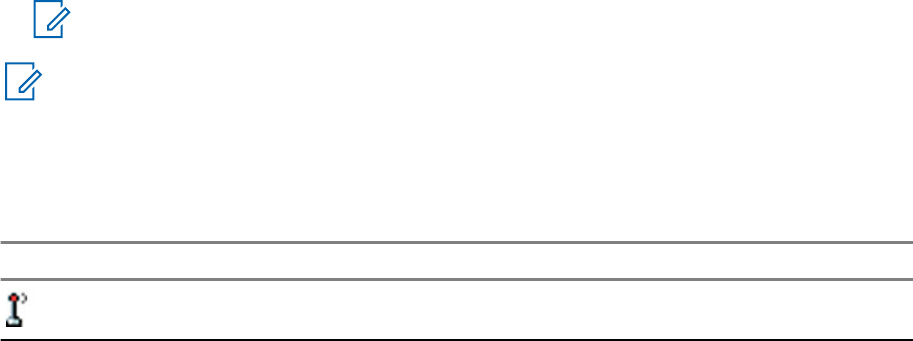
In transmit inhibit mode the radio joins group calls for any group that the radio is monitoring, but the
transmitting on that call is still prohibited.
The radio also displays any incoming SDS messages to the user. The missed call feature is active in
the transmit inhibit mode and allows checking what calls were missed. However, the radio attempts to
prevent call setup retransmission from being recorded as separate calls.
If you initiate an emergency call, the radio immediately leaves transmit inhibit mode and attempts to
start the emergency call if the radio is in service.
If the radio is turned off in the transmit inhibit mode, on turning on the radio asks whether to exit the
transmit inhibit mode. If you choose No, the radio turns off.
Selecting Talkgroups
From the home screen, use one of the following methods:
• Press left or right NAVIGATION key. Press Select to confirm.
• Select Optns → TG by abc. Enter a talkgroup name and select the talkgroup name from the list.
• Select Optns → TG by Folder. Select a folder and then a talkgroup name.
• Press ROTARY KNOB and rotate it until the required talkgroup name is displayed. Press Select to
confirm.
NOTICE: If the ROTARY KNOB mode is set to Scroll, then you do not need to press it to enter
the scrolling mode.
NOTICE: Your radio can have an access up to three levels of the folder structure.
Talkgroup Icon Selection
Table 9: Talkgroup Icon
Icon Description
Displayed when the talkgroup is from a different network than the one currently se-
lected.
Using Timed Talkgroup Change
This feature allows you to switch a selected talkgroup between the currently selected talkgroup and a
predefined talkgroup (TMO or DMO), making the predefined talkgroup the selected talk group for a
predefined time by using a One-Touch button. After the timer expires, your radio returns to the
previously selected talkgroup.
Prerequisites: Timed Talkgroup Change is assigned to a One-Touch button.
Procedure:
1Press and hold and hold the One-Touch button.
2Your radio switches the selected talkgroup to the predefined talkgroup for a predefined amount
of time.
During the predefined time the radio initiates or joins group communication (SDS, status SDS, or
call) on the predefined talkgroup as the selected talkgroup.
Your service provider can assign a function to the second press of the One-Touch button to:
• Return to previously selected talkgroup
Chapter 2: Getting Started
38 Send Feedback

• Restart the predefined time
• No action
3When the timer expires (potentially after being restarted a number of times) the radio switches to
the previously selected talkgroup.
Activating Talkgroup Scanning
When and where to use: If you want to monitor any TMO Group Call in the defined talkgroup list.
Procedure:
1From the home screen, press the MENU key.
2Select Group Setup → Scan → Scanning.
3Select Select List and then a list name.
Your radio displays list name Selected.
4Select Scanning → On.
Your radio is scanning on the predefined scan list.
Related Links
Scan on page 102
Broadcast Call
The Broadcast Group Call (also called Site Wide Call) is a high-priority group call from the console
operator (or dispatcher) to all users located at one or more sites. The radios are configured to monitor
a Broadcast Call, but you cannot talk back. The call can be received as a normal Broadcast Call or an
Emergency Broadcast Call. The Broadcast Call preempts an ongoing Group Call that has the same or
lower call priority.
Ambience Listening (AL) Call
This feature allows a dispatcher to make a special call that allows listening to the conversations and
background noises within the range of a particular radio’s microphone. The call is set up without any
indication to the affected radio, and any lower priority ongoing voice call or packet data transfer may be
preempted.
After accepting the call, the radio transmits in a simplex call without any action from or indication to the
user. The Ambience Listening Call automatically ends when you initiate any voice call, switch to
Emergency or TXI Mode, or send Emergency Alarm.
One-Touch Button Feature
The One-Touch Button feature allows for quick activation of functions by pressing and holding keys or
buttons assigned to those functions.
Table 10: One-Touch Button Features
Feature Description
BSI Encryption Enabled/Disabled Toggles BSI encryption feature.
Backlight Adjustment Toggles the backlight on or off.
Table continued…
Chapter 2: Getting Started
Send Feedback 39

Feature Description
Change Talkgroup Changes the talkgroup to the programmed one by your service
provider.
Change Talkgroup to the Previously
Selected Talkgroup
Changes the selected talkgroup of the radio to the talkgroup
(DMO or TMO) that was selected previously.
Covert Mode Turns on/off the Covert Mode.
Default Setting Resets all radio settings to the default ones.
Display Time Displays universal time on the home screen.
Sending of Double Push PTT (D-PTT) Sends the D- PTT tone to the currently used talkgroup.
GPS LIP Report Sends a message with the radio’s GPS location to a dedicated
address.
Hi/Low Audio Toggles high/low audio.
Horn&Lights Toggles the horn and lights indication.
HSM (Hearer Speaker Microphone)
Secondary Accessory Toggle
Activates/Deactivates the Hearer Speaker Microphone Secon-
dary Accessory.
Initiate Call-Out Fallback Alert Sends Call-Out Fallback Alert.
PABX Call Initiates a PABX call to a predefined entry in the contact list.
Phone Call Initiates a phone call to a predefined entry in the contact list.
Private Call Initiates a private call (simplex or duplex) to a predefined entry
in the contact list or to the last group call originator.
Rotary Switches Lock/Unlock Locks/unlocks the Rotary Switches.
LOG ON <-> LOG OFF RUI Asks for the credential or logs off the radio.
Screen Saver Activation Turns on/off the Screen Saver feature.
Sending Predefined Message Sends a predefined message to a dedicated address.
Sending Status Sends a dedicated status message to a dedicated address.
Sending User Defined Message Sends a user defined message to a dedicated address.
Speaker Enable/Disable Per Call Enables the loudspeaker for a duration of the ongoing call.
Timed TG Change Makes a predefined talkgroup the selected talk group for a
specified amount of time. While using the predefined talkgroup,
the second press of the One-Touch Button results in: returning
to the previously selected talkgroup, restarting the predefined
time, or no action (depending on configuration). After the timer
expires, the radio returns to the previously selected talkgroup.
TMO / DMO Switch Toggles between TMO and DMO modes.
TMO Talkgroup Scan Turns on/off the Talkgroup Scan feature in TMO Mode.
Transmit Inhibit Mode (TXI) Turns on/off the Transmit Inhibit Mode.
Turn On/Off Gateway Mode Turns on/off the Gateway Mode.
Turn On/Off Repeater Mode Turns on/off the Repeater Mode.
Your service provider can assign one-touch functions only to the side buttons and keypad keys.
Chapter 2: Getting Started
40 Send Feedback

NOTICE: If the One-Touch Button feature is enabled, the One-Touch Dial is disabled. If no
feature is assigned to a button, your radio displays an Unassigned Button message.
Terminal Temporary Disable/Enable
Your radio is provided with a feature that allows your service provider to disable it temporarily in case it
is stolen. When your radio is disabled or is powered up in disabled state, it looks and acts like it is
turned off.
If your radio is found, your service provider can enable it again over the air. After your radio is enabled,
you may resume normal operation.
Terminal Permanent Disable
Your radio is provided with a feature that allows your service provider to disable it permanently in case
it is stolen or lost. When your radio is disabled permanently, it becomes inoperable. After a Permanent
Disable your service provider cannot enable your radio. It is recommended to Permanent Disable your
radio only when you do not expect to recover it. If it is recovered then a Permanent Disable radio can
be reactivated by returning it to Motorola.
NOTICE: This is a selling feature.
During the Call
During the call, label of the right SOFT key indicates the next possible change. Accessory default setup
is:
Table 11: During the Call
Soft Key Label Audio Setting
Spkr Audio goes to the main speaker (Speaker HIGH is displayed)
Erpce Audio goes to the earpiece (Speaker LOW is displayed)
Writing Text
Every time that you see text entry screen, refer to this section.
Related Links
Unlocking Your Radio on page 36
Selecting Text Entry Modes
Prerequisites: Your radio displays the text entry screen.
Procedure:
1Press MENU → Entry Mode.
2Select one of the following:
•Primary — for entering alphanumeric characters.
•Numeric — for entering numbers only.
•Symbol — for entering symbols only.
Chapter 2: Getting Started
Send Feedback 41
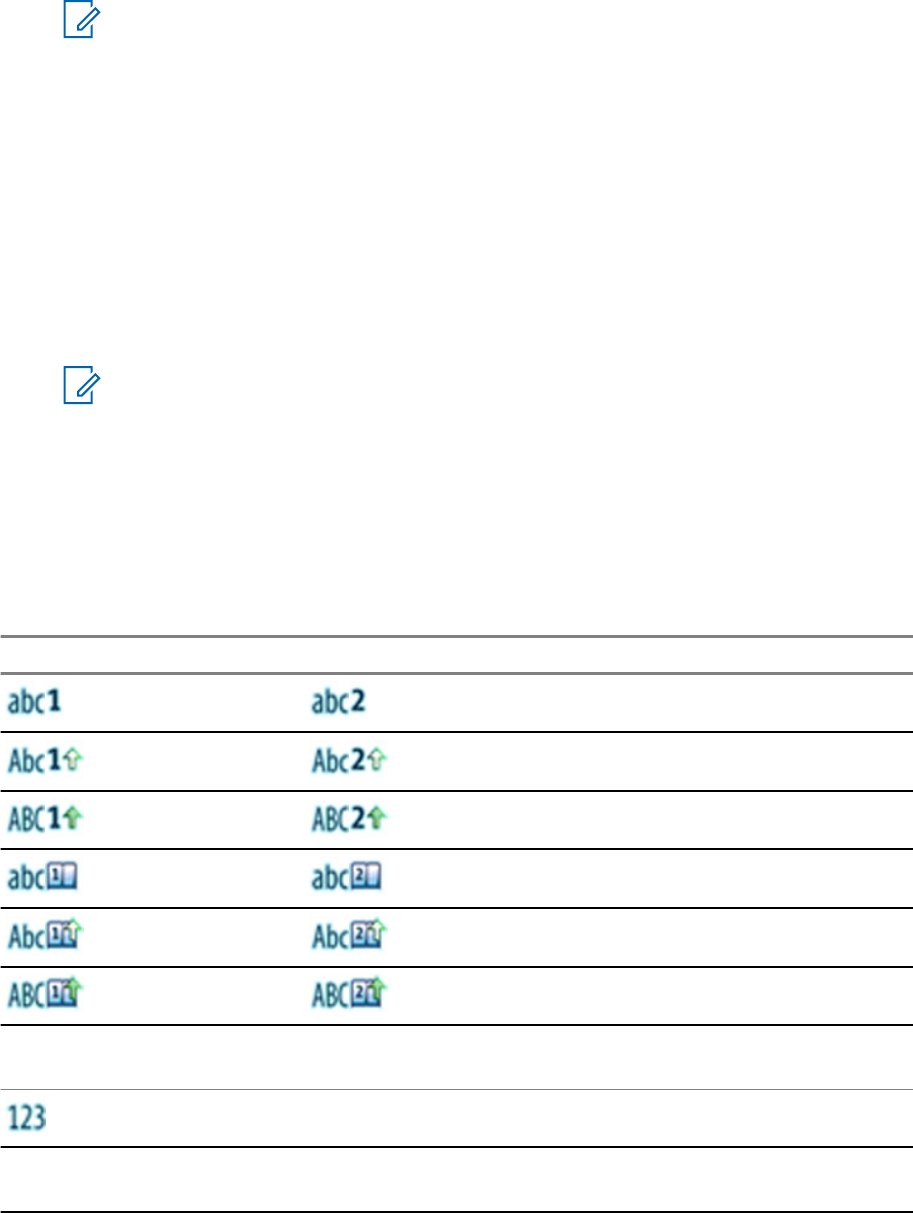
•Secondary — for entering alphanumeric characters (this mode is optional and you have to
add it to the list). It is convenient when you use one language, and sometimes wish to switch
to another one.
NOTICE: In the text entry screen, you can also press # key repeatedly to toggle through
the entry modes.
Selecting Text Entry Methods and Languages
Prerequisites: Your radio displays the text entry screen.
Procedure:
1Press MENU → Entry Setup.
2Select one of the following:
•TAP — Enter letters, numbers, and symbols by pressing an alphanumeric key one or more
times.
•iTAP — Let the radio predict each word as you press an alphanumeric key.
NOTICE: You can use these methods in the languages programmed in the radio.
Text Entry Icons
In the text entry screen, icons tell you which text entry mode and method you are using. A character
counter displayed on the text entry icon, indicates the amount of characters that can be entered.
Press the # key to toggle through the text entry modes.
Table 12: Text Entry Screen Icons
Primary Icon Secondary Icons Description
TAP — no capitals
TAP — capitalise first letter only
TAP — all capitals
iTAP — no capitals
iTap — capitalise first letter only
iTap — all capitals
Numeric Icon Description
Enter numbers.
Symbolic Icon Description
Table continued…
Chapter 2: Getting Started
42 Send Feedback
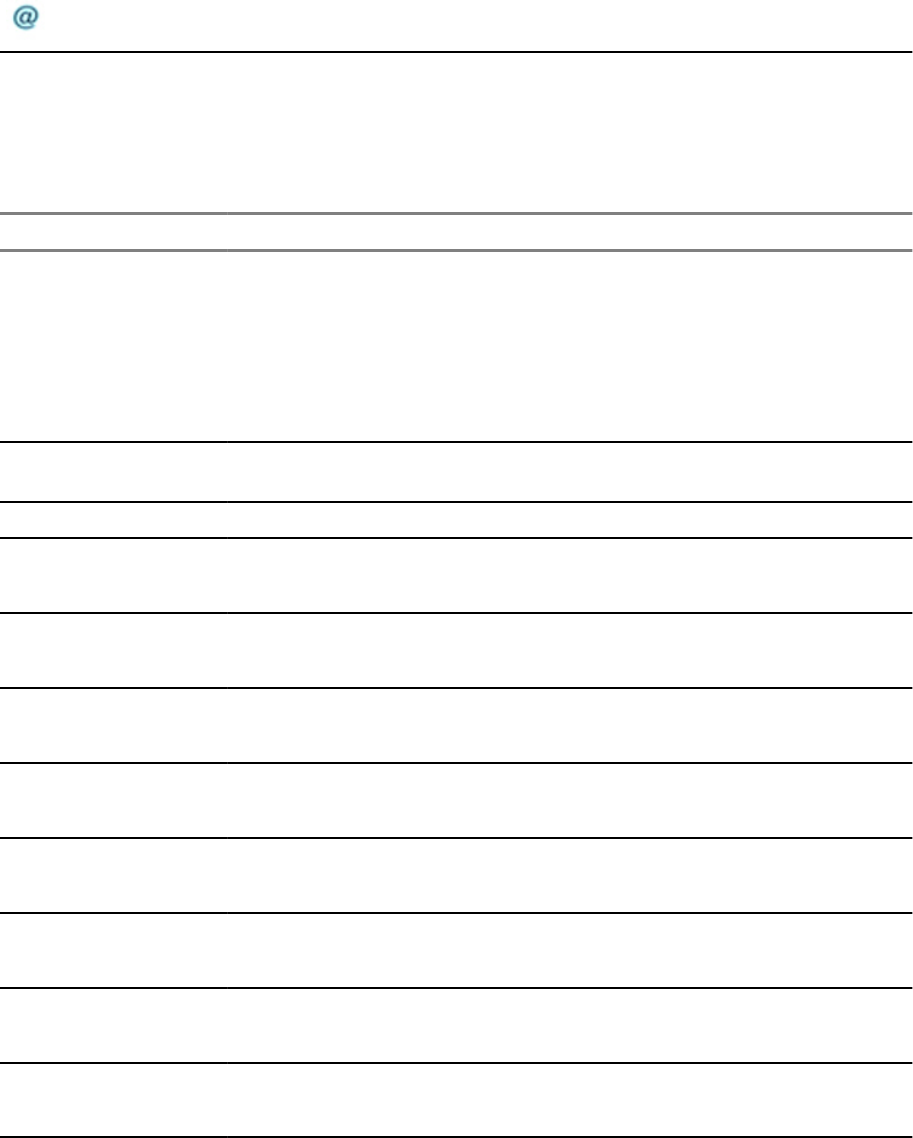
Enter punctuation and symbols.
Keys Usage
List of keys and characters in Alphanumeric Mode (TAP/iTAP).
Table 13: Keys Usage
Key Alphanumeric Mode (TAP/iTAP) Symbol Mode
0 to 9 keys Numeric Mode:
• Press to enter digit at insertion point.
• Press and hold any numeric key to enter
TAP alphanumeric mode.
• To exit TAP alphanumeric mode, press and
hold any numeric key.
0 key Press to cycle through single shift, caps lock,
and lower case.
+ - × * / \ [ ] = < > § #
1 key . , ? ! 0 1 @ ’ ” - ( ) / : _ ; + & % × * = < > € £ $ ¥ ¤ [ ] { } \ ~ ^ ¿ ¡ § #
2 key A B C 2
a b c 2
@ _ \
3 key D E F 3
d e f 3
/ , ;
4 key G H I 4
g h i 4
” & ’
5 key J K L 5
j k l 5
( ) [ ] { }
6 key M N O 6
m n o 6
¿ ¡ ~
7 key P Q R S 7
p q r s 7
= < >
8 key T U V 8
t u v 8
€ £ $ ¥ ¤
9 key W X Y Z 9
w x y z 9
# % *
Chapter 2: Getting Started
Send Feedback 43

Table 14: Other Keys
Key Description
Any numeric key • In TAP press any key to reject word completion and continue with text entry
A new completion will be displayed, if available, after the time-out for TAP
expires.
• Press and hold to enter Numeric mode from TAP or iTAP alphanumeric.
* key • Press to insert a space.
• In TAP press to dismiss a word completion and insert a space.
• Enter a newly created word into the user dictionary.
• Press and hold to enter a carriage return.
# key • Press once to cycle through all entry modes (Symbol, Numeric, Primary,
and Secondary (if configured).
• Press and hold to return to the default entry mode.
Select Press to select the highlighted choice and place it in the main text area.
Delete • Press once to delete the last entered character.
• Press and hold to clear the entire main text area.
Up NAVIGATION key • In TAP press to reject word completion and scroll up.
• In TAP press to change previously entered small letter to capital.
Down NAVIGATION key • In TAP press to reject word completion and scroll within the text area.
• In TAP press to change previously entered capital letter to small.
Left NAVIGATION key • Press to navigate to the left. Press and hold to repeat.
• In TAP, if a word completion is available, press to reject the completion.
Right NAVIGATION key • Press to navigate to the right. Press and hold to repeat.
• In TAP if a word completion is available, press to accept the word.
MENU If a context-sensitive menu is active, opens the Context Sensitive Menu.
Writing in iTAP Alphanumeric
Prerequisites: Your radio displays the text entry screen.
When and where to use: It allows you to write quicker. For example, try to write David 232!
Procedure:
1Press MENU → Entry Setup → Prim..
2Select iTAPEnglish and press Back.
3Press MENU → Entry Mode.
4Select Primary.
5Press 3 key.
The alternative row opens and shows D E F 3.
Chapter 2: Getting Started
44 Send Feedback

6Continue entering the letters by pressing one key for each letter. Press 2, 8, 4, and 3 keys.
NOTICE: Automatic shift to upper case is used at the beginning of a message, after
punctuation followed by space, or for the first letter of a word created as a new contact
entry.
The alternative row highlights David.
7Press * key.
8Press 2 key and scroll the alternative row by pressing right NAVIGATION key to reach 2.
It automatically changes the entry mode to Numeric.
9Press 3 and 2 keys.
10 Press and hold 1 key until 0 at the end changes to ..
The alternative row highlights 232..
11 Scroll the alternative row by pressing the right NAVIGATION key to reach the required symbol.
12 Press Select.
You have entered David 232!.
Writing in TAP Alphanumeric
Prerequisites: Your radio displays the text entry screen.
Procedure:
1Press MENU → Entry Setup → Seco..
2Select TAPEnglish and press Back.
3Press MENU → Entry Mode.
4Select Secondary.
5Press the key labeled with the desired character, once for the first character, twice for the
second, and so on.
Example: To enter letter s, press 7 key four times. To enter number 7, press the 7 key five
times. If you do not press a key for a few seconds, the character is accepted, and the cursor
moves to the next position.
Word Locking
Prerequisites: Your radio displays the text entry screen.
When and where to use: To add the words that are not in the dictionary.
Procedure:
1Press MENU → Entry Setup.
2Select iTAPEnglish.
3Try to enter the word. Scroll the alternate line for a word option. Each option is successively
highlighted and partially locked.
4Enter the second part of the word. The first part remains unchanged (locked). The newly entered
letters are highlighted and then locked while you scroll to the next word option.
5Press * key. The word is placed in the text area with a space and automatically added to the
dictionary.
Chapter 2: Getting Started
Send Feedback 45
Adding Words to the Dictionary
Each language comes with its own dictionary. You can create words (including alphanumeric
abbreviations). Once you enter a word followed by space, it is automatically stored in the dictionary
and appears as a choice whenever you press the same key combination in the future.
Home Display Text Message
Your radio is provided with a feature that allows your service provider to send special text messages to
the display. The message stays on the home screen until a new message is received. Power cycle
your radio to replace the Home Display message to the predefined one.
Chapter 2: Getting Started
46 Send Feedback
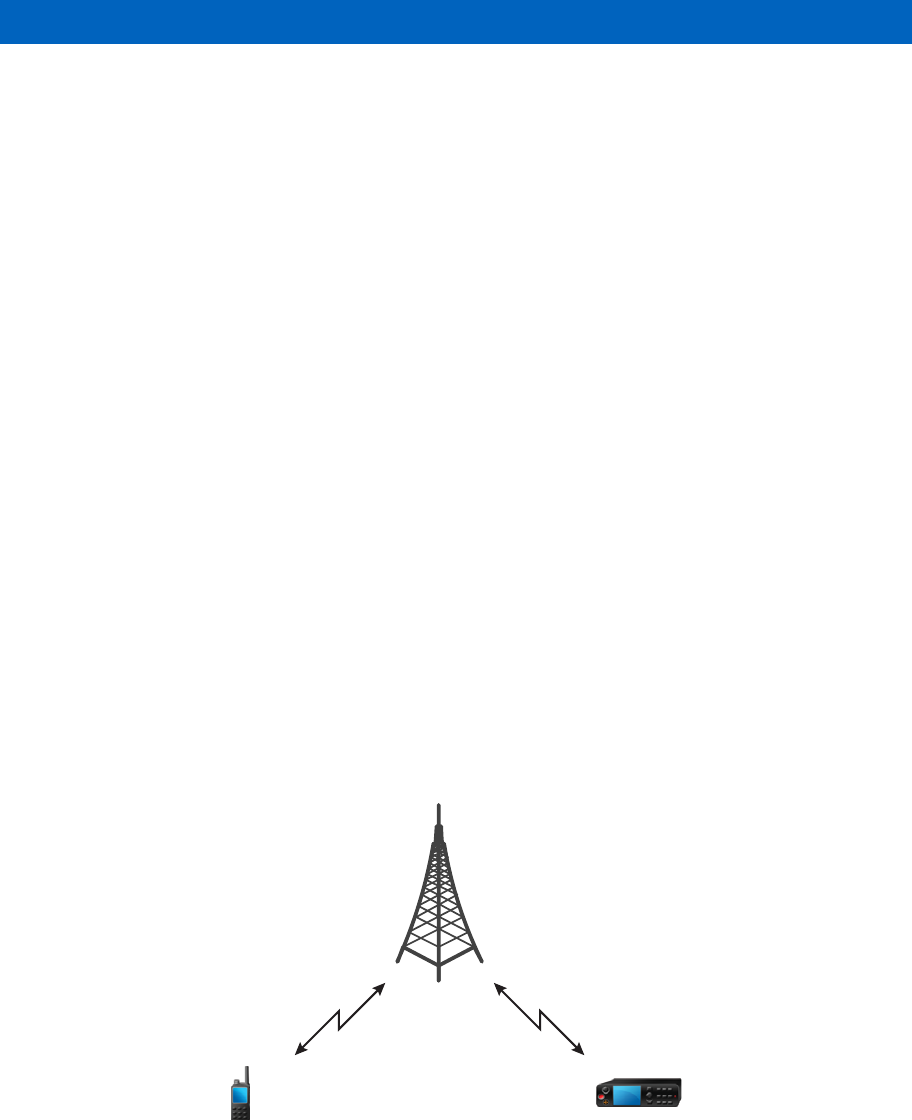
Chapter 3
Modes
This chapter contains information on available modes that the radio can operate in.
Using Networks
Procedure:
1From the home screen, press the MENU key.
2Select Networks.
3Select one of the following:
•Trunked Mode
•Direct Mode
•Repeater Mode
•Gateway Mode
•TXI Mode
Your radio switches to the selected mode.
Trunked Mode Operation
Trunked Mode Operation requires the switching and management infrastructure. This operation mode
enables various voice and data communication types (for example, group calls, short data service
messages) and access to the infrastructure-related features (for example, packet data).
Figure 1: Trunked Mode Operation
Entering TMO Mode
Procedure:
1From the home screen, press Optns.
Modes
Send Feedback 47

2Select Trunked Mode.
Selecting Talkgroups
From the home screen, use one of the following methods:
• Press left or right NAVIGATION key. Press Select to confirm.
• Select Optns → TG by abc. Enter a talkgroup name and select the talkgroup name from the list.
• Select Optns → TG by Folder. Select a folder and then a talkgroup name.
• Press ROTARY KNOB and rotate it until the required talkgroup name is displayed. Press Select to
confirm.
NOTICE: If the ROTARY KNOB mode is set to Scroll, then you do not need to press it to enter
the scrolling mode.
NOTICE: Your radio can have an access up to three levels of the folder structure.
Making Group Calls in TMO
The Group Call is received by all members of the selected group who have their units turned on and
are in range.
Procedure:
1Press and hold the PTT button.
2Wait for the Talk Permit tone (if configured) and then speak into the microphone. Release the
PTT button to listen.
NOTICE: To cancel making a group call, do one the following actions before the talk
permit is granted (depending on your service provider’s settings):
• Release the PTT button.
• Press the END key (default).
When the call is canceled, your radio displays Call Cancelled message (if configured by
your service provider).
Receiving Group Calls in Idle
Procedure:
1The radio receives a Group Call.
NOTICE: The incoming Group Call is signalled by a Receiving Group Call tone.
2To respond, press and hold the PTT button.
Receiving Group Calls during Ongoing Group Calls
While in active Group Call, your radio receives a Group Call with a higher priority.
One of the following occurs:
• Your radio is forced to end the current group call and automatically join the incoming one.
• Your radio displays incoming group call screen with options:
-Join — ends current Group Call and starts the incoming one.
Chapter 3: Modes
48 Send Feedback
-End — cancels the incoming Group Call.
Dynamic Group Number Assignment (DGNA)
DGNA allows the network operator to dynamically manage talkgroups on your radio over the air
interface. Using DGNA, the network operator can:
• Add talkgroups.
• Attach or select newly added talkgroups.
• Delete talkgroups.
• Modify parameters of existing talkgroups.
All the above operations are performed by transmitting data to your radio.
DGNA Reception
When a DGNA message is received, your radio plays a tone and displays a message Talkgroup list
updated. If enabled by your service provider, your radio displays all added and deleted talkgroup list.
When your service provider deletes (de-assigns) the currently selected talkgroup, depending on the
settings, the radio can perform one of the following actions:
• Enter the “No Group” state – the radio does not attach to any talkgroup automatically.
• Attach to the last selected TMO talkgroup. If the last selected TMO talkgroup is not available (it was
deleted), the radio enters the “No Group” state.
• Attach to a default talkgroup configured by your service provider. If the default talkgroup is not
available (it was deleted), the radio enters the “No Group” state.
At each talkgroup change, an appropriate notification is shown on the display.
If the DGNA message is received to delete all talkgroups, your radio displays All Talkgroups Deleted.
To exit the DGNA display, you can use the BackSOFT key or the END key.
DGNA Auto Select Group
If the DGNA Auto Select is configured, whenever your radio receives a DGNA, it switches to the added
talkgroup.
DGNA Auto Reselect Group
If the DGNA Auto Reselect is configured, whenever a talkgroup assigned by the network operator via
DGNA is deassigned without the user action, the radio returns to the previously selected group.
Viewing DGNA Talkgroups
Prerequisites: Your radio receives the DGNA message.
Procedure:
1To view the added talkgroups details press View.
2Scroll through the list to select required talkgroup.
3To select the DGNA group, press Attach.
Chapter 3: Modes
Send Feedback 49

Broadcast Calls Initiated by Users
This feature allows you to make a Broadcast Call from the radio that is initiated on the predefined
talkgroup. Your service provider predefines the alias and the priority of the Broadcast Call.
NOTICE: If the type of the encryption is defined by the SIM Card, the Broadcast Call is always
clear. Otherwise if the radio uses other encryption service the type of the encryption used for
that Call is up to the encryption settings of that service.
NOTICE: This feature is not supported on the Dimetra infrastructure.
Initializing Broadcast Calls
Procedure:
1From the home screen, press the MENU key.
2Select Services → Broadcast.
Your radio displays the predefined alias and the Broadcast Call icon.
3To start the call press the PTT button.
Phone and PABX Calls
The Phone Call allows you to call a landline telephone number or a cellular mobile phone number. The
Private Automatic Branch Exchange (PABX) Call allows you to call local (office) extension numbers.
Private Call
The Private Call, also called point-to-point, or individual call, enables calling between two individuals.
No other radio can hear the conversation. This call type can be carried out in two ways:
• Duplex call (if the system allows), in TMO Mode. Both parties can speak at the same time.
• Simplex call, in TMO or DMO Mode. Only one party can speak at a time.
When a DMO Private Call takes place, radios not involved in this call receive the channel busy
indication. The radios are identified using its radio numbers.
Interaction with the accessories:
• Fist Microphone — during the Private Call, if you hang the microphone into the clip the call ends or
the audio switches to the speakers (if connected). Exact behavior depends on your service provider
settings.
• Telephone Style Handset — during the Private Call, if you hand the handset into the holder, the call
ends or the audio switches to the speakers (if connected). Exact behavior depends on your service
provider settings.
NOTICE: To end the Private Call if audio was switched to the speaker, press ON/OFF/END/
HOME key.
To answer a Private Call, use one of the following methods:
• Press the PTT button.
• Take the Fist Microphone or Telephone Style Handset off hook. If the Handset is off hook, the
radio’s external speaker mutes and the Handset’s internal speaker activates.
• Press the SEND key on the control head. Audio is routed to audio input devices in the following
order, depending on their availability:
1A visor microphone.
Chapter 3: Modes
50 Send Feedback

2A microphone of the device that is off hook.
3A microphone that was last in use (if two devices are off hook).
Related Links
Emergency Individual Calls (Private or MS-ISDN) on page 59
Making Private Calls
Procedure:
1From the home screen, enter a number.
2If Private is not the first type of call presented, press Ctype repeatedly to select it.
3When you are in the following mode:
aTMO — For simplex calls, press and release the PTT button. You hear a ringing tone.
Otherwise, press and hold the PTT button. Wait for the talk permit tone before talking, and
release the PTT button to listen. For duplex calls, press and release the SEND key. You hear
a ringing tone.
bDMO — Only simplex calls are available. Press and hold the PTT button. Wait for the talk
permit tone before talking, and release the PTT button to listen.
4To end the call, press the END key.
NOTICE: If you are using the fist microphone or the telephone style handset, replace it
firmly on it's clip or holder when done.
Assistance Call
This feature allows you make a private call to ask for assistance during normal and non-critical
situations.
NOTICE: Your service provider can configure the number, priority, and the type of the call
(simplex or duplex).
You can start an Assistance Call in one of the following way:
• Dial a predefined number and press SEND key.
•Menu → Services → Assistance Call
Call Modification
Call Modification is a feature that allows your service provider to modify the call in order to optimize it
and adjust to a current situation.
Modification can cover:
• Call priority – modified during call setup.
• Call type – modified during call setup.
• Call encryption – modified during an ongoing call (but not in the transmission phase).
When the call is modified, your radio displays Call Modified message.
When a recently modified call requires the PTT button to transmit, your radio displays Call
ModifiedUse PTT.
All modifications are made by your service provider and the radio only follows them. You have no
influence on ongoing call modifications.
When call priority is changed to emergency:
Chapter 3: Modes
Send Feedback 51

• The display indicates that an Emergency Group Call has been received.
• The radio plays a special audio alert.
NOTICE: If a Group Call is modified into an Emergency Group Call, no emergency related
features are triggered.
If call modification requested by your service provider cannot be followed by the radio (due to its
settings), the radio rejects it and displays Service Not Available message.
Local Site Trunking
This mode is also called as Fallback Mode and it allows more than one radio from the same site to
communicate when the link between the site and the network central controller fails. Entering and
exiting Local Site Trunking (that is, returning to System Wide Services) is done automatically. In this
mode some services are unavailable.
NOTICE: Your service provider can disable this mode.
Entering Local Site Trunking
When your radio receives a Local Site Trunking indication from the system, the following occurs:
• Your radio plays an Entering Local Site Trunking tone.
• Display shows the Local Area Service message.
• Display icons and soft keys turn olive.
NOTICE: Noticeable only on the color display.
• Any call in progress is dropped upon entering Local Site Trunking Mode.
If configured by your service provider, this message/alert is periodically repeated to remind you that
your radio is still operating in Local Site Trunking Mode. The following features are available:
• Registration
• Attachment
• Group Call
• Emergency Call
• Emergency Alarm
NOTICE: Your service provider can turn on/off all the visual and audio indications, when you
enter Local Site Trunking Mode.
Exiting Local Site Trunking
When the link with the central network controller is reestablished, your radio exits Local Site Trunking,
and the following occurs:
• Your radio plays an Exiting Local Site Trunking tone.
• Any call in progress during Local Site Trunking is dropped.
• Display icons and soft keys turn blue.
NOTICE: Your service provider can turn on/off all the visual and audio indications, when you
exit Local Site Trunking Mode.
Chapter 3: Modes
52 Send Feedback
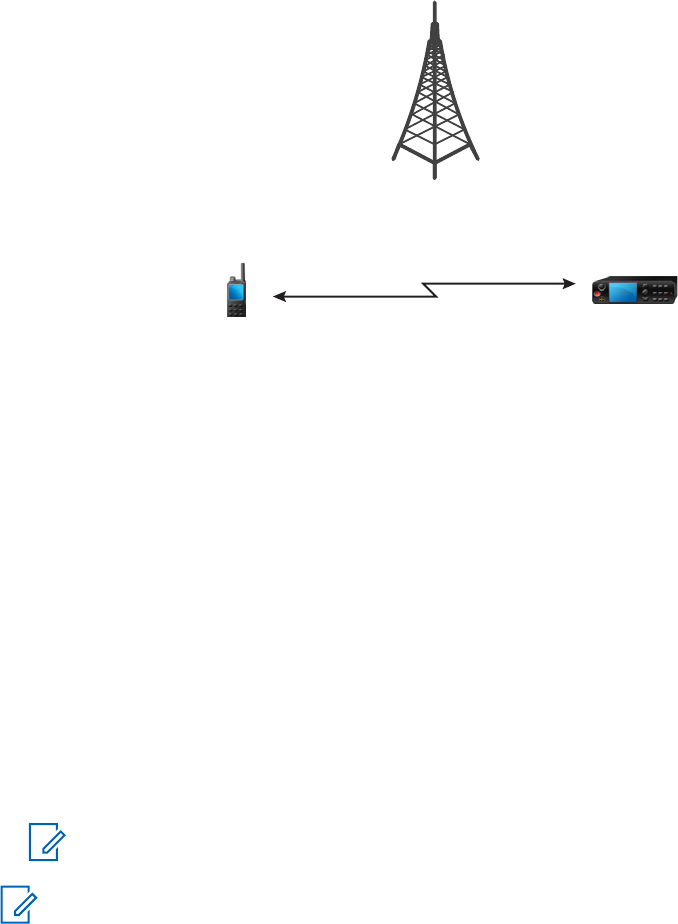
Direct Mode Operation
Direct Mode Operation is a mode of simplex operation where radios communicate directly.
Figure 2: Direct Mode Operation
Entering DMO Mode
To enter the DMO Mode:
• From the home screen, press the MENU key. Select Networks → Direct Mode.
• From the home screen, select Optns → Direct Mode.
Selecting Talkgroups
From the home screen, use one of the following methods:
• Press left or right NAVIGATION key. Press Select to confirm.
• Select Optns → TG by abc. Enter a talkgroup name and select the talkgroup name from the list.
• Select Optns → TG by Folder. Select a folder and then a talkgroup name.
• Press ROTARY KNOB and rotate it until the required talkgroup name is displayed. Press Select to
confirm.
NOTICE: If the ROTARY KNOB mode is set to Scroll, then you do not need to press it to enter
the scrolling mode.
NOTICE: Your radio can have an access up to three levels of the folder structure.
Making Group Calls in DMO
The Group Call is received by all members of the selected group who have their units turned on and
are in range.
Procedure:
1Press and hold the PTT button.
2Wait for the Talk Permit tone (if configured) and then speak into the microphone. Release the
PTT button to listen.
Chapter 3: Modes
Send Feedback 53

Receiving Group Calls in Idle
Procedure:
1The radio receives a Group Call.
NOTICE: The incoming Group Call is signalled by a Receiving Group Call tone.
2To respond, press and hold the PTT button.
Private Call
The Private Call, also called point-to-point, or individual call, enables calling between two individuals.
No other radio can hear the conversation. This call type can be carried out in two ways:
• Duplex call (if the system allows), in TMO Mode. Both parties can speak at the same time.
• Simplex call, in TMO or DMO Mode. Only one party can speak at a time.
When a DMO Private Call takes place, radios not involved in this call receive the channel busy
indication. The radios are identified using its radio numbers.
Interaction with the accessories:
• Fist Microphone — during the Private Call, if you hang the microphone into the clip the call ends or
the audio switches to the speakers (if connected). Exact behavior depends on your service provider
settings.
• Telephone Style Handset — during the Private Call, if you hand the handset into the holder, the call
ends or the audio switches to the speakers (if connected). Exact behavior depends on your service
provider settings.
NOTICE: To end the Private Call if audio was switched to the speaker, press ON/OFF/END/
HOME key.
To answer a Private Call, use one of the following methods:
• Press the PTT button.
• Take the Fist Microphone or Telephone Style Handset off hook. If the Handset is off hook, the
radio’s external speaker mutes and the Handset’s internal speaker activates.
• Press the SEND key on the control head. Audio is routed to audio input devices in the following
order, depending on their availability:
1A visor microphone.
2A microphone of the device that is off hook.
3A microphone that was last in use (if two devices are off hook).
Related Links
Emergency Individual Calls (Private or MS-ISDN) on page 59
Making Private Calls
Procedure:
1From the home screen, enter a number.
2If Private is not the first type of call presented, press Ctype repeatedly to select it.
3When you are in the following mode:
Chapter 3: Modes
54 Send Feedback

aTMO — For simplex calls, press and release the PTT button. You hear a ringing tone.
Otherwise, press and hold the PTT button. Wait for the talk permit tone before talking, and
release the PTT button to listen. For duplex calls, press and release the SEND key. You hear
a ringing tone.
bDMO — Only simplex calls are available. Press and hold the PTT button. Wait for the talk
permit tone before talking, and release the PTT button to listen.
4To end the call, press the END key.
NOTICE: If you are using the fist microphone or the telephone style handset, replace it
firmly on it's clip or holder when done.
Private Call With Presence Check
This feature allows you to see if the calling party is available in DMO. When this feature is enabled, you
can only initiate a Private Call if the called radio is present on the same channel and responds with a
presence check acknowledgement.
Otherwise your radio displays Party Not Available.
DMO Private Priority Call
The service provider may assign Pre-emptive Priority to outgoing DMO Private Calls. If this is the case,
DMO Private Calls from this radio preempt any ongoing calls (with the exception of emergency calls or
ongoing Pre-emptive Priority Private Calls) on the receiving radio, which then displays Call-
preempted.
Talkgroup for Individual Calls
Talkgroup for Individual Calls is a talkgroup that operates on a separate frequency allocated for
individual (private) calls only. Using this talkgroup optimizes frequency resources and helps not to
block other talkgroups. The only supported call types are: private calls and emergency calls (both
private and group). Use this talkgroup each time you need to make a private call.
When you select a Talkgroup for Individual Calls, your radio is not able to receive or initiate any group
or broadcast calls with priority lower than Emergency.
When you have selected a Talkgroup for Individual Calls and press the PTT button to start a Group
Call, the radio:
• Rejects the call
• Plays a tone
• Displays the Individual Calls Only message
Communication through Repeaters
Radios that are out of range and cannot communicate directly one with another in DMO Mode can do it
through the repeater. The repeater is a radio that repeats all communication on a chosen channel, and
as a result increases radios’ DMO range.
Chapter 3: Modes
Send Feedback 55
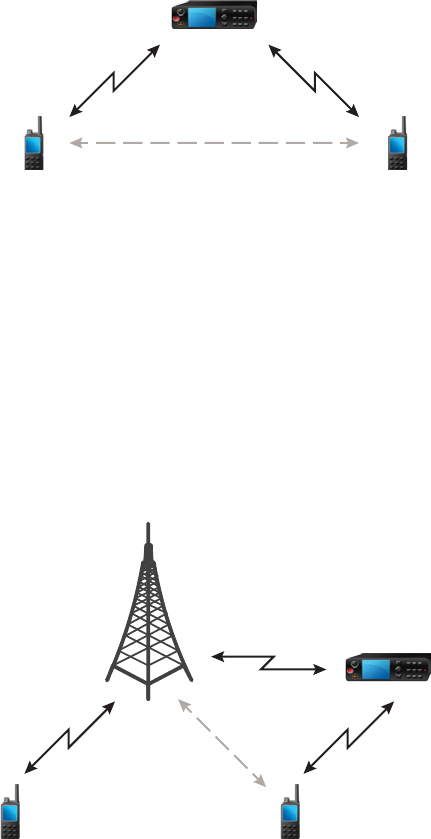
DMODMO
When the radio connects to a repeater, it plays a tone, displays the Repeater available message, and
shows an appropriate icon. When the radio looses connection with the repeater, it plays a tone,
displays the Repeater not available message, and the repeater icon is blinking.
Communication through Gateways
Gateway provides connectivity between radios operating in DMO Mode and the TETRA network, so
that the DMO radios can communicate with the TMO radios.
DMO
TMO
TMO
When the radio connects to a gateway, it plays a tone, displays the Gateway available message and
shows an appropriate icon. When the radio looses connection with the gateway, it plays a tone,
displays the Gateway not available message, and the gateway icon is blinking.
Selecting DMO Group Call Options
When and where to use: Helps to communicate with other radio users on the same talkgroup through
the Gateway or Repeater.
Procedure:
1From the home screen, press Optns.
2Press Config.
3Select one of the following:
Chapter 3: Modes
56 Send Feedback

•MS - MS — Your radio can communicate only with other radios within its range.
•Gateway — Your radio uses a gateway to communicate with the infrastructure.
•Automatic — Your radio uses the first available gateway for that talkgroup.
•Specific — Your radio uses only the Gateway with the specified Gateway address for that
talkgroup. If your radio displays Selected Gateway:None, press Edit to enter the current
gateway address.
•Repeater — Uses the first available repeater for that talkgroup.
•GW + Rep — Uses the first available gateway or repeater for that talkgroup.
•Automatic — Uses the first available gateway for that talkgroup.
•Specific — Uses only the Gateway with the specified Gateway address for that talkgroup.
If your radio displays Selected Gateway:None, press Edit to enter the current Gateway
address.
NOTICE: When the Gateway and the Repeater cannot be communicated even
though a talkgroup to use them is configured, the radio attempts the direct MS-MS
communication.
When your radio detects the appropriate Gateway and/or the Repeater, the Gateway and/or Repeater
icons turns solid, respectively.
Transmit Inhibit Mode
The Transmit Inhibit Mode is a mode in which the radio sends no radio transmissions. It is
recommended to activate the mode in RF sensitive areas, for example hospitals, airplanes, where
safety can be jeopardized due to transmission radiation.
To activate, select MENU → Networks → TXI Mode → Activate.
In this mode, the radio does not transmit under any circumstances except for the Emergency Calls. All
the functions and keys which cause transmission, for example registration to the network, changing
talkgroup or folder, sending SDS messages, or pressing the PTT button are disabled. Any transmission
trial causes the radio to display Not Allowed In TXI Mode notification and to play a tone.
Your radio can still receive:
• Group calls.
• Messages — stored in the Inbox.
• Private call attempts — stored in the Missed Calls list, without the option to respond.
When no danger to safety exists anymore (for example, you leave the RF sensitive area), you can
deactivate the Transmit Inhibit Mode and the radio returns to standard operation.
You can deactivate the mode by selecting MENU → Networks → TXI Mode → Deactivate, pressing
One-Touch button, or implicitly when initiating an Emergency Call.
NOTICE: RF Transmissions from the radio are prevented under the following conditions:
• TXI Mode is activated.
• The radio is turned off.
On entering or exiting the transmit inhibit mode, when the radio is camped on a cell, it sends a
specially designated SDS status message. This SDS message indicates to the SwMI that the radio is
entering or exiting transmit inhibit mode.
Mobility procedures that do not require the radio to send an uplink transmission are performed except
for cell reselection.
Chapter 3: Modes
Send Feedback 57

In transmit inhibit mode the radio joins group calls for any group that the radio is monitoring, but the
transmitting on that call is still prohibited.
The radio also displays any incoming SDS messages to the user. The missed call feature is active in
the transmit inhibit mode and allows checking what calls were missed. However, the radio attempts to
prevent call setup retransmission from being recorded as separate calls.
If you initiate an emergency call, the radio immediately leaves transmit inhibit mode and attempts to
start the emergency call if the radio is in service.
If the radio is turned off in the transmit inhibit mode, on turning on the radio asks whether to exit the
transmit inhibit mode. If you choose No, the radio turns off.
Emergency Operations
Emergency Operations are used in critical situations.
Pressing and holding the EMERGENCY button, or entering the Emergency Number and pressing the
SEND key, activates one or more services (depending on your service provider settings):
• Emergency Alarm
• SDS Status
• Silent Emergency
• Hot Microphone operation
• Emergency Individual Call (Private or MS-ISDN)
• GPS location information
NOTICE: It is possible to turn on the radio by pressing the EMERGENCY button. Depending on
the service provider settings, the radio can start Emergency Operations automatically. If the
radio is PIN-protected (except for SIM PIN), Emergency Operations will bypass the PIN lock for
the duration of the Emergency Operations.
When starting Emergency Operations, any ongoing voice call is aborted or cleared down, and any
packet data transfer in progress is aborted. However, the session is kept open.
During Emergency Operations, the radio rejects phone, PABX, and private calls, and does not monitor
the talkgroups in the selected scan list.
To terminate Emergency Operations, press the upperSOFT key.
Emergency Group Call
The Emergency Group Call has the highest communication priority that means it is the pre-emptive
kind of call. Emergency Group Call is available in both TMO and DMO. During Emergency Operations,
Emergency Group Call can be started by pressing pressing the EMERGENCY button. The radio can also
support Hot Microphone operation, which allows the Emergency Call to be conducted without pressing
the PTT button.
If the radio receives an incoming group call with emergency priority, the display shows that an
emergency call has been received, and a special audio alert is played.
An emergency group call can be configured as:
• A non-tactical call – initiated on a talkgroup preprogrammed by your service provider. When in non-
tactical emergency mode, you cannot switch talkgroups.
• A tactical call – initiated on the currently selected talkgroup.
In TMO, if the radio enters Emergency Operations while the Emergency Broadcast Call is active, the
radio continues on the call without initiating any calls and sends the Emergency Alarm.
Chapter 3: Modes
58 Send Feedback

When the Emergency Group Call you participate in terminates, your radio can behave in several ways,
depending on your service provider settings:
• If you are the call initiator, the radio can either stay in the Emergency Mode, or return to TMO.
• If you are not the call initiator, the radio always returns to TMO.
Making Emergency Group Calls
Prerequisites: Ensure that your radio is in Emergency Mode.
Procedure:
1Press and hold the PTT button.
2Wait for the talk permit tone (if configured) and talk.
3Release the PTT button to listen.
NOTICE: It is possible to cancel making an emergency group call in TMO. To do this,
perform one of the following actions before the talk permit is granted (depending on your
service provider settings):
• Release the PTT button.
• Press the END key (default).
When the call is canceled, your radio displays Call Cancelled message (if configured by
your service provider).
Receiving Emergency Group Calls
The radio receives an Emergency Group Call from a selected pre-programmed group. An incoming call
is indicated by an appropriate tone, status icon, and red color of the display.
Non-Tactical Emergency
In Non-Tactical Emergency, the radio switches to a designated Emergency talkgroup when starting
Emergency Operations. This talkgroup is used for the complete duration of the Emergency Operations
(you cannot change the talkgroup).
In TMO, it is possible to configure the radio to make Emergency Non-Tactical Group Calls without
sending attachment. If this is set, the radio assumes implicit attachment after receiving a temporary
address.
In DMO, the Non-Tactical Emergency proceeds on the same frequency as the previously selected
talkgroup. The service provider can designate any ITSI address to be used for Emergency Operations,
(this can be an Open Group – broadcast address).
After exiting from Non-Tactical Emergency, the radio goes back to the previously selected talkgroup.
Emergency Individual Calls (Private or MS-ISDN)
The Emergency Individual Calls are Simplex or Duplex Calls with emergency priority. On pressing the
EMERGENCY button, the radio initiates an Individual Call to the provisioned address (private or MS-
ISDN). During this kind of call all user indications are unavailable and all other services are rejected.
Emergency Operation ends as soon as the Emergency Individual Call is ended.
Chapter 3: Modes
Send Feedback 59

Related Links
Private Call on page 50
Emergency Alarm
The Emergency Alarm is a special status message sent to the infrastructure while starting the
Emergency Operations. The radio can wait for infrastructure acknowledgment for this alarm and
attempts retries.
Each time the radio enters the Emergency Operation, it sends the Emergency Alarm. When the
Emergency Alarm is sent successfully, the respective audible tone sounds.
In addition, once the radio is in the Emergency Operation on pressing the EMERGENCY button, an
additional emergency alarm is sent (exception: during Hot Microphone transmission).
The message can be dispatched both in TMO and DMO.
Emergency SDS Status
Radio sends a status message with a preprogrammed value to the destination address set by your
service provider. Emergency SDS Status is available in TMO only. If no status acknowledgment or
negative acknowledgment is received, the radio retries sending the message. Status is not resend if
Emergency Alarm or Hot Microphone is configured.
Emergency Hot Microphone
The Hot Microphone allows you to talk without pressing the PTT button during Emergency Operations.
The transmission continues for a provisioned amount of time. Pressing the PTT button before the Hot
Microphone time expires ends the Hot Microphone operation. Then normal PTT operation in
Emergency group call takes over (that is, the transmission is ongoing for the time the PTT button is
held).
Subsequent EMERGENCY button presses during the Emergency Operation restarts the Hot
Microphone transmission.
If a talk permit is granted to another member of the group, the Emergency Call received tone is played.
If configured, the radio automatically attempts to get talk permit again.
Pressing EndSOFT key or END key ends the Hot Microphone operation.
Alternating Hot Microphone
The Alternating Hot Microphone is an enhancement of the Hot Microphone. After activation, the radio
alternately enters transmission phases (your microphone is active) and reception phases (you can only
listen) for an amount of time precisely determined by your service provider.
If this feature is enabled, you can initiate the Alternating Hot Microphone by pressing the EMERGENCY
button. If you want to finish earlier or skip the transmission phase, press the END key.
The Alternating Hot Microphone terminates when one of the following conditions is met:
• The radio exits the Emergency Mode.
• The Alternating Hot Microphone timer expires.
• The PTT button is pressed.
• The upper SOFT key is pressed (only during the transmission phase).
NOTICE: When the radio goes out of the service, it enters the reception phase and the
Alternating Hot Microphone is on hold. When the radio is back to the service, the Hot
Microphone transmission and the Alternating Hot Microphone resume.
Chapter 3: Modes
60 Send Feedback

NOTICE: When you are in the Emergency Mode, pressing the EMERGENCY button restarts the
Alternating Hot Microphone.
Silent Emergency Mode
The Silent Emergency Mode is a type of emergency services that provides no audible indications and
no keypad tones at the entrance. All the display indications are as in the home mode. However, the
radio cannot use any services except for:
• Receiving Ambience Listening
• Sending Silent Emergency Alarms
• Sending GPS location reports
NOTICE: If you try to activate any other feature, it is blocked.
If the Silent Emergency feature is enabled, the radio enters Silent Emergency Mode on pressing the
EMERGENCY button. After entering this Mode the radio stays in TMO or switches to it, depending on
the actual state. Once in TMO, the radio sends Silent Emergency Alarm.
NOTICE: If the radio is in a private or group call, the radio waits until the call ends and then
enters the Silent Emergency Mode.
The radio keeps re-sending the alarm until successful sending is confirmed. After the alarm is
successfully delivered, the radio stays in Silent Emergency Mode and waits for the Ambience
Listening.
Your radio exits the Silent Emergency Mode, under the following conditions:
• Press MENU and then # key within 3 seconds.
• Press MENU simultaneously with right NAVIGATION key.
• Press both SOFT keys simultaneously.
• No success in sending the Silent Emergency Alarm and the maximum number of retries has been
reached.
• The control room terminates the Silent Ambience Listening.
• The Ambience Listening is disconnected due to another reason.
If you turn off the radio in the Silent Emergency Mode, the radio switches to pseudo power off state. In
this state, the radio appears to be turned off. However, the radio is still on and in the Silent Emergency
Mode. On turning the radio on during the pseudo power off state, the radio acts as during turning on
and still is in the Silent Emergency Mode.
Invisible Emergency
It is possible for the service provider to disable visual and audible indications of performing Emergency
Operations on the radio. The purpose of this feature is to hide the fact of using Emergency Operations
in a critical situation (e.g. direct attack on the user) and thus to provide additional layer of safety.
Emergency Mode by Dialing
This feature allows you to trigger Emergency Mode by dialing a predefined number. It initiates the
same Emergency services as you would use the EMERGENCY button. Your radio can store up to eight
Emergency numbers.
NOTICE: If this Emergency Mode was triggered by Emergency number (not by EMERGENCY
button), you can press the END key to exit the Emergency Mode.
Chapter 3: Modes
Send Feedback 61

Disaster Alert
Disaster Alert call is a broadcast emergency call initiated by the radio, with emergency pre-emptive
priority that everyone in a broadcast area can hear. This feature is specifically designed for
catastrophic situations, such as earthquakes, and has the highest priority over other calls. All radios
under Disaster Alert display emergency notification on their screens. The alert message, its duration
and destination talkgroup can be configured in the codeplug.
In order to initiate Disaster Alert, switch the radio to Disaster Alert mode and press PTT button. When
the call ends, the radio will exit the Disaster Alert state.
During Disaster Alert, other functionality is impacted:
• When Disaster Alert begins, any other ongoing services are terminated.
• No other services can interrupt this type of call.
• Hot Mic functionality cannot be used.
• Speech can only be in Clear mode, even if any of the encryption services are enabled. The only
exception is E2E Encryption.
NOTICE: Not all infrastructures support this feature. Please consult with your service provider
before enabling this feature.
Initializing Disaster Alert Calls
Procedure:
1From the home screen, press the MENU key.
2Select Services → Disaster Alert.
Your radio enters Disaster Alert Mode and it displays Disaster Alert icon.
3To start the call press PTT.
Your radio displays Disaster AlertIn Use.
Exiting Emergency Operations
Prerequisites: Make sure that your radio is engaged in Emergency Operations.
Procedure:
1If your radio screen displays Emergency Mic On, press End.
2Press and hold Exit.
NOTICE: If an Emergency Operation was triggered by Emergency number (not by
EMERGENCY button), you can press the END key to exit the Emergency Operation.
3If your radio displays Do you want to exit?, press Yes to exit.
Your radio exits Emergency Operations.
Repeater Mode
NOTICE: Repeater Mode does not apply to MTM5200 radio.
The Repeater Mode provides repeater connectivity between radios operating in the DMO Mode.
Chapter 3: Modes
62 Send Feedback
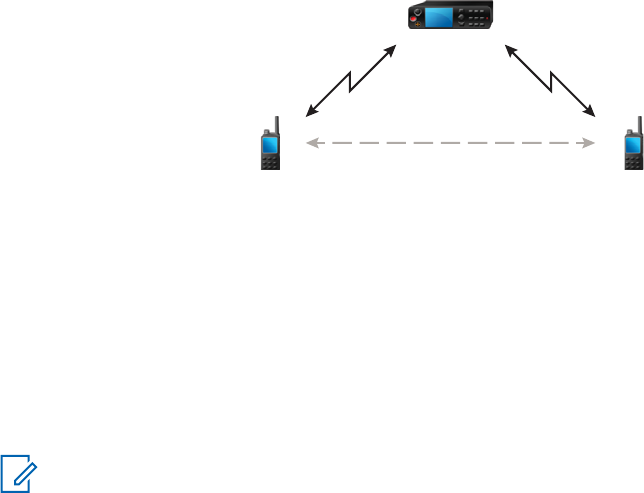
Figure 3: Repeater Mode Operation
DMODMO
A DMO repeater is used to extend the DMO range by retransmitting received information from one
radio to another. It retransmits group calls, private calls and data on a given frequency.
The repeater sends presence signal periodically on a free channel to allow other radios to synchronize
on a given frequency.
Only the radios on the same talkgroup can communicate with each other through the repeater.
NOTICE: This is a selling feature.
Entering the Repeater Mode
To enter Repeater Mode, use one of the following ways:
• From the home screen, select Optns → Repeater Mode.
• From the home screen, press MENU key. Select → Networks → Repeater Mode.
Setting Monitor Option
Procedure:
1From the home screen, press Optns.
2Press Monitor.
3Select one of the following:
•Off — Your radio works as a repeater only, no operation is available.
•Receive Only — Allows you to listen.
•Receive&Transmit — Allows you to listen and transmit by pressing PTT.
Encryption in the Repeater Mode
While in the Repeater Mode, the radio supports Air Encryption and is able to repeat encrypted calls
and messages.
If SCK keys installed on the radio are invalid:
• The radio transfers calls and messages without deciphering them (provided that the encryption level
is not the highest).
Chapter 3: Modes
Send Feedback 63

• The LED indicator turns orange.
• On pressing the PTT button, Channel Busy or DMSCK is Invalid message appears.
• You cannot make any call.
Gateway Mode
NOTICE: Repeater Mode does not apply to MTM5200 radio.
The Gateway Mode allows your radio to work as a gateway and thus provide connectivity among
radios operating in DMO and TMO Modes.
Figure 4: Gateway Mode Operation
DMO
TMO
TMO
A DMO/TMO gateway is used to provide gateway connectivity between radio operation in the DMO
and the TETRA TMO network. In other words, the gateway mode provides the interface between
TETRA DMO and TMO modes.
While in the gateway mode, any individual call from both DMO and TMO cannot be answered. If the
call is incoming from TMO, it is rejected with disconnect cause as the called party is busy. The missed
call is added to the missed call list. If the call is incoming from DMO, it is ignored.
While in the gateway mode, group calls are supported. When the gateway receives a group call
addressed to its current selected TMO talkgroup, it forwards the call on to the respective mapped DMO
talkgroup. If the DMO channel is not free, and the incoming call has Emergency priority, then
preemption request is sent.
When the gateway receives a group call addressed to its current selected DMO talkgroup, it forwards
the call on to the respective mapped TMO talkgroup. The DMO radio that initiated the call requires
correct setup for gateway calls (otherwise the call is rejected).
NOTICE: This is a selling feature.
Entering Gateway Mode
Procedure:
1From the home screen, press Optns.
2Select Gateway Mode.
Chapter 3: Modes
64 Send Feedback

NOTICE: When the Gateway Mode is enabled, you cannot make any call.
Standby Mode
Your radio enters Standby mode if there is another Gateway on the same DMO frequency. Gateway
icon flashes and no transmission is forwarded through the gateway. To exit Standby Mode you can:
• Choose another DMO talkgroup
• Wait untill the other gateway is out of coverage and is no longer present on that DMO talkgroup
Forwarding Group Calls
Your radio shows the source and destination talkgroup of the Group call.
Setting Monitor Options
Procedure:
1From the home screen, press Optns.
2Press Config and Select one of the following:
•Off — Audio of the calls are not routed to the speakers of the gateway.
•Receive Only — Audio of the calls are routed to the speakers of the gateway.
Emergency Calls in Gateway Mode
Press the EMERGENCY button to enter the TMO Emergency mode and start an Emergency Group call.
Check with your service provider if the Emergency Group call starts on a tactical or non-tactical
talkgroup. If the radio that is in the Gateway mode receives an Emergency Group call, it forwards it to
the respective TMO/DMO talkgroup that is currently switched to.
Encryption in Gateway Mode
While in the Gateway Mode, the radio supports Air Encryption and is able to transmit encrypted calls
among radios operating in TMO and DMO.
If SCK keys installed on the radio are invalid, the radio cannot function as a gateway and transmit calls.
Chapter 3: Modes
Send Feedback 65
This page intentionally left blank.

Chapter 4
GPS Location Service
The GPS Location Service feature uses information from Global Positioning System (GPS) satellites
orbiting the Earth to determine the approximate geographical location of your radio.
The GPS Location Service availability, accuracy, and the position calculation time vary depending on
the environment in which you use the radio. The GPS Location Service can assist your dispatcher or
colleagues in many ways such as more efficient deployment of resources or locating your radio when
you trigger your emergency service.
The radio can display the location information directly on the screen or send it over the air to your
dispatcher to display it in the control center. Check your radio configuration details with your service
provider.
IMPORTANT: Where the signals from satellites are not available, the GPS Location Service
does not work. This situation usually happens when your radio cannot establish a view of a
wide area of open sky, for example, when the GPS antenna is covered or facing the ground.
Such situations include being:
• In underground locations
• Inside buildings, trains, or other covered vehicles
• Under any other metal or concrete roof or structure
• Near a powerful radio or television tower
• In extreme temperature outside the operating limits of your radio
Even if your location information can be calculated in such situations, it may take longer to do so.
Therefore, in any emergency situation, always report your location to your dispatcher. Where adequate
signals from multiple satellites are available, your GPS Location Service feature provides a location,
most probably near to your actual location.
The radio can be triggered to send Location Reports in various circumstances, for example:
• Upon a request
• Entering Emergency Mode
• At specified time intervals
• At specified distance intervals
The Location Reports can be sent both in TMO and DMO by using:
• SDS messages
• Packet Data
The radio can be configured to give audio-visual notifications upon sending the Location Reports.
Depending on the radio settings, viewing the radio position and the status of the visible satellites is
available. The position may consist of longitude and latitude, UK, or Irish grid coordinates.
NOTICE: This is a selling feature.
GPS Location Service
Send Feedback 67
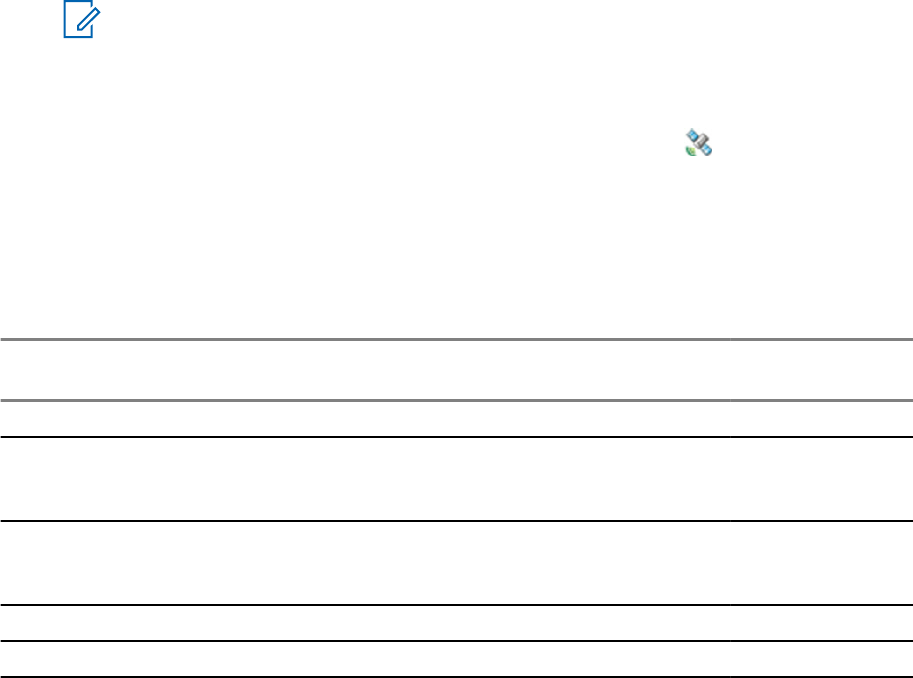
Related Links
Location on page 111
Enhancing GPS Performance
Sometimes the GPS feature is unable to complete a location calculation successfully. You hear an
audible tone indicating that your radio cannot see the satellites.
The GPS feature works best where there is nothing between your radio and a large amount of open
sky. To maximize the ability of your radio to determine a location fix, avoid closed space, tall buildings,
and foliage. If possible, do not use GPS in underground parking lots, tunnels, under bridges, and close
to high buildings.
Enabling GPS
Procedure:
1From the home screen, press the MENU key.
2Select Location → Interface.
3Select On.
NOTICE: Your service provider can enable this feature.
GPS Icon
When GPS is enabled, the following icon is displayed in the status icon area: Depending on the
current GPS state, the icon can be solid – GPS has a fix, or blinking – GPS is searching for a fix. The
blinking GPS icon can be disabled/enabled by your service provider.
GPS Different Location Displays
Table 15: Different Location Displays
Latitude / Longi-
tude UK Coordinates Irish Coordi-
nates
UTM Coordi-
nates
MGRS Coordi-
nates
Time Time Time Time Time
Latitude 2–Letter Code 1–Letter Code 3–Letter Code 3–Letter Code
and 2–Letter
Code
Longitude Easting and
Northing Coordi-
nate
Easting and
Northing Coordi-
nate
Easting and
Northing Coordi-
nate
Easting and
Northing Coordi-
nate
Altitude Altitude Altitude Altitude Altitude
Satellites Satellites Satellites Satellites Satellites
• Time — indicates when the last time the location was calculated. The time is provided in Universal
Time Coordinated.
• Letter Code — grid zone or square on the map for different coordinate standard
• Latitude — expressed in degrees, minutes, and seconds.
Chapter 4: GPS Location Service
68 Send Feedback

• Longitude — expressed in degrees, minutes, and seconds.
• Number of satellites — used to calculate the location. In general, more satellites make for better
accuracy. The maximum is 12 satellites.
• Easting — refers to the eastward-measured distance expressed in meters.
• Northing — refers to the northward-measured distance expressed in meters.
NOTICE: Skipping each digit of easting and northing coordinates decreases the accuracy by
the factor of 10.
Viewing Your Position
Procedure:
1From the home screen, press the MENU key.
2Select Location → Position.
3Scroll to view the results about the last time your location was calculated.
NOTICE: To refresh your position:
• Select Position — the radio refreshes its position automatically
• Press Refresh
GPS – Things to Keep in Mind
Where adequate signals from multiple satellites are not available, the GPS feature of your radio does
not work. Such situations include but are not limited to:
• In underground locations
• Inside of buildings, trains, or other covered vehicles
• Under any other metal or concrete roof or structure
• Near a powerful radio or television tower
• When your GPS antenna is covered (for example, by your hand or other object) or facing the
ground
• In temperature extremes outside the operating limits of your radio
Even where location information can be calculated in such situations, it may take longer to do so.
Therefore, in any emergency situation, confirm your location with your dispatcher.
Furthermore, please note that even where adequate signals from multiple satellites are available, your
GPS feature provides only an approximate location, often within 20–100 meters from your actual
location.
Chapter 4: GPS Location Service
Send Feedback 69
This page intentionally left blank.
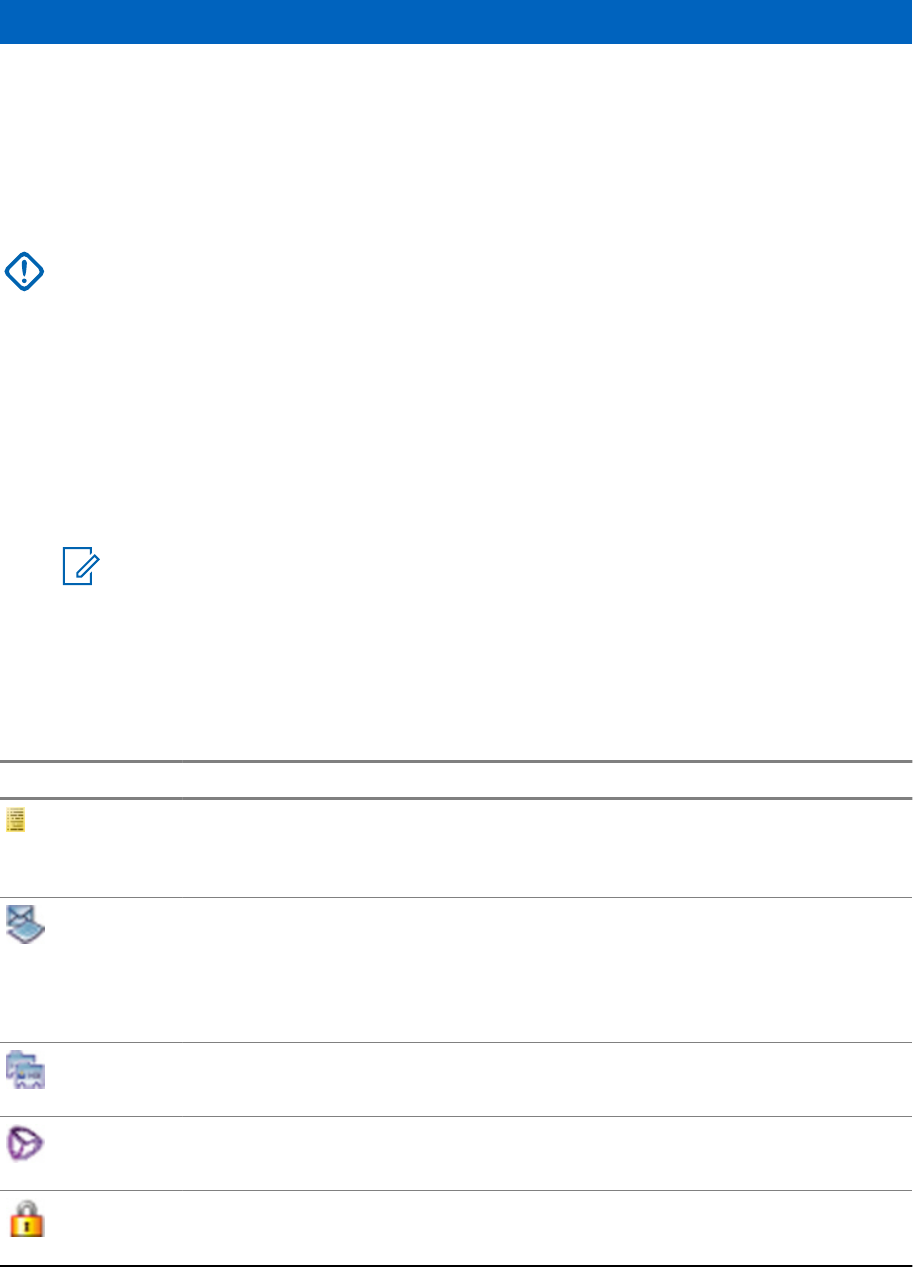
Chapter 5
Main Menu
This chapter contains information on items in the main menu.
You can enter the menu items during a call. If you are viewing a menu when a new call starts, the radio
exits the menu.
IMPORTANT: Some menu items are model specific and may not be activated or available on
your radio.
Scrolling through the Menu
Procedure:
1From the home screen, press the MENU key.
2Scroll to the required item by pressing NAVIGATION keys. Press the SOFT key assigned as Select
or right NAVIGATION key to select.
If the menu item contains a further set of menu items, repeat step 2.
NOTICE: You can use shortcuts to access frequently used items.
Menu Icons
The following icons make it easy to identify the menu items at first glance.
Table 16: Menu Icons
Menu Icon Description
Main Menu Items / Context Sensitive Menu
It is assigned to MENU when the main menu items / context-sensitive menu are ac-
tive.
Messages
Send status messages,
Send text messages (free text or according to user defined or predefined tem-
plates),
Received messages in Inbox.
Contacts
Add, search, edit, or erase entries in the contact list.
Browser
Starts the WAP browser.
Security
Lets you turn on/off and verify security features, and change passwords.
Table continued…
Main Menu
Send Feedback 71
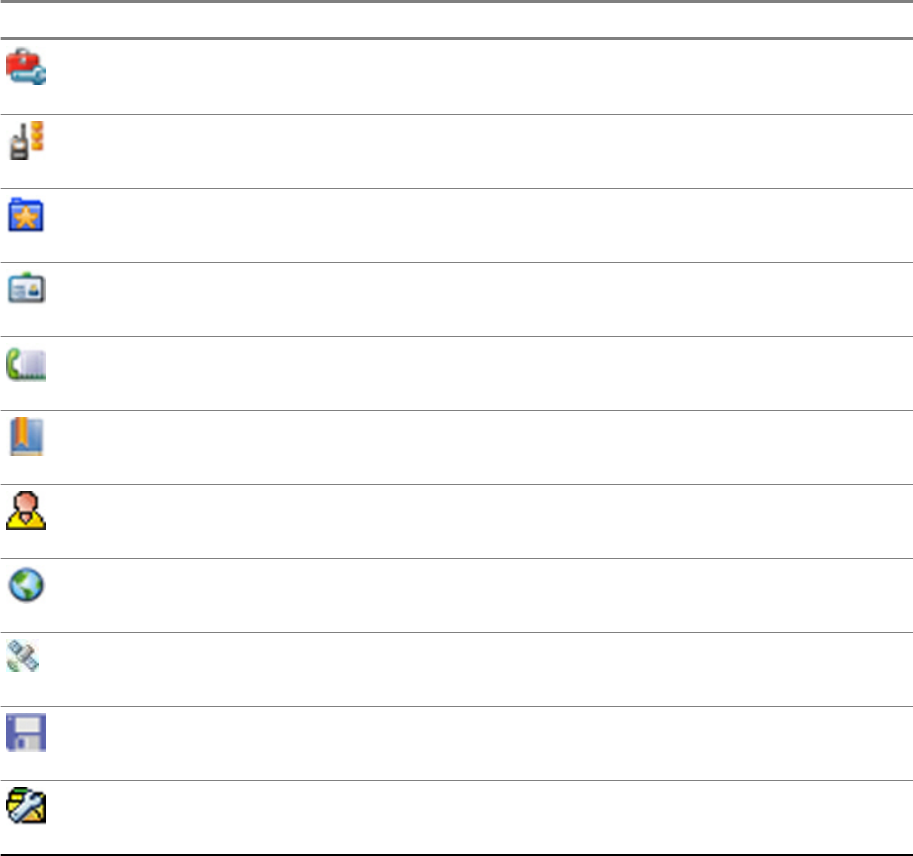
Menu Icon Description
Setup
Allows you to customize your radio.
Group Setup
Contains additional menu items for Scanning Talkgroups features.
Favorites
Contains shortcuts to frequently used talkgroups and contact numbers.
My Info
Displays information about your radio and its numbers.
Recent Calls
Contains a list of recent calls.
Shortcuts
Allows you to view and manage shortcuts to menu items.
RUI
Allows you to log in and log out of the radio.
Networks
Allows you to select a network.
Location
Displays location of your radio.
Packet Data
Allows you to send data from your radio to other devices.
Services
Allows you to manage Broadcast, Assistance and Disaster Calls.
Messages
This feature allows you to send and receive text messages. A message can contain up to 1000
characters, depending on your service provider settings.
Pressing the PTT button when a message is highlighted can cause one of the following actions,
depending on your service provider settings:
• The radio ignores the PTT button request.
• The radio starts a Private Call with the message sender.
• The radio starts a Group Call on a currently selected talkgroup.
New Message
This menu item allows you to create a new message.
Chapter 5: Main Menu
72 Send Feedback

Sending Messages to Private/Phone
Procedure:
1From the home screen, press the MENU key.
2Select Messages → New Message.
3Enter your message and press Send.
4If needed, select Private/Phone.
5Enter recipient number or press abc to choose it from your contacts.
NOTICE:
For Private target selection, you can enter either Individual Short Subscriber Identity
(ISSI) or Group Short Subscriber Identity (GSSI) of the recipient.
ISSI – a unique, individual ID assigned for each radio.
GSSI – in Dimetra called Group ID or Talkgroup ID.
6Press Send, or SEND key, or the PTT button.
Sending Messages to Groups
Procedure:
1From the home screen, press the MENU key.
2Select Messages → New Message.
3Type your message and press Send.
4If needed, select Group.
5Select a group to send the message.
Sending Store and Forward Messages
Prerequisites: Your service provider enables the Store and Forward feature.
Procedure:
1From the home screen, press the MENU key.
2Select Messages → New Message.
3Press MENU key and select Message Setup → On/Offline users.
4Enter your message and press Send.
5If asked for the Target selection, select one of the following:
•Private – enter the private number or press abc to choose the destination number from the
contact list.
•Phone – enter the phone number or press abc to choose the destination number from the
contact list.
NOTICE: Your service provider can enable to send a Store and Forward message to a
talkgroup.
6Select Send, or press SEND key or PTT button.
Chapter 5: Main Menu
Send Feedback 73
Delivery Report
Delivery Report is an acknowledgment that the radio can request upon sending a message to an
individual recipient. You can define what type of Delivery Report your radio requests, or turn on/off this
feature.
If the Delivery Report is received shortly after the message was sent, the radio:
• Displays a pop-up with one of the following messages:
-Message Sent – if no Delivery Report is requested (and when a Store and Forward message
has been received at the Store and Forward server)
-Message Delivered – if the Delivery Report is requested and the message has been received
by the target radio
-Message Read
– if the Consumed Delivery Report is requested and the message is opened on the target radio
-Message Failed – if the Delivery Report is requested and the message has not been received
by the target radio within a defined time period
• Saves the Delivery Report in Outbox along with a copy of the message.
If the Delivery Report is received after a longer period of time, the radio:
• Saves the Delivery Report in Outbox along with a copy of the message.
• If Delivery Report Notifications functionality is configured by your service provider, the radio also:
- Temporarily saves a Delivery Report message in Inbox. The notification disappears after it is
read.
- Displays New Message icon.
- Displays New Delivery Status notification screen (if possible).
Viewing Delivery Reports
Procedure:
1From the home screen, press the MENU key.
2Select Messages → Inbox.
3Find a required message and select Read.
4Press MENU key.
5Select Delivery Status.
Configuring Delivery Reports
Prerequisites: Your service provider enabled the delivery report configuration.
Procedure:
1From the home screen, press the MENU key.
2Select Messages → New Message.
3Press MENU key and select Delivery Report.
4Select one of the following:
•None — the radio does not request any delivery report.
•Received — the radio requests reports on your messages that were received.
•Consumed — the radio requests reports on your messages that were read.
Chapter 5: Main Menu
74 Send Feedback
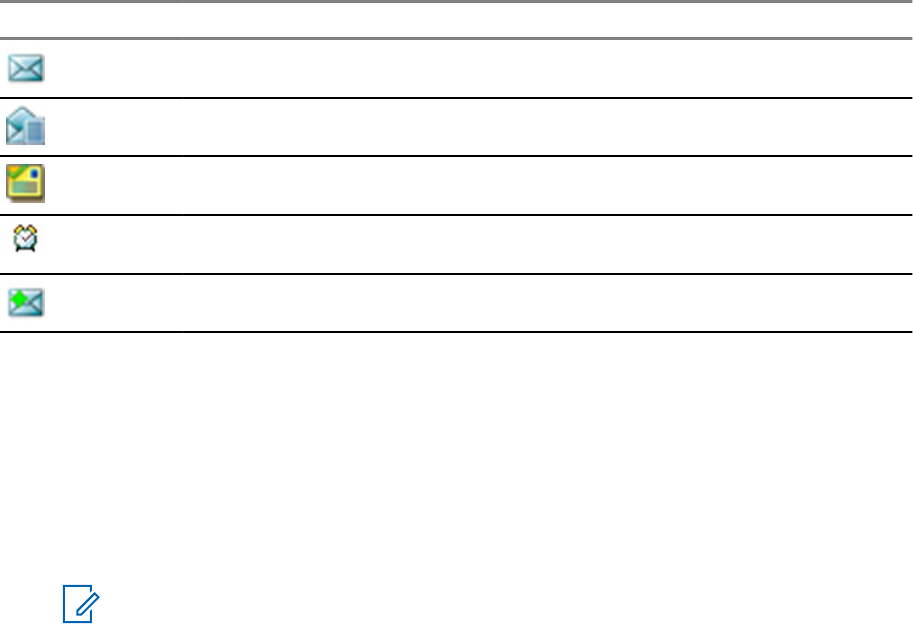
•Both — the radio requests reports on your messages that were received and read.
Inbox
It contains up to 100 new or old incoming messages.
Table 17: Inbox Icons
Icon Description
Unread (New) Message
Read (Old) Message
Sender Information in Message View — name or number
Time and Date Stamp in Message View — arrival time and date
Delivery Status Received — delivery status for Store & Forward messages
Messages sub-menu indicates the number of the messages. If the indication is for example 2/4, it
means that two unread and four read messages are in the Inbox.
Entering the Inbox
Procedure:
1From the home screen, press the MENU key.
2Select Messages → Inbox.
NOTICE: The status (if any) of the list is displayed for a few seconds:
•No New or Old Messages — The screen returns to the previous display within a few
seconds.
•Inbox Full — Select Ok.
Receiving New Messages
Procedure:
1New message received.
Your radio displays an animation and plays a New Mail Received tone.
2Select one of the following:
•Read — opens the entire message.
•Back — dismisses the message. You can access the message later from the Inbox.
Using Submenus in the Inbox and the Outbox
Procedure:
1From the home screen, press the MENU key.
2Select Messages → Inbox or Outbox.
Chapter 5: Main Menu
Send Feedback 75

3Highlight the required message and press MENU key.
4Select one of the following:
•Store — Saves a message as a template. Change the default template name and press Ok.
•Delete — Deletes the selected message. Press Yes to confirm.
•Delete All — Deletes all the messages in the Inbox/Outbox. Press Yes to confirm.
•Reply (only for Inbox) — Invokes the edit screen with the old message as default text and
the message originator as a recipient. After editing, press Send, the PTT button, or the SEND
key to send.
•Resend (only for Outbox) — Invokes the edit screen with previously entered text with the
same recipient. After editing, press Send, the PTT button, or the SEND key to send.
•Forward — Invokes the edit screen with the old message to send it to a different participant.
After editing, press Send, the PTT button, or SEND key to send.
•Refresh — Re-orders the message list and displays the new messages.
•Delivery Status (only for Outbox) — Shows the date and time of the message when it sent,
delivered, read, and expired was not delivered, expired was not read, failed unknown.
Embedded Number
This feature allows you to call a number from a message or to start a group call with the message
sender talkgroup.
Storing Numbers from Messages
Prerequisites: Embedded Number feature is enabled by your service provider.
When and where to use: You can save the sender's or embedded number from the message to a
new or existing contact.
Procedure:
1From the home screen, press the MENU key.
2Select Messages → Inbox.
3Highlight the required message and select Read.
4Press the PTT button.
5Radio displays a list of the numbers (including the senders number).
6Highlight the required number and press Store.
7Highlight required contact and press View.
NOTICE: To store a number for a new contact, select [New Contact] and fill out the
required fields. Press Done to save it..
8Select Edit.
9Choose the Type of the new number and press Done.
Calling Numbers in Messages
Prerequisites: Embedded Number feature is enabled by your service provider.
Chapter 5: Main Menu
76 Send Feedback
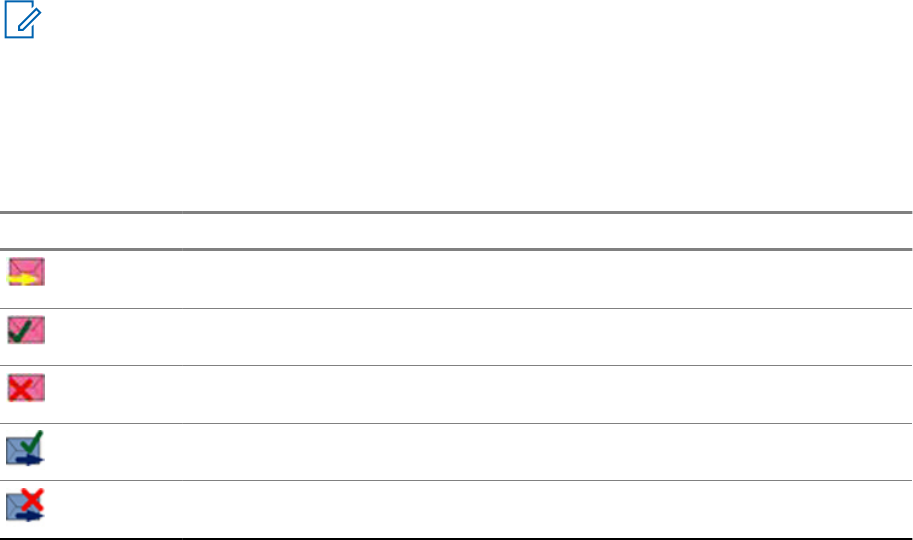
When and where to use: You can return a voice call to the sender of a message or to any number
that is embedded in the message text.
Procedure:
1From the home screen, press the MENU key.
2Select Messages → Inbox.
3Highlight the required message and select Read.
4Press the PTT button.
5Radio displays a list of the numbers (including the senders number).
6To call, highlight to the required number and press the PTT button or the SEND key.
7Select Ctype to choose the type of call (Private, Phone, or PABX).
8Press the PTT button or the SEND key.
Making Group Calls on theTalkgroup of the Message Sender
Prerequisites: Embedded Number feature is enabled by your service provider.
Procedure:
1From the home screen, press the MENU key.
2Select Messages → Inbox.
3Highlight the required message and press the PTT button.
Immediate Message
When the new immediate message is received, radio plays the New Mail Received tone and displays
the content overlapping your previous screen. All immediate messages are stored in the Inbox. If the
radio is in PIN Lock state, immediate message is displayed after correct PIN is entered.
NOTICE: This is a selling feature.
Outbox
Outbox stores all sent messages.
Table 18: Outbox Icons
Icon Description
Delivery in Progress
Delivery Accomplished
Delivery Failed
Successful Outgoing Message
Failed Outgoing Message
Chapter 5: Main Menu
Send Feedback 77
CO Box
CO Box contains incoming and outgoing Call-Out messages arranged chronologically with the newest
at the top of the list. Clicking Select on a Call-Out message headline displays more detailed
information on the item.
When the radio is in normal mode, you are able to browse through all messages in the CO Box.
However, if the radio is in the Call-Out mode, you can only browse through the information regarding
the currently ongoing Call-Out message.
Related Links
Call-Out on page 127
RMS Box
RMS Box stores all incoming and outgoing Radio Messaging System (RMS) messages, both Status
messages and Free Text messages.
WAP Box
Each WAP Push message can be loaded immediately or stored as a message in WAP Box. Then it
can be accessed by pressing MENU → Messages → WAP Box. All the WAP Push messages are
passed to the browser.
Related Links
WAP on page 118
WAP Push on page 126
Templates
This feature is used to store up to 100 predefined and your message templates. Each of the Inbox and
Outbox message can be stored as a template. Each template name and text can be edited afterwards.
Sending User-Defined Templates
Procedure:
1From the home screen, press the MENU key.
2Select Messages → Templates.
3Highlight the required template name and press Send.
4Do one of the following:
• Enter the number or press abc to select the name from your contact list. Press Send.
• Select required talkgroup from the TalkGroup List.
Setting User-Defined Templates
Procedure:
1From the home screen, press the MENU key.
2Select Messages → Templates.
3Highlight the required template and press MENU.
4Select one of the following:
Chapter 5: Main Menu
78 Send Feedback

•View — Displays template text.
•Delete — Deletes the template.
•Edit Text — Opens edit screen with the template text. Edit the text and press MENU. Select
Save Changes to save edited template, or Store to save the edited template as a new one.
•Edit Name — Opens edit screen with the template name. Press Ok to save the template.
Predefined Templates
Predefined message templates are programmed into your radio. You are allowed to perform limited
edit operations of the predefined template. You can send it, but you are not able to store the edited
template or erase it from the predefined template list.
Viewing Predefined Templates
Procedure:
1From the home screen, press the MENU key.
2Select Messages → Predefined.
3Highlight the required template and press MENU key.
4Select View.
Sending Predefined Templates
Procedure:
1From the home screen, press the MENU key.
2Select Messages → Predefined.
3Highlight the required template and press Send, the PTT button, or the SEND key.
NOTICE: You can edit the predefined template before you send it. Press the MENU key
and select Edit. Edit screen opens with the template text. You are only allowed to
replace the existing text.
Status Messages
The radio allows you to send two types of status messages: statuses and targeted statuses. Your
service provider determines which type is enabled on the radio.
Statuses can be sent either to a selected talkgroup or to a private number programmed by your service
provider. Targeted statuses can be sent to any talkgroup defined for the radio or to any private number
(from the contact list or entered manually).
Viewing a Status Message Number
Procedure:
1From the home screen, press the MENU key.
2Select Messages → Send Status.
3Press the MENU key and select View.
Chapter 5: Main Menu
Send Feedback 79
Sending Status Messages
This procedure allows you to send status messages to either a selected talkgroup or a programmed
private number. Only one option can be enabled at a time.
Prerequisites:
• If sending statuses to talkgroups is enabled: switch to the talkgroup to which you want to send a
status message.
• If sending statuses to private numbers is enabled: no action is needed, the private number is set up
by your service provider
Procedure:
1From the home screen, press the MENU key.
2Select Messages → Send Status.
3Do one of the following:
• Highlight the required status message and press Select, the PTT button, or the SEND key.
• If the status list is empty, enter a 5 digit status message number and press Send.
Targeted Status Messages
This feature enables sending status messages to user selectable addresses. By default, targeted
status messages can be sent to private or talkgroup addresses. Your service provider may restrict valid
addresses to numbers stored in Contacts.
Sending Targeted Status Messages
Procedure:
1From the home screen, press the MENU key.
2Select Messages → Send Status.
3Do one of the following:
• Highlight the required status message and press Select, the PTT button, or the SEND key.
• If the status list is empty, enter a 5 digit status message number and press Send.
4Do one of the following:
• Enter the number or press abc to select the name from your contact list. Press Send.
• Select required talkgroup from the TalkGroup List.
The display shows one of the following delivery reports:
•Status Sent.
•Status Failed.
Contacts
This sub-menu stores all your contact numbers. Each entry requires the following information:
•Name — if you store more than one number to one contact, this entry is required.
•Type — each contact must be assigned to one of the following types:
Chapter 5: Main Menu
80 Send Feedback
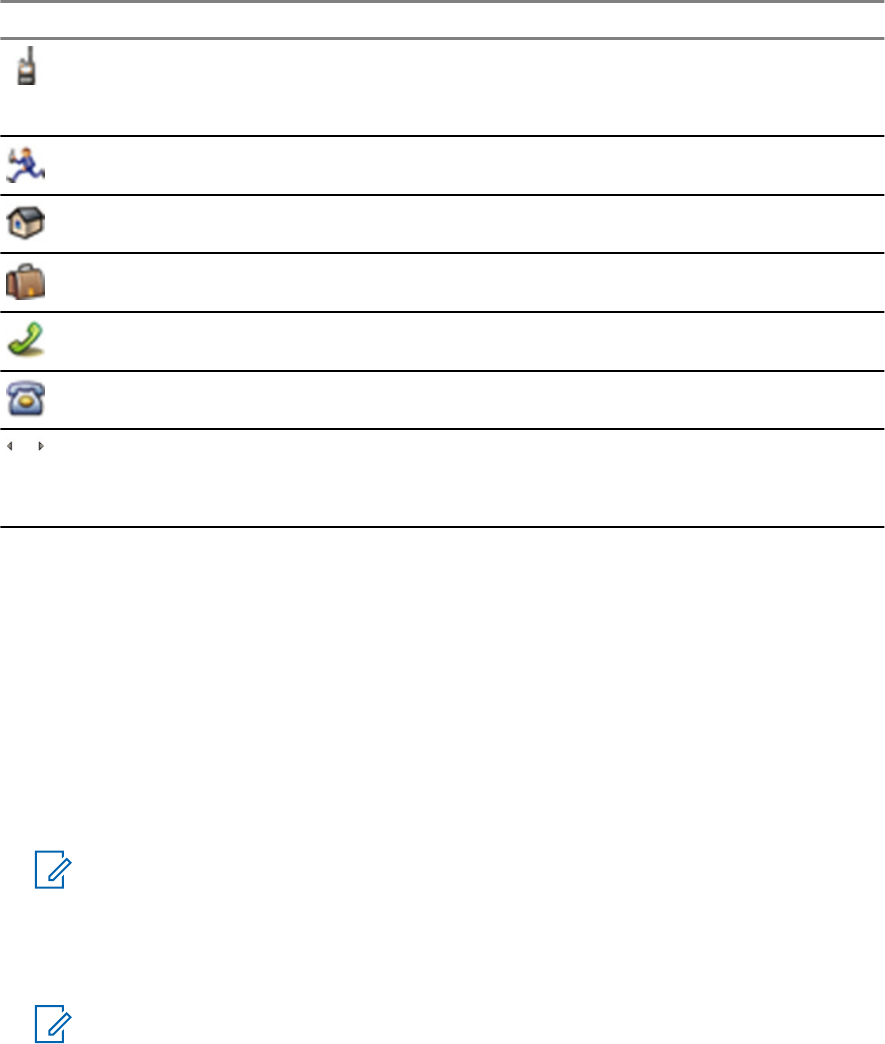
Table 19: Contact Types
Contact Icon Description
Private
Cannot have a speed dial number.
Mobile
Home
Work
PABX
Other
Pickers
Indicate more than one number in a contact.
•# (number) — each contacts entry must contain a number.
•Speed # — accept the default Speed Dial number or change it.
Creating Contacts
Procedure:
1From the home screen, select Contcs.
2Select [New Contact].
3Highlight Name and press Change. Enter the name of your contact and press Ok.
4Highlight Type and press Change. Select the required type of your contact.
NOTICE: You can use the left and right NAVIGATION keys to select the type of your contact
from the Contact Details screen.
5Highlight # (number) and press Change. Enter the number of your contact and press Ok.
6If needed, highlight Speed # and press Change. Enter the speed dial number (1– 1000) of your
contact and press Ok.
NOTICE: If the entered number exist, the radio displays Overwrite? message. Press
Yes to confirm, or No to enter the speed dial number again.
7Press Done.
You have create a contact with one number. To add additional number repeat steps 4–6.
Editing Contacts
Procedure:
1From the home screen, press Contcs.
2Highlight the contact you want to edit.
Chapter 5: Main Menu
Send Feedback 81

3Press the MENU key.
4Press Edit.
5Highlight one of the following entries and press Change to edit:
•Name
•Type
•# (number)
•Speed #
6Press Done.
Deleting Numbers
Procedure:
1From the home screen, press Contcs.
2Select a contact you want to edit.
3Use left or right NAVIGATION keys to choose the required number.
4Press MENU.
5Select Delete number.
NOTICE: If an entry contains only one number, deleting the number deletes the entry.
6Press Yes.
Deleting Contacts
Procedure:
1From the home screen, select Contcs.
2Highlight a contact you want to delete.
3Press the MENU key.
4Select Delete contact.
5Select Yes.
Checking Capacity
When and where to use: To see how many numbers are stored in the radio.
Procedure:
1From the home screen, select Contcs.
2Press the MENU key.
3Select Capacity.
4Select one of the following:
•Private
•Phone / PABX
•Contact
Chapter 5: Main Menu
82 Send Feedback

Dialing through the Contact List
Procedure:
1From the home screen, press Contcs.
2To highlight the required contact, use up and down NAVIGATION keys, or enter up to 12 characters
of the contact name.
3If the contact has more than one number, use left and right NAVIGATION keys to select the
required number.
4Press the PTT button to initiate a simplex call with a Private number. Otherwise use the SEND
key to initiate a duplex call.
Browser
This menu item activates a WAP browser that allows you to browse the Internet from your radio.
Related Links
WAP on page 118
Security
This sub-menu stores all your security settings.
PIN Protect
This feature allows you to enable PIN code authentication at the next power on. This code protects
your radio against unauthorized use.
If you are unable to unlock the radio, you can only send or receive Emergency Calls and adjust the
volume level with the ROTARY KNOB.
Related Links
Unlocking Your Radio on page 36
Changing PIN Codes on page 84
Protecting the Radio with a PIN Code
Procedure:
1From the home screen, press MENU → Security → PIN Protect.
2Select On.
3Enter 4-digit PIN code. By default it is 0000 (four zeros).
NOTICE: To increase security, set your own PIN code.
Postrequisites: Each time you turn on the terminal, PIN code is required.
Unblocking Your Radio
Prerequisites: You blocked your radio by entering incorrect PIN code for three times (by default).
Procedure:
1Radio displays Unit BlockedEnter PUK.
Chapter 5: Main Menu
Send Feedback 83

2Enter 8–digit PUK (Personal Unblocking Key) number.
NOTICE: The PUK is an eight-digit master code provided by your service provider.
3Enter the new PIN code twice.
Changing PIN Codes
Procedure:
1From the home screen, press the MENU key.
2Select Security → Change Code.
3Radio prompts for the Old Code. Enter currently used 4-digit security code (default setting is
0000).
4If the entered code matches the old code, radio prompts for the new code twice.
Your radio displays Code Accepted.
Related Links
Unlocking Your Radio on page 36
PIN Protect on page 83
Keylock Setup
The keypad lock feature allows locking the keypad to prevent pressing a key accidentally. The keypad
lock/unlock can be invoked by using an appropriate option from the radio menu or by using a
predefined menu shortcut. By default press MENU, and then * key.
Your service provider can determine which of the following elements are additionally inoperative while
the keypad is locked:
• The PTT button
• Side buttons
• The ROTARY KNOB
The ON/OFF/END/HOME key is always inoperative and the EMERGENCY button is always operative.
Related Links
Locking/Unlocking the Keys/Buttons on page 36
Keypad Lock Notification
When the keypad is locked, your service provider can configure one of the following instructions:
• None — no notification is displayed.
• Notification Only — Keys Locked is displayed.
• Notification and Instruction — Press Menu * to lock/unlock keypad is displayed.
Setting Automatic Keylock Delay
Procedure:
1From the home screen, press the MENU key.
2Select Security → Keylock Setup → Delay.
Chapter 5: Main Menu
84 Send Feedback

3Use up and down NAVIGATION keys to change the minutes and press Done.
Setting Keylock on Startup
Procedure:
1From the home screen, press the MENU key.
2Select Security → Keylock Setup → Start Locked.
3Select On/Off.
Air Encryption
Air Encryption is a feature that enables encryption of entire communication between the radio and
infrastructure, which results in increased security of calls, messages, and data.
If configured by your service provider, the radio plays a sound and displays Call & Data Not
Encrypted when encryption is on and you receive a clear call (unencrypted). This feature provides
service confidentiality between you and the system.
In the TMO Mode, when Air Encryption is enabled on you radio but cannot be supported due to an
infrastructure failure, the following icon appears on the display: .When encryption is not available in
the DMO Mode, the radio displays: .
This menu item allows you only to view air encryption state.
NOTICE: This is a selling feature.
Related Links
Status Icons on page 32
Viewing the Air Encryption State
Procedure:
1From the home screen, press the MENU key.
2Select Security → AirEncrypt.
3Your radio displays:
a Air Encryption Is Off.
b Air Encryption Is On.
Air Encryption Key Deletion
Please check with your service provider whether the radio is provided with Air interface encryption
keys. You can delete the Air interface encryption keys from the radio by entering the following
sequence: **00##.
NOTICE:
• It takes a minute for this feature to delete all the encryption keys from the radio.
• Deletion is performed in idle TMO/DMO or Emergency Operation.
CAUTION: Using this feature will disable the radio, and your service provider will need to re-
enable the radio.
Chapter 5: Main Menu
Send Feedback 85
K Validity
K (Key) is a secret key the infrastructure uses to authenticate the radio in the system. It is part of the
authentication that provides service confidentiality between your radio and the system.
Verifying K Validity
Procedure:
1From the home screen, press the MENU key.
2Select Security → K Validity.
3Your radio displays:
•K is Valid — the infrastructure can authenticate your radio.
•K is Invalid — the infrastructure is unable to authenticate your radio. Please call your service
provider to restore the key to your radio.
SCK (Air Interface Encryption Class 2)
SCK (Static Cipher Key) is a secret key used for the Air Interface Encryption Class 2. It may be used to
encrypt calls and data in TMO and DMO. The SCK air interface encryption provides service
confidentiality between radios and infrastructure when in TMO, and between radios when in DMO. A
radio is capable of being loaded with up to 32 SCKs. Specific keys are used for encrypting the air
interface.
Any mismatch between radios and/or infrastructure impacts communication – only those using the
same key as the transmitting party are able to decode and hear the communication.
TMO SCK
Use of SCKs in TMO needs to be enabled by your service provider. The SCKs used in TMO are called
TMSCKs.
DMO SCK
Use of SCKs in DMO needs to be enabled by your service provider. The SCKs used in DMO are called
DMSCKs.
Changing DMO SCK
Procedure:
1From the home screen, press the MENU key.
2Select Security → DMO SCK.
3Press Next.
4Radio displays Change to version .
5Select one of the following:
•Yes — to change the key. Your radio displays Key version changed.
•No — to leave the key. Your radio displays Code Not Changed.
Chapter 5: Main Menu
86 Send Feedback
Verifying TMSCK Validity
When and where to use: To ensure that the TMSCKs in the radio are valid and can be used for the
air interface encryption.
Procedure:
1From the home screen, press the MENU key.
2Select Security → TMSCK Validity.
3The radio displays:
•TMSCK is Valid – the radio can work encrypted in TMO.
•TMSCK is Invalid – the radio cannot work encrypted in TMO. Please contact your service
provider to restore SCKs to your radio.
Verifying DMSCK Validity
When and where to use: To ensure that the DMSCKs in the radio are valid and can be used for the
air interface encryption.
Procedure:
1From the home screen, press the MENU key.
2Select Security → DMSCK Validity.
3The radio displays:
•DMSCK is Valid – the radio can work encrypted in DMO.
•DMSCK is Invalid – the radio cannot work encrypted in DMO. Please contact your service
provider to restore SCKs to your radio.
Covert Mode
This feature enables you to completely shut down all visible and audible alerts and notifications making
the radio unnoticeable even in a silent and dark environment.
When your radio is in the Covert Mode, you cannot enter the following menu items of the Setup menu.
•Set Volume
•Tones
•Backlight (in Display menu item)
When the Covert Mode is turned on:
• All tones are set to Off (corresponding to All Tones menu entry).
• The private speaker is set to Off.
• The dimmer state is set to covert (this state is not selectable using the BACKLIGHT key.)
• The wallpaper is disabled.
• The screen saver is disabled.
• The Covert Mode color palette is activated.
The radio powers up in the mode set before turning off. Thus if the Covert Mode was set before turning
off, the radio turns on in the Covert Mode .
When the Covert Mode is turned off, all the changed settings are reverted to the previous state.
When using the Covert Mode, a low audio accessory should be connected to the radio. The correct low
audio accessory is the GCAI Handset, or the older style handset connected through the junction box.
Chapter 5: Main Menu
Send Feedback 87

This feature can be used as the One-Touch Button.
Activating the Covert Mode
Procedure:
1From the home screen, press the MENU key.
2Select Security → Covert Mode.
3Select one of the following:
•On — all tones are set to off, and the backlight and the LED are disabled immediately. The
group audio is routed to the earpiece. The radio displays Covert Mode On.
•Off — all settings for tones, backlight and audio are restored. The radio displays Covert
Mode Off.
SDS Remote Control
SDS Remote Control is a feature that enables to remotely control behavior and configuration of the
radio via special SDS messages. The messages can be sent both in TMO and DMO (including the
Repeater Mode) by any radio capable of controlling other radios. During the execution of the Remote
Control messages, depending on your service provider settings, the radio can play a tone, vibrate, or
display an appropriate icon in the status icon area.
NOTICE: This is a selling feature.
Setting SDS Remote Control
When and where to use: To enable/disable support of special SDS messages that allow remote
control of the radio.
Procedure:
1From the home screen, press the MENU key.
2Select Security → Remote Control.
3Select On to enable, or Off to disable remote control.
Setup
This sub-menu allows you to change your radio configuration.
Ring Style
This sub-menu allows you to set the incoming call ring style.
Setting Ring Style
Procedure:
1From the home screen, press the MENU key.
2Select Setup → Ring Style.
3Select one of the following:
•Duplex — To set the new ring style to all duplex calls.
Chapter 5: Main Menu
88 Send Feedback

•Simplex — To set the new ring style to all simplex calls.
NOTICE: Upon entry into this sub-menu, the display shows the current ring style used.
4Scroll to the desired style and press Select.
NOTICE: New ring style is played immediately for a few seconds. If necessary, adjust the
volume level.
Set Volume
This menu item allows you to adjust Voice, Duplex, Simplex, Keypad, and Tones volume for the
Speaker and the Earpiece.
Related Links
Volume Adjustment Mode on page 91
Setting Volume
Procedure:
1From the home screen, press the MENU key.
2Select Setup → Set Volume.
3Select Speaker or Earpiece.
4Select one of the following:
•Voice — sets the volume level for voice.
•Duplex — sets the volume level for duplex ringtones.
•Simplex — sets the volume level for simplex ringtones.
•Keypad — sets the volume level for keypad tones.
•Tones — sets the volume level for alert tones.
NOTICE: If the display shows only one option Volume, you can adjust all of the above
settings at once. You have the option to change the settings individually when the
Volume Adj. Mode is set to Individual.
5Press right or left NAVIGATION key to change the value.
Related Links
Setting Volume Adjustment Mode on page 91
Language
This sub-menu allows you to change the language of the radio.
Setting Language
Procedure:
1From the home screen, press the MENU key.
2Select Setup → Language.
3Select desired language.
Chapter 5: Main Menu
Send Feedback 89

Data Setup
This menu item allows you to set up your radio to transmit and receive data from the external device.
To connect your radio accessory connector to the external device, use the PMKN4104 cable. The
external device must run an application complying with the TETRA standards.
NOTICE:
• Data services are available only in TMO Mode.
• Data services are blocked in TXI Mode.
Setting Data Function
Procedure:
1From the home screen, press the MENU key.
2Select Setup → Data Setup.
3Select one of the following:
•Voice Only — Your radio receives and transmits voice calls only.
•Data Only — Your radio acts as a modem. It rejects incoming and outgoing voice calls
(except for Emergency Calls), status and text messages.
•Voice & Data — Your radio acts as a modem but voice calls have priority over data calls and
can interrupt them.
Audio
This menu item allows you to adjust your radio audio settings.
Audio Profiles
An audio profile is a set of audio parameters, such as the volume of alert tones, that are configured by
your service provider to fit a particular operating environment. For example, the audio parameters can
be adjusted to situations when the radio operates on a noisy street.
If programmed, the radio displays a name of a currently used audio profile (on the home screen) and/or
an appropriate icon associated with the profile (in the status icon area). Your service provider can
configure a maximum of two audio profiles.
For a detailed description of a specific audio profile, contact your service provider.
Setting Audio Profiles
When and where to use: To adjust the audio parameters of the radio its current operating
environment.
Procedure:
1From the home screen, press the MENU key.
2Select Setup → Audio → Audio Profile.
3Select a required profile.
Chapter 5: Main Menu
90 Send Feedback
Volume Adjustment Mode
You can set the volume to Individual or Common. When it is set to Individual, the volume level for
Voice, Duplex, Simplex, Earpiece, Speaker and Keypad can be set per user preferences. When set
to Common, the audio has one setting for all items.
Related Links
Set Volume on page 89
Setting Volume Adjustment Mode
Procedure:
1From the home screen, press the MENU key.
2Select Setup → Audio → Volume Adj. Mode.
3Select one of the following:
•Individual — You can set Duplex, Simplex, Earpiece, Speaker and Keypad per your
preferences in MENU → Setup → Set Volume.
•Common — You can set one value for all the items in MENU → Setup → Set Volume.
Related Links
Setting Volume on page 89
Tones
This field sets the volume level for the tones set.
Keypad Tone
You can activate/deactivate keypad tone at every key press.
Setting Keypad Tone
Procedure:
1From the home screen, press the MENU key.
2Select Setup → Tones → Keypad Tone.
3Select one of the following:
•On — Activates keypad tone.
•Off — Deactivate keypad tone.
All Tones
You can activate/deactivate all tones.
Setting All Tones
Procedure:
1From the home screen, press the MENU key.
2Select Setup → Tones → All Tones.
Chapter 5: Main Menu
Send Feedback 91
3Select one of the following:
a On — Activates all the tones.
b Off — Deactivates all the tones.
Talk Permit
You can set a different tone upon pressing the PTT button.
Setting Talk Permit
Procedure:
1From the home screen, press the MENU key.
2Select Setup → Tones → Talk Permit.
3Select one of the following:
•No Tone — No tone heard upon pressing the PTT button.
•Short Tone — Short tone heard upon pressing the PTT button.
•Normal Tone — Factory-default tone heard upon pressing the PTT button.
Clear to Send
You can activate/deactivate tone for the transmitting radio that the receiving radio is ready to accept
the transmission.
Setting Clear to Send
Procedure:
1From the home screen, press the MENU key.
2Select Setup → Tones → Clear to send.
3Select one of the following:
•Tone On — Activate clear to send tone.
•Tone Off — Deactivates clear to send tone.
Periodic Alert
You can activate/deactivate periodic tone indication for the missed calls and the unread messages. For
each notification, your radio generates an unread message tone with the amber LED color indication.
Setting Periodic Alert
Procedure:
1From the home screen, press the MENU key.
2Select Setup → Tones → Periodic Alert.
3Select one of the following:
•Alert — Activates/deactivates periodic tone.
•Period — Indicates the time between each periodic tone.
Chapter 5: Main Menu
92 Send Feedback

D-PTT Tones
This menu item contains the settings for the Double PTT feature.
The Double PTT feature allows you to send a tone pattern (single, double, or triple) when the radio is in
idle or the Group Call mode by pressing the PTT button twice.
After the D-PTT tone is played, the user can press and hold the PTT button once again to get the
permission to talk. Otherwise, if the user presses the PTT button while the D-PTT tone is played, it is
ignored.
After the D-PTT tone is sent keeping the PTT button pressed, it results in permission to talk. The D-
PTT tone is not audible on a sending radio.
NOTICE: This feature needs to be enabled by your service provider.
Setting D-PTT Tones
Procedure:
1From the home screen, press the MENU key.
2Select Setup → Tones → D-PTT Tones.
3Select one of the following:
•D-PTT Mode — Activates/deactivates D-PTT tone.
•Tone Style— Indicates how many times the D-PTT tone is played.
Display
This menu item allows you to adjust your radio display settings.
Related Links
Display on page 30
Setting Font Level
When and where to use: To increase/decrease text size so you can adjust the interface readability to
existing conditions.
Procedure:
1From the home screen, press the MENU key.
2Select Setup → Display → Font Level.
3Select one of the following:
•1 – default size of the text.
•2 – large size of the text. Keep in mind that less text can be displayed.
In some languages number of available font levels can be decreased.
Setting Large Idle Font
When and where to use: To enable/disable large font on the home screen.
Procedure:
1From the home screen, press the MENU key.
Chapter 5: Main Menu
Send Feedback 93

2Select Setup → Display → Large Idle Font.
3Select On to enable, or Off to disable displaying large font on the home screen.
NOTICE: Large Idle Font is not available in some languages.
Setting Extended Status Icons
Procedure:
1From the home screen, press the MENU key.
2Select Setup → Display → Extended Status Icons.
3Select one of the following:
•Disabled – the radio always displays icons in normal size.
•Idle Only – the radio displays enlarged icons only on the home screen.
•Always – the radio displays enlarged icons both on the home screen and when browsing
though the radio menu.
Setting Screen Saver
Procedure:
1From the home screen, press the MENU key.
2Select Setup → Display → Screen Saver.
3Select one of the following:
•Activate — To activate/deactivate this feature.
•Text — To set the text on the screen saver when this feature is activated.
Setting Backlight
Procedure:
1From the home screen, press the MENU key.
2Select Setup → Display → Backlight.
3Select one of the following:
•Auto – backlight is triggered by turning on the radio, by pressing any key on the device or on
the accessory that is connected to it. Also getting signal from the services like: Call-Out
message, DGNA and TX timeout during priority call are going to turn on the backlight.
•Semi Auto – backlight is turning on when you are switching on the radio or pressing a button
assigned to the backlight feature.
•Manual – backlight is toggled by pressing the BACKLIGHT key.
•On – backlight is always on.
NOTICE: Setting the backlight intensity level by pressing the BACKLIGHT key changes
the LED, keypad backlight, and EMERGENCY button backlight intensity.
Chapter 5: Main Menu
94 Send Feedback

Setting Wallpaper
When and where to use: To change the look of the home screen.
Procedure:
1From the home screen, press the MENU key.
2Select Setup → Display → Wallpaper.
3Select one of the following:
•On — To activate this feature.
•Off — To deactivate this feature.
Time and Date
This sub-menu controls the displayed time and date on the home screen.
NOTICE: If the Home Display Text Message feature is enabled, Home Mode Display Text may
cover time and date, depending on the Configurable Idle Screen settings.
NOTICE: Infrastructure synchronizes the time and date. When not within the infrastructure
signal range you can set the values manually.
Setting Time and Date on the Display
Procedure:
1From the home screen, press the MENU key.
2Select Setup → Time & Date → Display.
3Select one of the following:
•Time & Date — Your radio displays time and date.
•Time Only — Your radio displays time only. Format Date sub-menu is disabled.
•Date Only — Your radio displays date only. Format Time sub-menu is disabled.
•Off — Your radio does not display time nor date. Format menu is disabled.
Related Links
Display on page 30
Display on page 93
Setting the Time Format
Prerequisites: If MENU → Setup → Time & Date → Display is set to Time & Date or Time Only.
Procedure:
1From the home screen, press the MENU key.
2Select Setup → Time & Date → Format → Format Time.
3Select one of the following:
•12-Hour — Displays the time with am (before noon) or pm (after noon) indication.
•24-Hour.
Chapter 5: Main Menu
Send Feedback 95

Setting the Time Manually
When and where to use: If the time cannot update automatically through the infrastructure.
Procedure:
1From the home screen, press the MENU key.
2Select Setup → Time & Date → Set → Set Time.
3Enter current time using NAVIGATION keys or keypad.
4Press Done.
Setting the Date Format
Prerequisites: If MENU → Setup → Time & Date → Display is set to Time & Date or Date Only.
Procedure:
1From the home screen, press the MENU key.
2Select Setup → Time & Date → Format → Format Date.
3Select (D — day, M — month, Y — year):
•DD/MM/YY
•MM/DD/YY
•DD-MON-YY
•YY/MM/DD
Setting the Date Manually
When and where to use: If the time cannot update automatically through the infrastructure.
Procedure:
1From the home screen, press the MENU key.
2Select Setup → Time & Date → Set → Set Date.
3Enter current time using NAVIGATION keys or keypad.
4Press Done.
Setting Time Offset
Procedure:
1From the home screen, press the MENU key.
2Select Setup → Time & Date → Set → Time Offset.
3Enter time offset using NAVIGATION keys.
NOTICE: You can adjust the offset value, with 15 minute steps, up to 14 hours ahead or
behind.
4Press Done.
Chapter 5: Main Menu
96 Send Feedback

Setting Automatic Updates for the Time and Date
Procedure:
1From the home screen, press the MENU key.
2Select Setup → Time & Date → System Update.
3Select one of the following:
•Off — All the infrastructure informations are ignored. The radio uses internal time and offset.
•Time Only — Time displayed is calculated from the offset programmed by your service
provider added or subtracted from the infrastructure time.
•Time & Offset — Time and offset are updated after receiving from the infrastructure.
Active Accry (Accessory) Type
This menu item allows you to choose which of the accessory selection mode is active.
Selecting the Active Accessory (Accry) Type
When and where to use: Use this menu item to determine which microphone has priority during
Alternating Hot Microphone or Ambience Listening.
Procedure:
1From the home screen, press the MENU key.
2Select Setup → Active Accessory Type.
3Select one of the following:
•Control Head Accry — Higher priority is given to the microphone connected to the control
head.
•Transceiver Accry — Higher priority is given to the microphone connected to the
transceiver.
•Control Head Accry — Higher priority is given to the microphone connected to the control
head. Applicable to RECH.
•Transceiver Accry — Higher priority is given to the microphone connected to the
transceiver. Applicable to RECH.
•Front Accry — Higher priority is given to the microphone connected to the front accessory
connector. Applicable to TSCH.
•Rear Accry — Higher priority is given to the microphone connected to the rear accessory
connector. Applicable to TSCH.
NOTICE: In case the PTT on any connected accessory is pressed, the highest priority is
assigned to that accessory.
Volume Cntrl (Control)
This menu item allows you to determine which audio output device, speaker or earpiece, is being
adjusted when you turn the ROTARY KNOB.
Setting Volume Cntrl (Control)
Procedure:
1From the home screen, press the MENU key.
Chapter 5: Main Menu
Send Feedback 97

2Select Setup → Volume Cntrl.
3Select one of the following:
•Earpiece — By turning the ROTARY KNOB you control earpiece volume.
•Speaker — By turning the ROTARY KNOB you control speaker volume.
Accry (Accessory) Setup
This menu item allows you to manually configure audio accessories that do not install automatically
after plugging them in. Accessories intended for the control head and the transceiver differ and are
configured separately.
NOTICE: One control head can support only one external speaker at the same time, either a
speaker connected to the control head, or to the transceiver. When you select one external
speaker, the other becomes unselectable from the menu.
Configuring Control Head Accessories
When and where to use: Use this menu item to configure audio accessories for the control head.
Procedure:
1From the home screen, press the MENU key.
2Select Setup → Accry Setup → CH Accry.
3Select one of the following:
•GCAI Fronthead — Contains a list of preconfigured accessories that can be connected to
the front connector on the RECH.
•Secondary Accry — Contains a list of preconfigured accessories that can be connected to
Hearer Speaker Microphone (HSM).
•GCAI Backhead — Contains a list of preconfigured accessories that can be connected to
the back connector on the RECH.
•Visor Mic Backhead — Contains a list of preconfigured visor microphones that can be
connected to the back connector on the RECH.
•Ext Speaker Backhead — Contains a list of preconfigured external speakers that can be
connected to the back connector on the RECH.
•Second Mic Cradle — Contains a list of preconfigured microphones that can be connected
to the TSCH cradle.
•Ext Speaker Cradle — Contains a list of preconfigured speakers that can be connected to
the TSCH cradle.
NOTICE: Lists of accessories are configured by your service provider.
Configuring Transceiver Accessories
When and where to use: Use this menu item to configure audio accessories for the transceiver.
Procedure:
1From the home screen, press the MENU key.
2Select Setup → Accry Setup → Transceiver Accry.
3Select one of the following:
Chapter 5: Main Menu
98 Send Feedback

•Visor Mic Rear Accry — Contains a list of preconfigured visor microphones.
•Handset Rear Accry — Contains a list of preconfigured handsets.
•Fist Mic Rear Accry — Contains a list of preconfigured fist microphones.
•Ext Spkr Rear Accry — Contains a list of preconfigured external speakers.
All accessories from the above lists must be connected to the connector at the rear of the
transceiver
NOTICE: Lists of accessories are configured by your service provider. Lists that do not
contain any accessory do not appear in the menu structure.
Book On
This menu item allows you to edit RUA/RUI feature settings to automatically accept or reject book on
requests.
Related Links
RUI on page 108
RUA/RUI on page 118
Editing Book On Settings
Procedure:
1From the home screen, press the MENU key.
2Select Setup → Book on Setup.
3Select one of the following:
•Book on Accept — Radio accepts all the book on requests.
•Book on Reject — Radio rejects all the book on requests without any notification.
Rotary Knob
This menu item allows you to set all the related functionality of the ROTARY KNOB.
Setting Rotary Knob Mode
Procedure:
1From the home screen, press the MENU key.
2Select Setup → Rotary Knob → Rotary Mode.
3Select one of the following:
•Dual — Both modes are available. Turn the ROTARY KNOB to adjust the volume or press and
then turn to switch to a different talkgroup.
•Volume — The knob is used only as a volume control. Turn it clockwise to increase the
audio volume level.
•Scroll — The knob is used only to change the talkgroup, or in the menu to scroll menu items.
Chapter 5: Main Menu
Send Feedback 99

NOTICE: If you choose Scroll and the display shows:
•Scroll Selected — To adjust volume level go to the main menu, select Setup → Set
Volume.
•Function Keys are set to Adjust Volume — You can use your programmable SIDE
buttons to adjust volume.
NOTICE: The ROTARY KNOB and the SIDE buttons are paired. When the ROTARY KNOB
mode is set to Volume or Dual, the SIDE buttons support the One-Touch Button feature.
Related Links
One-Touch Button Feature on page 39
Setting Rotary Lock
Procedure:
1From the home screen, press the MENU key.
2Select Setup → Rotary Knob → Rotary Lock.
3Select one of the following:
•Locked — Locks ROTARY KNOB, you can unlock it by selecting Unlocked or by pressing and
holding ROTARY KNOB.
•Unlocked — Unlocks the ROTARY KNOB.
•Disabled — Locking function is unavailable. Your ROTARY KNOB is unlocked all the time.
Setting In Keypad Lock
When and where to use: To set behavior of the rotary knob when the keypad is locked.
Procedure:
1From the home screen, press the MENU key.
2Select Setup → Rotary Knob → In Keypad Lock.
3Select one of the following:
•Lock None — Scrolling and volume setting functionality is available.
•Lock Volume — ROTARY KNOB can be only used for scrolling.
•Lock Scroll — ROTARY KNOB can be only used for setting the volume.
•Lock Both — Scrolling and volume setting functionality is unavailable.
Setting Rotary Knob Wrap Around
Procedure:
1From the home screen, press the MENU key.
2Select Setup → Rotary Knob → Wrap Around.
3Select one of the following:
•On — Scrolling through the talkgroup list is looped or is moved to the next folder.
•Off — Scrolling through the talkgroup list stops after reaching first or last talkgroup in the
current selected folder.
Chapter 5: Main Menu
100 Send Feedback

NOTICE: Only when Wrap Around is set to On and the Scroll Range is set to Scroll To
Next, you are able to scroll through all the talkgroups and folders.
Setting Rotary Knob Scroll Range
Procedure:
1From the home screen, press the MENU key.
2Select Setup → Rotary Knob → Scroll Range.
3Select one of the following:
•Stay In Range — Scrolling through the talkgroups in the current folder only.
•Scroll To Next — Scrolling through all the talkgroups and folders.
NOTICE: Only when Wrap Around is set to On and the Scroll Range is set to Scroll To
Next, you are able to scroll through all the talkgroups and folders.
Setting Rotary Knob Talkgroup Selection
Procedure:
1From the home screen, press the MENU key.
2Select Setup → Rotary Knob → Confirm TG Sel..
3Select one of the following:
•On — You need to confirm the talkgroup selection by pressing Select or pressing the PTT
button to immediately start a call on a new talkgroup.
•Off — Attaches to the selected talkgroup without any additional prompt
Group Setup
This sub-menu allows you to set the operation parameters, scanning and my groups folder.
Standard Home Group
This menu item allows you to configure the standard home group to be used during start up and when
changing modes: TMO –> DMO and TMO –> Repeater.
Related Links
Operations Parameters on page 101
Operations Parameters
When and where to use: If you want to define the radio mode and the talkgroup at the radio startup,
and when changing modes TMO->DMO and TMO-> Repeater.
Procedure:
1From the home screen, press the MENU key.
2Select Group Setup → Operations Parameters.
3Select Startup. Select one of the following:
•TMO – the radio powers up in TMO mode.
•DMO – the radio powers up in DMO mode.
Chapter 5: Main Menu
Send Feedback 101
•Last Selected – the radio powers up in the mode it was in when last powered down.
4Select Home Group Startup. Select one of the following:
•Last Selected – the radio enters the TMO/DMO talkgroup which was last selected before
power down.
•Home Group – the radio enters the Home Group (TMO or DMO) at power up, depending on
the radio mode entered at power up.
5Select HGr TMO->DMO/Rep. Select one of the following:
•Last Selected – when changing modes the radio enters the DMO Talkgroup last selected,
i.e. the DMO Talk Group active last time the Radio was in DMO Mode. If Group Mappings
are configured, they will take precedence and the DMO Talkgroup mapped to the current
TMO Talkgroup is used.
•Group Mappings – when changing modes the radio enters the DMO Home Group unless a
Group Mapping is configured. If Group Mappings are configured, they will take precedence
and the DMO Talkgroup mapped to the current TMO Talkgroup is used.
•Home Group – when changing modes the radio enters the DMO Home Group, ignoring
possible group mappings.
6Select TMO Home Group – configures the TMO Home Group/Home Folder.
7Select DMO Home Group – configures the DMO Home Group.
Related Links
Standard Home Group on page 101
Scan
This menu item allows you to activate/deactivate scanning, view the active scan list, and edit the scan
lists. This feature is available only for the TMO Mode. Your radio joins any group call as long as this
group is defined in the scan list and scan is turned on.
Related Links
Activating Talkgroup Scanning on page 39
Activating Talkgroup Scanning
When and where to use: If you want to monitor any TMO Group Call in the defined talkgroup list.
Procedure:
1From the home screen, press the MENU key.
2Select Group Setup → Scan → Scanning.
3Select Select List and then a list name.
Your radio displays list name Selected.
4Select Scanning → On.
Your radio is scanning on the predefined scan list.
Chapter 5: Main Menu
102 Send Feedback

Related Links
Scan on page 102
Setting Talkgroups in the Active Scan List
When and where to use: If you want to edit talkgroups in the active scan list.
Procedure:
1From the home screen, press the MENU key.
2Select Group Setup → Scan → Active List.
NOTICE: If Scanning is Off is displayed, go to Group Setup → Scan → Scanning →
On to enable scanning.
3Select View and highlight the required talkgroup.
4Press MENU.
5Select one of the following:
•Delete — Erases this group from the active scan list.
•Priority and select new priority to Low, Medium or High.
Setting Scan Lists
When and where to use: If you want to set up any scan list.
Procedure:
1From the home screen, press the MENU key.
2Select Group Setup → Scan → Scan Lists.
3Highlight required scan list and press MENU to see additional settings:
•Rename — Enters new name for that scan list.
•Capacity — Displays the number of assigned and unassigned talkgroups for the scan list.
•Clear — Deletes all the talkgroup assigned to that scan list.
•Add Group — Adds a talkgroup to the scan list. Select one talkgroup from your talkgroup
folders and assign appropriate priority.
•Edit — Changes the priority of the required talkgroup or deletes it.
Deleting Talkgroups from Scan Lists
Procedure:
1From the home screen, press the MENU key.
2Select Group Setup → Scan → Scan Lists.
3Highlight the required scan list and press MENU → Edit.
4Highlight the required talkgroup and press MENU → Delete.
My Groups
My Groups is equivalent to Favorites (next section). Both menu items contain shortcuts to favorite
talkgroups and contact numbers, as well as allow to perform the same operations. For a detailed
description of the feature, please refer to Favorites.
Chapter 5: Main Menu
Send Feedback 103

Favorites
Favorites contains shortcuts to frequently used talkgroups and contact numbers that are organized in
favorite folders.
To quickly access favorite folders, from the home screen press the up NAVIGATION key. To scroll through
items inside favorite folders, you can either use the NAVIGATION keys or the ROTARY KNOB.
Making Private Calls to Favorite Contact Numbers
Procedure:
1To select a contact number you want to call, from the home screen do one of the following:
• Press the right or left NAVIGATION key.
• Go to Optns → TG by Folder, select the required favorite folder, and highlight the contact
number.
2When you are in the following mode:
aTMO — For a simplex call, press and release the PTT button. You hear a ringing tone.
Otherwise, press and hold the PTT button. Wait for the talk permit tone before talking, and
release the PTT button to listen. For a duplex call, press and release SEND key. You hear a
ringing tone.
bDMO — Only simplex call is available. Press and hold the PTT button. Wait for the talk
permit tone before talking, and release the PTT button to listen.
3To end the call, press the END key.
NOTICE: If you are using the fist microphone or the telephone style handset, replace it
firmly on it's clip or holder when done.
Adding Folders to Favorites
Prerequisites: Favorites contains less than three favorite folders.
Procedure:
1From the home screen, press the MENU key.
2Select Favorites → [New Folder]
3Enter a name and select Ok.
Adding Contact Numbers to Favorites
Procedure:
1From the home screen, press the MENU key.
2Select Contacts
3Highlight a contact that you want to add to Favorites and using the left or right NAVIGATION key
select the required number.
4Press the MENU key and select Add to Favorites.
5Select a folder you want to add the contact number to and press Select.
Adding Talkgroups to Favorites
Prerequisites:
Chapter 5: Main Menu
104 Send Feedback

To add a DMO talkgroup, ensure that the radio is in DMO.
To add a TMO talkgroup, ensure that the radio is in TMO.
Procedure:
1From the home screen, press the Optns key.
2Select one of the following:
•TG by Folder – contains talkgroups arranged by folders.
•TG by abc – contains talkgroups arranged alphabetically.
3Find and highlight a talkgroup that you want to add to Favorites.
4Press the MENU key and select Add to Favorites.
5Select a folder you want to add the talkgroup to and press Select.
Related Links
Entering DMO Mode on page 53
Managing Folders in Favorites
Procedure:
1From the home screen, press the MENU key.
2Select Favorites.
3Highlight a required folder.
4Press the MENU key.
5Select one of the following:
•Rename Folder – changes the name of the folder. Enter a new folder name and press Ok.
•Delete Folder – removes the selected folder from Favorites. Press Yes to confirm deletion.
NOTICE: You cannot delete the last favorite folder or a folder that contains at least
one non-erasable item.
Deleting Items from Favorites Folder
When and where to use: To delete a single contact number or a talkgroup from a favorite folder.
Procedure:
1From the home screen, press the MENU key.
2Select Favorites.
3Select a folder containing the item you want to remove.
4Highlight the item and select Delete. Press Yes to confirm deletion.
Deleting All Items from Favorite Folders
When and where to use: To delete all contact numbers and talkgroups stored in a favorite folder.
Procedure:
1From the home screen, press the MENU key.
2Select Favorites.
Chapter 5: Main Menu
Send Feedback 105

3Select a required folder.
4Press the MENU key and select Delete All. Press Yes to confirm deletion.
My Info
This sub-menu allows you to view your own private, phone, and radio info.
Viewing and Modifying Personal Information
Procedure:
1From the home screen, press the MENU key.
2Select My Info.
3Select one of the following:
•My Private Num – displays your radio private number.
•My Phone Num – displays your radio phone number.
NOTICE: To modify the displayed phone number, select Edit. Type the number and
press Ok.
•Radio Info – displays radio information: manufacturer, product type, ISSI, TEI, Serial
Number, and OPTA.
NOTICE: OPTA information is optional.
Recent Calls
You can view the history of all calls:
•Dialed — calls you initiated.
•Received — calls you answered.
•Missed — calls you received but not answered or rejected.
Each list of calls may contain up to 50 numbers, the most recent call being at the top of the list. If the
number of a recent call is stored in the contact list, the name associated with the number appears in
the recent calls list. A number dialed more than once, appears only once in the list.
Viewing Recent Calls
Procedure:
1From the home screen, press the MENU key.
2Select Recent Calls.
3Select one of the following:
•Dialed
•Received
•Missed
4Select a required call from the list.
5Press the MENU key.
6Select View.
Chapter 5: Main Menu
106 Send Feedback

NOTICE: Press down NAVIGATION key to bypass first two steps.
NOTICE: Call time information is only available if the time and date are set in the radio.
Call duration is not available in the missed calls list.
Calling from Recent Calls
Procedure:
1From the home screen, press the MENU key.
2Select Recent Calls.
3Select one of the following:
•Dialed (from the home screen press SEND key to access Dialed Calls list)
•Received
•Missed
NOTICE: From the home screen press down NAVIGATION key, to access Recent Calls
menu item.
4Highlight the required call and press the PTT button for private calls or press theSEND key to
make a phone call.
NOTICE: Phone calls are only available in TMO Mode.
Storing Recent Calls to Contacts
Procedure:
1From the home screen, press the MENU key.
2Select Recent Calls.
3Select Dialed, Received or Missed.
4Press Store.
NOTICE: If Store is not assigned to the left SOFT key, the number is already stored in
your contact list.
5To store the number as a new entry, select [New Contact]. Or, to store the number to an
existing entry, select the entry, and press View then select Edit.
6With the contact type field highlighted, scroll left or right to display the contact type you want to
assign the number.
7Select Done.
Deleting Recent Calls
Procedure:
1From the home screen, press the MENU key.
2Select Recent Calls.
3Select Dialed, Received or Missed.
4Press MENU on the required call.
Chapter 5: Main Menu
Send Feedback 107

5Select Delete.
NOTICE: To erase all the calls, select Delete All.
Shortcuts
This sub-menu allows you to set up shortcuts to access frequently used menu items.
Creating Menu Shortcuts
When and where to use: To assign a shortcut for the menu item.
Procedure:
1From the home screen, press the MENU key.
2Scroll to the item you want as a shortcut.
3Press and hold MENU when the item is highlighted.
Example: Creating a shortcut to the All Tones options.
1From the home screen, press the MENU key.
2Select Setup → Tones.
3Highlight All Tones and press and hold MENU until Assign Shortcut for:All Tones is
displayed.
4Select Yes and ShortcutsKey:1 is displayed.
5Press Done.
NOTICE: To use this shortcut, from the home screen, press MENU and the key
1.
Editing Menu Shortcut Lists
Procedure:
1From the home screen, press the MENU key.
2Select Shortcuts.
3Highlight a required shortcut and press MENU.
4Select one of the following:
•Edit — Changes the assigned key. Type required number and press Ok.
NOTICE: Type a number between 1–20.
•Delete — Erases highlighted shortcut. Select Yes to confirm.
•Delete All — Erases all the shortcuts. Select Yes to confirm.
RUI
This menu item allows you to log in/out to the radio.
Related Links
RUA/RUI on page 118
Chapter 5: Main Menu
108 Send Feedback

Book On on page 99
Logging On
Procedure:
1From the home screen, press the MENU key.
2Select RUI → Log on.
3Highlight:
•User ID and press Select to enter User ID List. If you are a new user on this radio, select
[New User ID] and enter your user ID. Otherwise select your user ID from the list.
• Second line and press Edit, to enter user ID and press Ok.
4Select User PIN, enter your credentials, and press Ok.
5Logging screen is displayed.
Logging Off
Procedure:
1From the home screen, press the MENU key.
2Select RUI → Log off.
3Press Accept.
Networks
This menu item allows you to switch between the radio operation modes.
Related Links
Entering TMO / DMO Mode on page 37
Selecting Network Operation Mode on page 109
Selecting Network Operation Mode
Procedure:
1From the home screen, press the MENU key.
2Select Networks.
3Select one of the following:
•Networks Sel — Selects the network to which the radio is allowed to register.
•Trunked Mode — Switches to the mode using infrastructure.
•Direct Mode — Switches to the mode without using infrastructure.
•Repeater Mode — Switches to the Repeater Mode.
•Gateway Mode — Switches to Gateway Mode.
•TXI Mode — Select Activate to stop sending any radio transmission.
NOTICE: If the radio is in TXI Mode, it is not possible to switch from Direct Mode to
Trunked Mode or Repeater Mode, or Gateway Mode.
Chapter 5: Main Menu
Send Feedback 109
Related Links
Entering TMO / DMO Mode on page 37
Networks on page 109
Selecting Your Network
Procedure:
1From the home screen, press the MENU key.
2Select Networks → Networks Sel → Home Only.
3Your radio registers to the home network. If several home networks are defined, the radio
registers to the first available network on the list.
Using the Select Net Registration
Procedure:
1From the home screen, press the MENU key.
2Select Networks → Networks Sel → Select Net.
3Select the required network from the list.
Your radio registers to the selected network.
Using the Foreign Network Registration
When and where to use: Use this feature to migrate to another predefined network, when you are out
of the range of your network and your radio displays the No Service message.
Procedure:
1From the home screen, press the MENU key.
2Select Networks → Networks Sel → Foreign Nets.
Using Any Network
When and where to use: Your radio has lost its home network coverage and can register to any
network. Only clear authentication is supported on any network.
Procedure:
1From the home screen, press the MENU key.
2Select Networks → Networks Sel → Any Network.
3Your radio selects and registers to the network automatically from the predefined list.
Using the Migrate To Registration
When and where to use: Use this feature to migrate to another predefined network, when you are out
of the range of your network and your radio displays the No Service message.
Procedure:
1From the home screen, press the MENU key.
2Select Networks → Networks Sel and choose one of the following option:
Chapter 5: Main Menu
110 Send Feedback

•Migrate to... — Selects the required network form the list. To view the network ID press
MENU key then press Select.
•Auto — Your radio automatically attaches to the predefined network.
Location
See the GPS Location Service for more information.
Related Links
GPS Location Service on page 67
Viewing Your Position
Procedure:
1From the home screen, press the MENU key.
2Select Location → Position.
3Scroll to view the results about the last time your location was calculated.
NOTICE: To refresh your position:
• Select Position — the radio refreshes its position automatically
• Press Refresh
Viewing Testpage
Procedure:
1From the home screen, press the MENU key.
2Select Location → Testpage.
3Select one of the following:
•Position – displays detailed information on radio’s current position: time, N (latitude), E
(longitude), H (height), Sats Used (a number of tracked satellites), B (bearing), HS
(horizontal speed), LC (level of confidence).
•Power – displays detailed information on a particular satellite: PRN code, Status, Mode, C/N
(carrier-to-noise ratio).
•Version – displays detailed information on GPS version: SW (software version), HW
(hardware version), ASIC (application-specific integrated circuit), RC (release code).
Packet Data
The Packet Data (PD) Service allows you to transfer data in a TETRA system using the Internet
Protocol (IP).
NOTICE: To transfer data from a standard computer over the air, connect the computer via the
data cable PMKN4104 with your radio. Your service provider has to setup additional
applications on your computer.
If set up by your service provider it is possible to accelerate the transmission by using the Multi-Slot
Packet Data (MSPD) Service.
NOTICE: This is a selling feature.
Chapter 5: Main Menu
Send Feedback 111

TETRA Enhanced Data Services (TEDS)
TETRA Enhanced Data Services (TEDS) is an enhancement of the Packet Data feature and allows for
increased speed of data transfer.
When TEDS is enabled, an appropriate icon is displayed in the status icon area. The icon is visible
even if an infrastructure does not support TEDS – in such a situation the data is transferred by using
the standard Packet Data.
NOTICE: This is a selling feature.
Viewing Data Statistics
Procedure:
1From the home screen, press the MENU key.
2Select Packet Data.
NOTICE: Data services are only available in TMO Mode. The data option must be set to
Voice & Data or Data Only.
3Select one of the following:
•Sent Data — the number of KBs sent and throughput since current Packet Data activation is
displayed.
•Received Data — the number of KBs received and throughput since current Packet Data
activation is displayed.
•Bandwidth — active data session percentage is shown.
•Failed Transfer — the percentage of failed sent/received packets.
NOTICE: N.A. — standby packet data session.
Viewing Encryption Status
Procedure:
1From the home screen, press the MENU key.
2Select More . . . → Packet Data → Encryption.
3The encryption state of the ongoing packet data session is displayed:
•Packet Data Channel Clear
•Packet Data Channel Encrypted
•EncryptionN/A (clear)
Chapter 5: Main Menu
112 Send Feedback

Chapter 6
Features
Private Call
The Private Call, also called point-to-point, or individual call, enables calling between two individuals.
No other radio can hear the conversation. This call type can be carried out in two ways:
• Duplex call (if the system allows), in TMO Mode. Both parties can speak at the same time.
• Simplex call, in TMO or DMO Mode. Only one party can speak at a time.
When a DMO Private Call takes place, radios not involved in this call receive the channel busy
indication. The radios are identified using its radio numbers.
Interaction with the accessories:
• Fist Microphone — during the Private Call, if you hang the microphone into the clip the call ends or
the audio switches to the speakers (if connected). Exact behavior depends on your service provider
settings.
• Telephone Style Handset — during the Private Call, if you hand the handset into the holder, the call
ends or the audio switches to the speakers (if connected). Exact behavior depends on your service
provider settings.
NOTICE: To end the Private Call if audio was switched to the speaker, press ON/OFF/END/
HOME key.
To answer a Private Call, use one of the following methods:
• Press the PTT button.
• Take the Fist Microphone or Telephone Style Handset off hook. If the Handset is off hook, the
radio’s external speaker mutes and the Handset’s internal speaker activates.
• Press the SEND key on the control head. Audio is routed to audio input devices in the following
order, depending on their availability:
1A visor microphone.
2A microphone of the device that is off hook.
3A microphone that was last in use (if two devices are off hook).
Related Links
Emergency Individual Calls (Private or MS-ISDN) on page 59
Making Private Calls
Procedure:
1From the home screen, enter a number.
2If Private is not the first type of call presented, press Ctype repeatedly to select it.
3When you are in the following mode:
aTMO — For simplex calls, press and release the PTT button. You hear a ringing tone.
Otherwise, press and hold the PTT button. Wait for the talk permit tone before talking, and
release the PTT button to listen. For duplex calls, press and release the SEND key. You hear
a ringing tone.
Features
Send Feedback 113
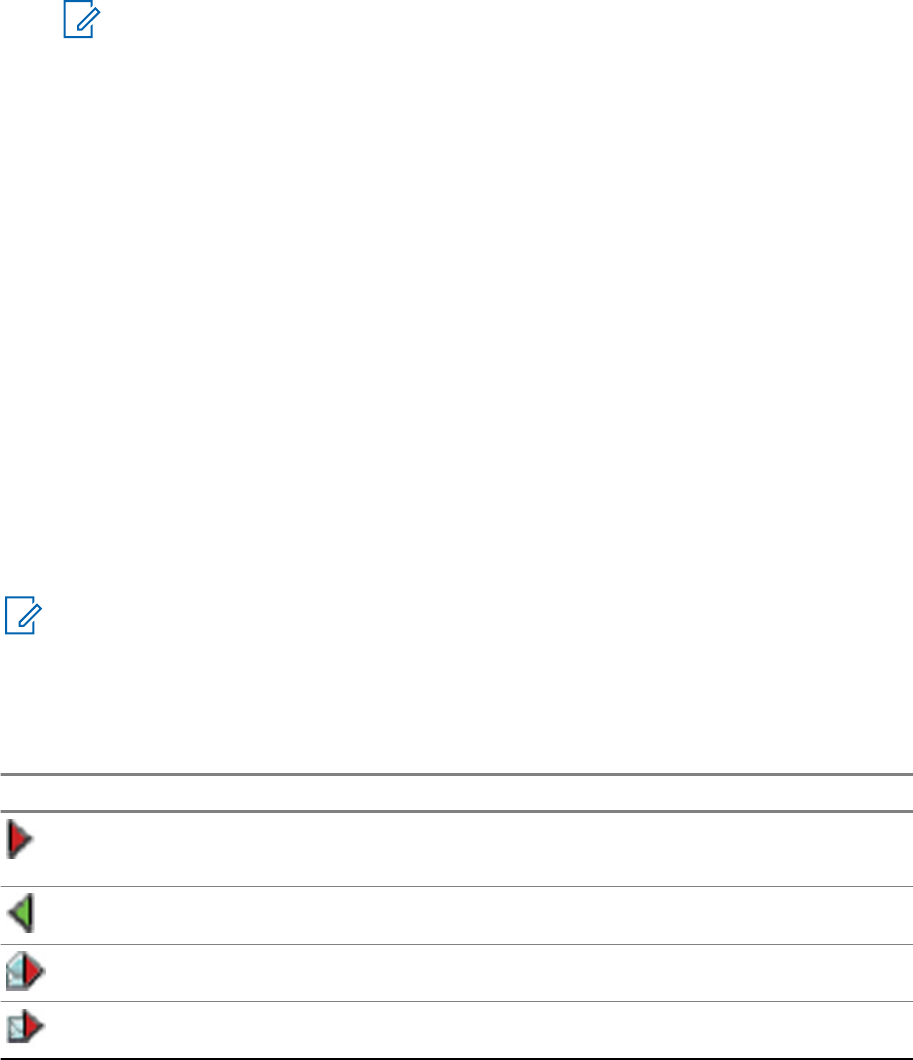
bDMO — Only simplex calls are available. Press and hold the PTT button. Wait for the talk
permit tone before talking, and release the PTT button to listen.
4To end the call, press the END key.
NOTICE: If you are using the fist microphone or the telephone style handset, replace it
firmly on it's clip or holder when done.
Radio Messaging System (RMS)
The Radio Messaging System (RMS) feature enables radio to receive and send RMS messages
through the TETRA network using the Short Data Service.
There are two types of RMS messages:
• RMS Status – a predefined code that is sent bidirectionally between the radio and the service
provider. The radio can have up to ten statuses that are assigned to numeric keys from 0 to 9. The
latest received or sent RMS status is kept on the home screen until the next power cycle. A
received RMS status is displayed in blue color font on the home screen.
RMS Free Text – a unidirectional message containing free text that is sent to the radio by the
service provider. Since this type of message is longer, the radio displays only its beginning on the
home screen and to read its remaining part, you need to go to Menu → Messages → RMS Box.
The latest RMS free text is kept on the home screen until the next power cycle.
RMS free text messages and incoming and outgoing RMS statuses (with the exception of RMS
statuses sent) are stored in the RMS Box. Its capacity is maximum ten entries for incoming and
outgoing RMS messages. If the RMS Box is full, any new incoming or outgoing RMS message
overwrites the oldest message (received or sent).
The radio receives and sends RMS messages only from and to the numbers predefined by your
service provider.
NOTICE: This is a selling feature.
RMS Icons
Table 20: RMS Icons
Icon Description
RMS Status Received
Indicates a new RMS status message just arrived.
RMS Status Sent
RMS Box Read Message
RMS Box Unread Message
Sending an RMS Status
Prerequisites: Your service provider enabled this feature and the radio is in the RMS mode.
Chapter 6: Features
114 Send Feedback

When and where to use: To send a predefined RMS status using numeric keys.
Procedure:
1Press and hold a required key. If you press the key for too short, the radio initiates a Private/
Phone/PABX call.
One-Touch Dial
This feature allows you to call by pressing and holding one of the keys (1-9).
NOTICE: If the One-Touch Button feature is enabled, One-Touch Dial is disabled. If no feature
is assigned to a button, your radio displays an Unassigned Button message.
Talkgroup Dialing by Index
This feature allows you to attach to any talkgroup by dialing its index, instead of choosing it from the
talkgroup folders and lists.
NOTICE: It is also known as Talkgroup Speed Dial.
Viewing the Talkgroup Speed Number
Procedure:
1From the home screen, press Optns.
2Select one of the following:
•TG by Folder then select the folder and highlight the required talkgroup.
•TG by abc enter up to 15 characters to narrow the talkgroup names and highlight the
required talkgroup.
3Press MENU → View.
Example: Radio displays SpeedNum1*, which means that this talkgroup speed number is 1.
Selecting Talkgroups by Index
Procedure:
1From the home screen, enter talkgroup speed number and *.
2Press Attach.
NOTICE: To start a group call, press the PTT button.
Phone and PABX Calls
The Phone Call allows you to call a landline telephone number or a cellular mobile phone number. The
Private Automatic Branch Exchange (PABX) Call allows you to call local (office) extension numbers.
Making Phone or PABX Calls
Procedure:
1From the home screen, enter the number.
Chapter 6: Features
Send Feedback 115

2If Phone or PABX are not the first type of call presented, press Ctype repeatedly to select it.
3Press SEND key.
Phone/PABX Speed Dial
This feature allows you to dial Phone/PABX by a shortened number of up to three digits instead of the
full number. The Phone/PABX Speed # number is assigned when the dialed number is added in the
contact list.
NOTICE: This feature is available only in TMO Mode.
Using the Phone/PABX Speed Dial
Procedure:
1From the home screen, enter the predefined Phone/PABX speed dial number and # key.
2Press SEND key.
DTMF Overdial
This feature allows you to communicate with an automated answering device (for example, the voice
mail or answering machine) during an on-going private, phone or PABX call.
While in an on-going private, phone or PABX call, press the DTMF keys (0-9, *, #). When pressed, the
DTMF key sounds a tone and the entered digit is displayed on the screen.
Short Number Dial
This feature allows you to dial part of the full number of the person you wish to call. Your radio
automatically completes the number.
Example: Your radio number is 4282564.
1Dial 564 (instead of 4282564, the full number).
2To place the call, press the PTT button or the SEND key.
Dual Control Head
This feature allows you to use two control heads with one transceiver. The control heads are of equal
importance and have almost identical functionality, the only difference is second PTT installed on the
Telephone Style Control Head.
In Dual Control Head mode, when you press MENU → Setup you can choose between two control
heads: CH1 and CH2. Almost all menu items inside them are common for both control heads, except
for: Set Volume, Accry Setup, and Font Level (provided that control heads are different). These
menu items are configured separately for each control head.
NOTICE: If this feature is enabled by your service provider, appropriate icons appear on the
display.
Check with your service provider default accessory selections and the radio behavior for all types of
calls as each control head can have different setup.
Chapter 6: Features
116 Send Feedback

Related Links
Controls and Indicators on page 24
Interactions between Control Heads
Your service provider can connect to one transceiver either two the same control heads (two Remote
Ethernet Control Heads, or two Telephone Style Control Heads), or two different control heads (one
Remote Ethernet Control Head and one Telephone Style Control Head).
You can use both control heads interchangeably for the same activity (for example, writing a
message). If you start an activity on one control head you can continue it on the second, provided that
token is free.
Token is a right to use a key or button for a period of time. If you press a key/button on one control
head, token activates on it, and no one can press anything on the second control head until token time
passes. After you release the key/button, token becomes available again and can be taken over by the
second control head. When token is activated, Key Press Token icon is visible on the display. By
default, token time is set to 3 seconds.
NOTICE: Token does not apply to EMERGENCY button and ON/OFF/END/HOME key. These can be
pressed on both control heads at any time.
If control heads are different, when you operate on one control head, the second one displays screen
saver.
Related Links
Controls and Indicators on page 24
Dual Control Head Link
Dual Control Head Link is a connection that occurs when both control heads are properly connected to
the transceiver and can communicate.
When the Dual Control Head Link is established, control heads play a tone and display Dual Control
Head icon. Full functionality is available on both devices.
When one control head cannot connect to the transceiver upon power up, the radio displays Single
Control Head icon and enters Single Control Head mode.
When one control head disconnects from the transceiver during operation:
• The active control head displays Link Error icon.
• The inactive control head displays Link Error and shows Link Error display (if power is available).
Turning on/off one control head results in simultaneous turning on/off the second control head.
Audio Accessories
Depending on a call type, voice can be routed to control heads and audio accessories connected to
them in different ways.
During an outogoing group call, voice can be heard either on one control head or on both control heads
(depending on your service provider’s settings).
During an incoming group call, voice is always heard on both control heads. However, if two
accessories are connected to one control head (to the front and the rear connector), voice is
transferred through only one of them, the one with higher priority. Priority is following (from the
highest): handset (must be off-hook), HSM, external speaker.
Private calls are always transferred to the control head that receives a call.
Chapter 6: Features
Send Feedback 117

Only one microphone/PTT can be opened at a time. The microphone that is pressed as first is allowed
to initiate the transmission.
Keys Interactions
If any key except EMERGENCY button and ON/OFF/END/HOME key are pressed on any control head, Key
Press Token icon is displayed and all keys on the other control head are blocked. This behavior is
called token and means the right to use a key or button for a period of time.
NOTICE: Your service provider can adjust the time that the keypad is blocked on the other
control head. At any time EMERGENCY button and ON/OFF/END/HOME key can be pressed on both
control heads.
RUA/RUI
Radio User Assignment (RUA) and Radio User Identity (RUI) enables authentication service. Only the
successful logon on any temporary radio, provides the full access and your permanent radio
functionality, so you can be still reached with your permanent number. A logon failure results in limited
service.
You can differentiate the RUA/RUI state by the interface color:
• Blue — you are logged on
• Gray — you are logged off
Radio States
• Full Service — user logon was successful. Your radio has full functionality.
• Limited Service — user not logged on. Specified by the service provider.
• Pseudo Log On — occurs only in the Local Site Trunking (LST). You radio has full functionality
available (depending on the service provider settings) except some services like forwarding calls.
The RUI Pseudo Log On icon is displayed.
Book On
Your service provider assigns particular radio to one person for a predefined period of time. You are
only going to see the screen with your login and the full service is granted.
Force Off
Your service provider can log you off. Radio displays Force Off.
NOTICE: This is a selling feature.
Related Links
RUI on page 108
Book On on page 99
WAP
Wireless Application Protocol (WAP) is a standard for application layer network communications in a
wireless communication environment such as TETRA network. The protocol is used to access the
mobile web from a radio through a WAP browser.
NOTICE: This is a selling feature.
Chapter 6: Features
118 Send Feedback

Related Links
WAP Box on page 78
WAP Push on page 126
WAP Browser
The Openwave Mobile Browser is a WAP-compliant user agent. The WAP browser provides all of the
basic services of a computer-based web browser. Whenever any preemptive display interrupts the
browser session, the browser needs manual reactivating to return. The WAP browser does not support
right-to-left languages (as Arabic and Hebrew); English is used instead. For the content in these
languages, the characters are not displayed.
NOTICE: Depending on the radio configuration and the network conditions, the WAP browser
may not display images properly (or may display them with a delay).
Entering the Browser
Prerequisites: From the home screen, press the MENU key. Set Setup → Data Setup to Data Only or
Voice & Data.
Procedure:
1From the home screen, press the MENU key.
2Select Browser.
3Optional: Exit the browser by pressing and holding the END key.
Entering Browser Menu Panes
Prerequisites: You are in the browser.
Procedure:
1Press Menu or MENU key.
2Usually, it brings up the Navigate pane, or the last browser menu pane.
NOTICE: If the web page you navigated to has two or more soft keys/options, the
Options pane pops up. From here, you may scroll to other panes with the left or right
navigation keys Or you may select Browser Menu and then scroll to the required pane.
Tips for Browsing
Create and use the following for easy browsing.
Creating Bookmarks through the Navigate Pane
Procedure:
1Enter the browser and browse to the required page.
2Press Menu to enter the browser menu.
3Select Mark Page.
4The screen displays the title and URL of the marked page.
5To save it:
aPress Save (or Select) to save the page in bookmarks.
Chapter 6: Features
Send Feedback 119
bSelect Menu and select an option:
•Save — Confirms the bookmark creation.
•Edit — Allows you to edit the title, folder, choice, and URL of the created bookmark.
Creating Bookmarks through the Bookmarks Pane
Procedure:
1Enter the browser.
2Scroll to Bookmarks pane.
3Select Organise (if there are no saved bookmarks), or More... .
4Select Menu.
5Scroll to New Bookmark.
6Enter the bookmark title and URL, and select its location.
7Press Save.
Using Bookmarks
Procedure:
1Enter the browser.
2Scroll to Bookmarks pane.
3Scroll to the required bookmark and select Go. The bookmark downloads the selected page
from the web.
Creating Hotkeys
Procedure:
1Enter the browser.
2Scroll to Bookmarks pane.
3Scroll to the required bookmark.
4Press MENU. Select Hotkeys.
5Select an unassigned key (0–9).
6Click Assign. The display shows the bookmark and its assigned hotkey.
Using Hotkeys
Procedure:
1Enter the browser.
2Press and hold a hotkey to download the corresponding bookmarked page from the web.
Saving Pages
When and where to use: Save a page for off-line browsing.
Procedure:
1Enter the browser and browse to the required page.
Chapter 6: Features
120 Send Feedback

2Press Menu.
3Scroll to Tools pane.
4Select Save Page. Edit the proposed page title if required. Scroll down and select Save. The
page will be saved in the Bookmarks Saved Pages folder.
Selecting Saved Pages
Procedure:
1Enter the browser.
2Scroll to Bookmarks pane.
3Select Organise (if there are no saved bookmarks), or More... .
4Select Go to enter the Saved Pages folder.
5Select a saved page and press Ok. The display shows the saved page. Depending on the saved
page, you may browse the web from here.
Disabled Packet Data Service
If there is no Packet Data Service, your radio displays Error:No Network Available when entering the
browser for the first time. Select left SOFT key to retry entering, or right SOFT key to enter the browser
menu.
When re-entering the browser with previously available Packet Data, the radio displays the last
browsed page, or the last page to which you navigated off-line.
Disabled Browser Entry
Browser entry is disabled:
• During any type of voice call, except Ambience Listening Call
• In DMO Mode
• During Emergency Mode
• During PIN lock
• Service provider has not configured this feature
• When the radio is disabled
NOTICE:
• Browser entry is enabled during Ambience Listening (AL) Call. If you navigate to previously
stored pages, the AL state remains.
• When you activate Packet Data for the first time, AL is disconnected, and you have the
same look and feel as if you were not in AL before.
Keys Usage
When the browser is active, the following usage described occurs inside or outside the editor.
Chapter 6: Features
Send Feedback 121

Table 21: Browser Keys Usage
Key Press Action
0–9 key In the editor: enters a digit and/or character de-
pending on the text entry mode selected.
Outside the editor: in a numbered list, selects
the required item list.
0–9 key (hold) In the editor: standard use.
Outside the editor: hotkey for navigating to the
numbered bookmark.
* key (press or hold) In the editor, inserts a space.
# key (press or hold) Brings up the Text Input pane, while in editor. Oth-
erwise, sounds a wrong key press.
Left or right SOFT key Selects the option that appears in the display di-
rectly above the left and right soft key (part of the
page).
Up NAVIGATION key While in list of options, moves up one line.
Up NAVIGATION key (hold) Moves up on page.
Down NAVIGATION key While in list of options, moves down one line.
Down NAVIGATION key (hold) Moves down on page.
Left NAVIGATION key Moves to the previous pane.
In the editor: moves left.
Left NAVIGATION key (hold) Functions as backward.
Right NAVIGATION key Moves to the next pane.
In the editor: moves cursor to the right and in-
serts space if at the end of the word.
Right NAVIGATION key (hold) Functions as forward.
Center of NAVIGATION keys (hold) Auto-repeat.
MENU key Brings up the browser menu.
END key Press to deactivate the browser.
SEND key Disabled in browser active state.
ROTARY KNOB Used for volume adjustment only.
EMERGENCY button Deactivates the browser. The radio enters Emer-
gency Mode.
Browser Menu Panes Overview
The browser menu includes the following panes:
Table 22: Browser Menu Panes
Menu Pane Description
Navigate Provides access to the home page and commonly used items.
Table continued…
Chapter 6: Features
122 Send Feedback

Menu Pane Description
Bookmarks Provides access, editing, and storage options to stored bookmarks and
saved pages.
History Provides access to recently visited pages and shows the position of the
currently loaded page in the history stack.
Tools Provides access to applications and utilities.
The following panes are displayed according to the context:
Table 23: Additional Menu Panes
Menu Pane Description
Options Displayed only when there are additional options for the pane or page.
Image Displayed only when an image is selected. Provides access to image de-
tails, storage, and display use.
Input Text Displayed only in text entry mode. Provides access to text entry mode (for
example: symbol).
Navigate Pane
You can select one of the following items:
•Home — for loading the home page.
•Open Page — for entering the URL.
•Search — item disabled.
•Mark Page — for creating (saving) a bookmark for the current document. A title and URL for the
bookmark are displayed, and the root folder is chosen for the location.
•Forward — for navigating to the document located one step forward in the navigation history. If
there is no forward history, this item is disabled.
•Reload — for reloading the current document.
•Advanced... — see following section.
Advanced...
From the Navigation pane select Advanced... to see the following options:
•Settings...
-Downloads — for setting download preferences. You may deactivate the downloading of
images and objects. The browser displays a special icon instead of the images and objects.
-Scroll Mode — for setting the scrolling mode and speed.
-Key Press Timeout — for setting key press time-out. This time-out is used for text entry.
-Set Proxy — select the WAP Proxy (1, 2, 3). The browser connects to the web via the selected
proxy or gateway. The network provider installs and configures the proxy. To establish a secure
session, select a secure proxy. Please ask your service provider which proxy is configured for a
secure session. Though you can choose your home page, the service provider may decide to
force its own home page on your terminal.
-Circuit Prompt — for turning on/off the circuit prompt.
-Resend Data Prompt — for turning on/off the data re-send prompt.
Chapter 6: Features
Send Feedback 123
•Security...
-Secure Prompt — for enabling/disabling the browser to inform you that it replaced a non-secure
connection with a secure connection, and the other way around.
-Current Certificate — for viewing the digital certificate identifying the server that delivers the
current document. A Certificate Authority (CA) digitally signs and thus authenticates this
certificate. Up to ten additional custom WTLS certificates can be added to the default list of
certificates installed. Please ask your service provider if you wish to have these custom WTLS
certificates added.
-CA Certificates — for viewing the digital certificates installed in the browser and digitally signed
by Certificate Authorities (CA).
-Send Referrer — for turning ON/OFF sending of the HTTP Referrer header as part of HTTP
requests. The Referrer header provides the URL of the link source to the server.
-Authentication — for turning ON/OFF the caching of HTTP Authentication credentials. HTTP
Authentication protects access to content on the server. If you try to access a protected content,
you enter your credentials (user name or password).
•Clear... — for clearing of browser data: history, cache cookies, or auto-fill.
•Restart Browser — for restarting the browser.
•About... — for showing the information about the current version of Openwave Mobile Browser.
Bookmarks Pane
If there are bookmarks in the root folder, select More... to access the Options pane. If the root folder is
empty, select Organise... then press MENU key to access the Options pane. The Options pane allows
you to manage bookmarks. The Saved Pages folder contains snapshots of saved pages.
Working with the Options Pane for Selected Bookmarks
Procedure:
1From the Bookmarks pane select More... .
2Scroll to a bookmark.
3Press MENU to open the Options pane for that bookmark.
4Select one of the following:
•Back — for displaying the page associated with the bookmark (page is downloaded if not
available in cache).
•Details — for modifying the bookmark title and URL.
•Delete — for deleting the bookmark.
•New Bookmark — for creating a new bookmark.
•New Folder — for creating a new folder.
•Move — for moving this bookmark to a new folder (or in Bookmarks).
•Delete All — for deleting all bookmarks.
•Hotkeys — for assigning hotkeys to available bookmarks.
Working with the Saved Pages Folder
Procedure:
1From the Bookmarks pane select Saved Pages folder.
Chapter 6: Features
124 Send Feedback
2The browser displays the page (snapshot) saved using Save Page in Tools pane.
3Scroll to a saved page.
4Press Menu to open the Options pane for the saved page.
5Select one of the following:
a Back — for displaying this page saved on its cache.
b Details — for modifying the page title and URL of the saved page.
c Update Page — for replacing the saved version with the current version (to be downloaded
from server).
d Delete — for deleting this page from its cache.
e Delete All — for deleting all the saved pages from its cache.
f Cancel — for exiting this pane and returning to the last page displayed.
History Pane
This pane displays the list of recently visited pages (up to nine history entries can be listed). Each
history entry shows its title, if present. Otherwise, No Title is displayed.
Navigating to Recently Visited URLs
Procedure:
1Select the URL.
2Press Ok.
Tools Pane
Procedure:
1From the Tools pane select More...
2Scroll to a document.
3Select MENU key to open the Options pane for that document.
4Select one of the following:
•Show URL — For displaying the current page URL.
•Save Page — For creating a snapshot for the current document.
•Find Text — For finding a text string in the current document.
•Copy Text — For copying text from the current document to the clipboard.
Options Pane
This pane is specific to the page or pane being displayed.
Image Pane
This pane appears in the browser menu when you enabled the download of images through Navigate
pane > Advanced... > Settings... .
The following items are available:
•Save — for saving the image in the terminal.
Chapter 6: Features
Send Feedback 125

•[Send] — for sending the image to the destination of your choice.
•Reload — for reloading the image.
•Details — for displaying the image details.
•Show Image — for showing the image on its own page.
Text Input Pane
Prerequisites: This pane is visible when the browser menu is opened and text entry field is active.
When and where to use: To input the text for the URL.
Procedure:
1Select the URL.
2Press abc.
The text input pane opens up.
3Select www.
4Scroll the required extension (for example: .com).
5Press .com. The screen displays the URL with the selected extension.
Table 24: Browser Text Input Icons
Mode Soft Key Action
Alphabetic characters - lower
case
abc Enter text in lowercase.
Alphabetic characters - upper
case
ABC Enter text in uppercase.
Numeric 123 Enter numbers and symbols.
http mode www Enter
WAP Push
WAP push allows WAP content to be pushed to a radio. This push is carried out by sending a specially
formatted (Push Access Protocol) XML document to the Push Proxy Gateway, that in turn forwards the
document to the radio.
A WAP push message is an encoded message including a link to a WAP address. On receiving a WAP
push, a WAP enabled radio automatically gives the option to access the WAP content. The
implemented WAP push is compliant to WAP 2.0 standard.
The radio supports WAP 2.0 through a proxy only. Proxy-less connections are not supported.
This is a selling feature.
Related Links
WAP Box on page 78
WAP on page 118
New WAP Messages
Types of the WAP Messages and their priorities:
Chapter 6: Features
126 Send Feedback
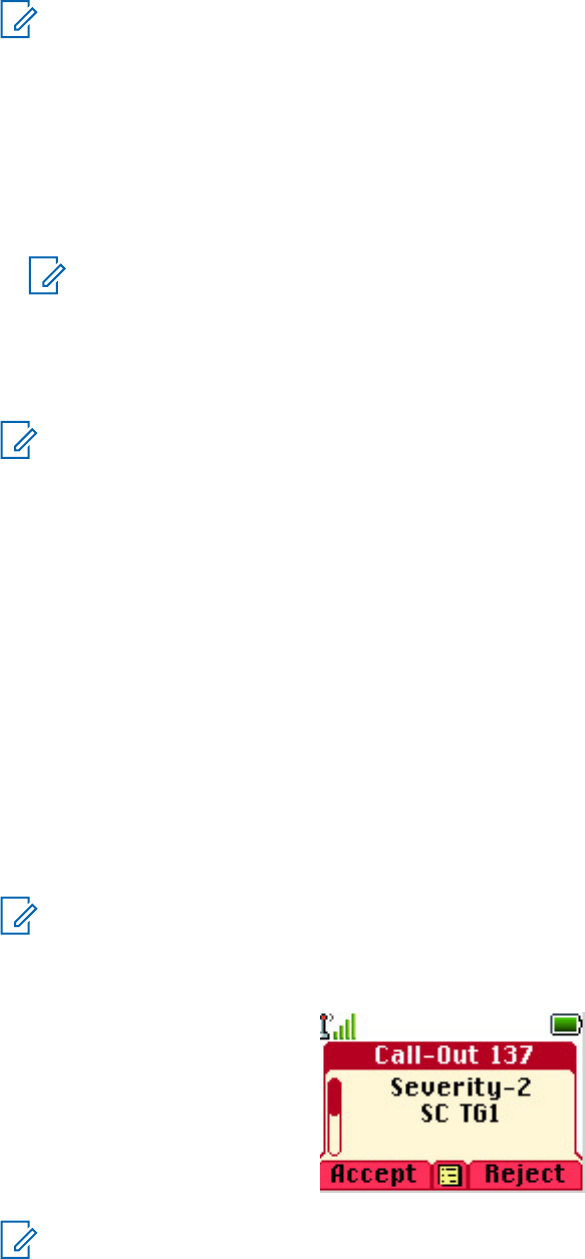
NOTICE: Your service provider sets the priority of the message.
• Push Message
- High — animation and the icon (blinking) are displayed with the New WAP Message tone.
- Medium — animation and the icon are displayed with the New WAP Message tone.
- Low — icon is displayed with the New WAP Message tone.
- Delete — available only if you are is in WAP Box, the text WAP Message deleted remotely is
displayed, otherwise there is no indication.
NOTICE: Animation is not displayed if you are in a call, or in Emergency Mode, or in Call
Out, or in message editor, or PIN lock state, or switching to DMO.
• Load Push Message
- High — browser opens to the user with the New WAP Message tone.
- Low — the icon is displayed with the New WAP Message tone.
NOTICE: Browser does not open if you are in a call, or in Emergency Mode, or in Call Out, or in
message editor, or PIN lock state, or switching to DMO.
Viewing WAP Messages
Procedure:
1From the home screen, press the MENU key.
2Select Messages → WAP Box.
3Select the required message.
4Select Go to to view the message in the browser.
Call-Out
This feature allows you to receive Call-Out alerts. On receiving the Call-Out messages, the radio
interrupts current services and attends to the Call-Out alert without any further delay. After call-out alert
has been cleared, the radio exits Call-Out mode and reverts to normal mode. During Call-Out mode
you are only able to receive Emergency Calls.
NOTICE: To read an entire Call-Out message, scroll down the screen by pressing the down
NAVIGATION key. The length of the message is indicated by the vertical red bar on the left of the
screen.
Figure 5: Call-Out Message
NOTICE: This is a selling feature.
Chapter 6: Features
Send Feedback 127

Related Links
CO Box on page 78
Types of Call-Out Alerts
There are four types of the Call-Out alerts:
• Normal Call-Out – an alert message that is sent by a dispatcher either to a single radio or to a group
of radios.
• Storm Plan – an alert message that is sent by a dispatcher to a group of radios. To raise its
reliability, it is sent several times. You are not able to respond to the Call-Out alert and any key
press takes you to the information phase.
• Fallback Mode – an alert message that is limited only to voice communication. To initiate this type
of Call-Out, press a One-Touch key predefined by your service provider. It can be cleared manually.
NOTICE: Fallback is only possible when the radio is in Local Site Trunking.
• Test Call-Out – a special Call-Out alert that is sent by the dispatcher to test this feature. On
receiving the Test Call-Out, the radio plays a tone and displays Test Call-Out. To respond and
clear the alert, press the Test OKSOFT key.
Call-Out Modes Interaction
Call-Out feature operation is different in other modes:
• TXI Mode — you can read the message but you cannot respond to it. You have an option to leave
the TXI Mode by pressing soft key or reject the Call-Out message.
• DMO Mode — Call-Out is not supported.
• Emergency Mode — all Call-out alerts are ignored.
Call-Out Service Phases
In the Call-Out mode there are following phases:
• Alerting phase — receives a Call-Out message. The alarm tone indicates the message. Text is
displayed and you have following options to use: Accept, Reject or MENU. If you accept the alert, no
other service from this point can interrupt.
NOTICE: You can stop the alert tone by pressing PTT or any of the soft keys.
• Information phase — you are still in the Call-Out mode and you can receive more detailed
information about the incident that occurred through subsequent text or the voice message. You
can query for more information using voice group call or Call-Out text function which enables you to
send a text message. You can always respond and send back the text or the voice message using
voice group call.
Shadow Groups (Address Bundle)
The Shadow Groups feature (also known as Address Bundle) offers a way of sending messages to
multiple destinations or recipients simultaneously. Three types of messages are supported by the
feature:
• Status messages (including Emergency Alarms)
• GPS LIP (TETRA Location Information Protocol) reports
Chapter 6: Features
128 Send Feedback

• RMS/FMS messages
Shadow Groups in TMO
Each Shadow Group may contain up to four target addresses. Each talkgroup may be configured to
send status messages, GPS LIP reports, or RMS/FMS messages to a specific Shadow Group.
Shadow Groups in DMO
In DMO, the Shadow Group contains one target address. Each talkgroup may be configured to send
status messages or GPS LIP reports to a specific Shadow Group.
Each radio can store up to 255 Shadow Groups (both in TMO and DMO).
The Shadow Groups feature may affect Emergency Calls setup time to be slightly elongated.
NOTICE: This is a selling feature and needs to be enabled by your service provider.
Chapter 6: Features
Send Feedback 129
This page intentionally left blank.
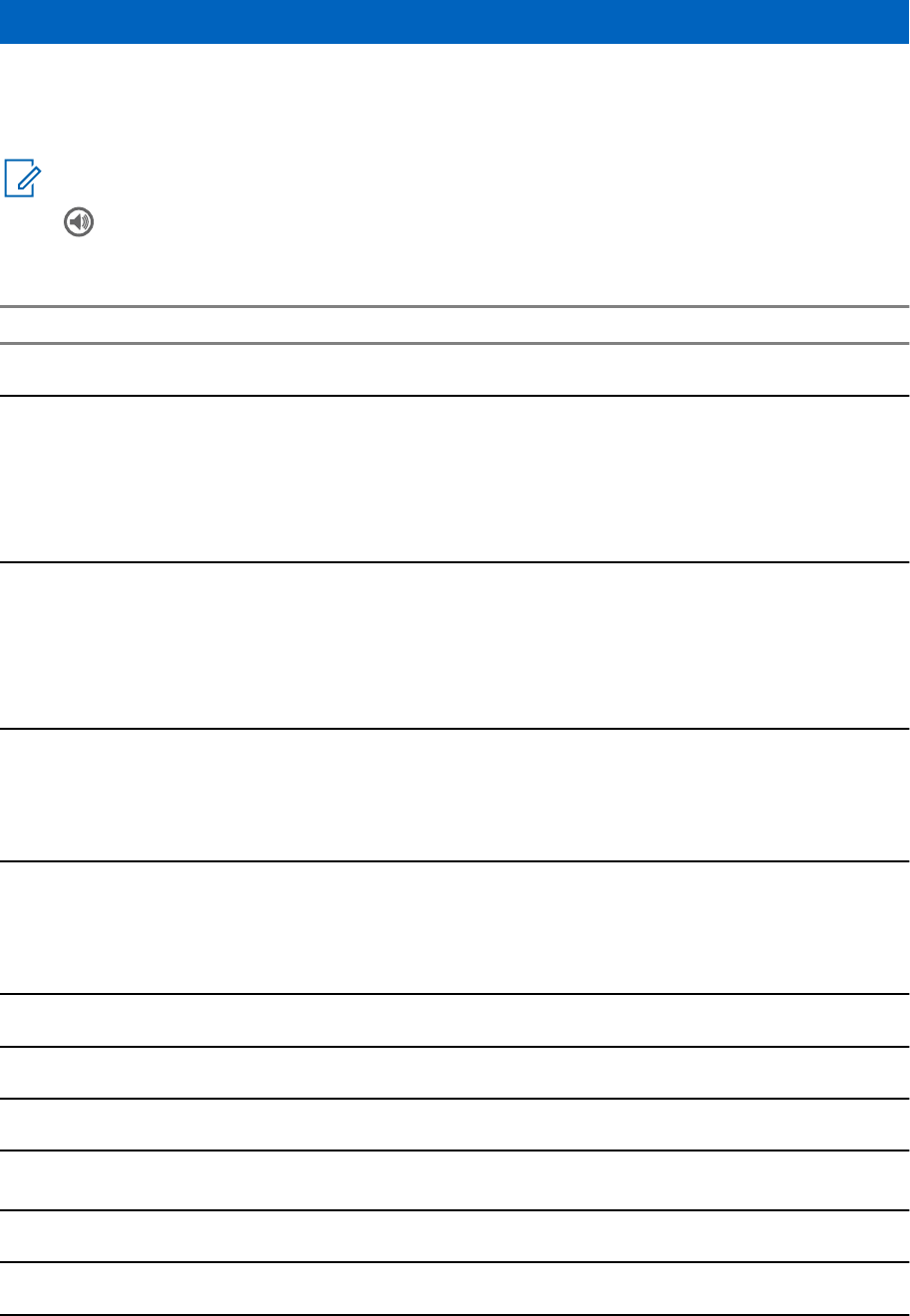
Appendix A
Tones
NOTICE: The radio has two tone packs – Classic Tones (default) and New Tones. Your service
provider decides which tone pack is enabled. To listen to the audio signal tones samples, click
.
Table 25: Radio Tones
New Tone Classic Tone Tone Description
Default Beep – Played when pressing a key.
Invalid Action
Examples:
• Pressing an invalid key.
• Dialing an invalid number.
• Talk prohibit.
System Notification
Examples:
• The radio changed its status from out-of-range to in service.
• The radio returned to the home network.
• Toggling between the TMO and DMO modes.
System Error
Examples:
• The radio changed its status from in service to out-of-range.
• Call disconnected.
General Notification
Examples:
• Entering Local Site Trunking.
• Entering the Transmit Inhibit Mode.
Positive Notification – Message sending succeeded.
Negative Notification – Message sending failed.
Item Received – A new message received.
Talk Permit – The radio user is allowed to transmit their message
(after pressing the PTT button).
Clear-to-send – Data transmission ready to begin.
Emergency – The Emergency Call received.
Table continued…
Tones
Send Feedback 131

New Tone Classic Tone Tone Description
Emergency 2 – The Emergency Call received (optional tone)
Low Battery – The battery charge level is low.
Over the Air 1 – Single D-PTT tone.
Over the Air 2 – Double D-PTT tone.
Over the Air 3 – Triple D-PTT tone.
Phone Busy – The called radio is busy.
Phone Ring Back – Played on the initiating phone when the Phone
Call is being setup.
Private Ring Back – Played on the initiating phone when the Private
Call is being setup.
Ringtone 1.
Ringtone 2.
Ringtone 3.
Ringtone 4.
Ringtone 5.
Simplex Volume Set – Played when adjusting simplex volume.
Duplex Volume Set – Played when adjusting duplex volume.
Appendix A: Tones
132 Send Feedback
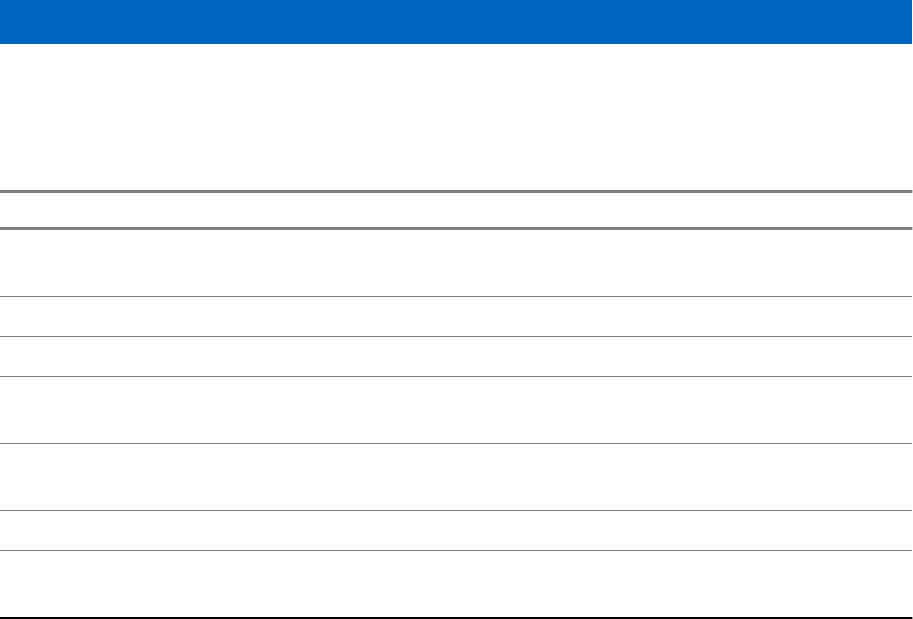
Appendix B
LED Indications
Table 26: LED Indications
Indication Status
Solid green In use
Repeating call
Blinking green In service
Solid red Out of service
Blinking red Connecting to the network
Entering DMO
Solid orange Transmit inhibit in service
Channel busy in DMO
Blinking orange Incoming call
No indication Radio in Covert Mode
Radio powered down
LED Indications
Send Feedback 133
This page intentionally left blank.
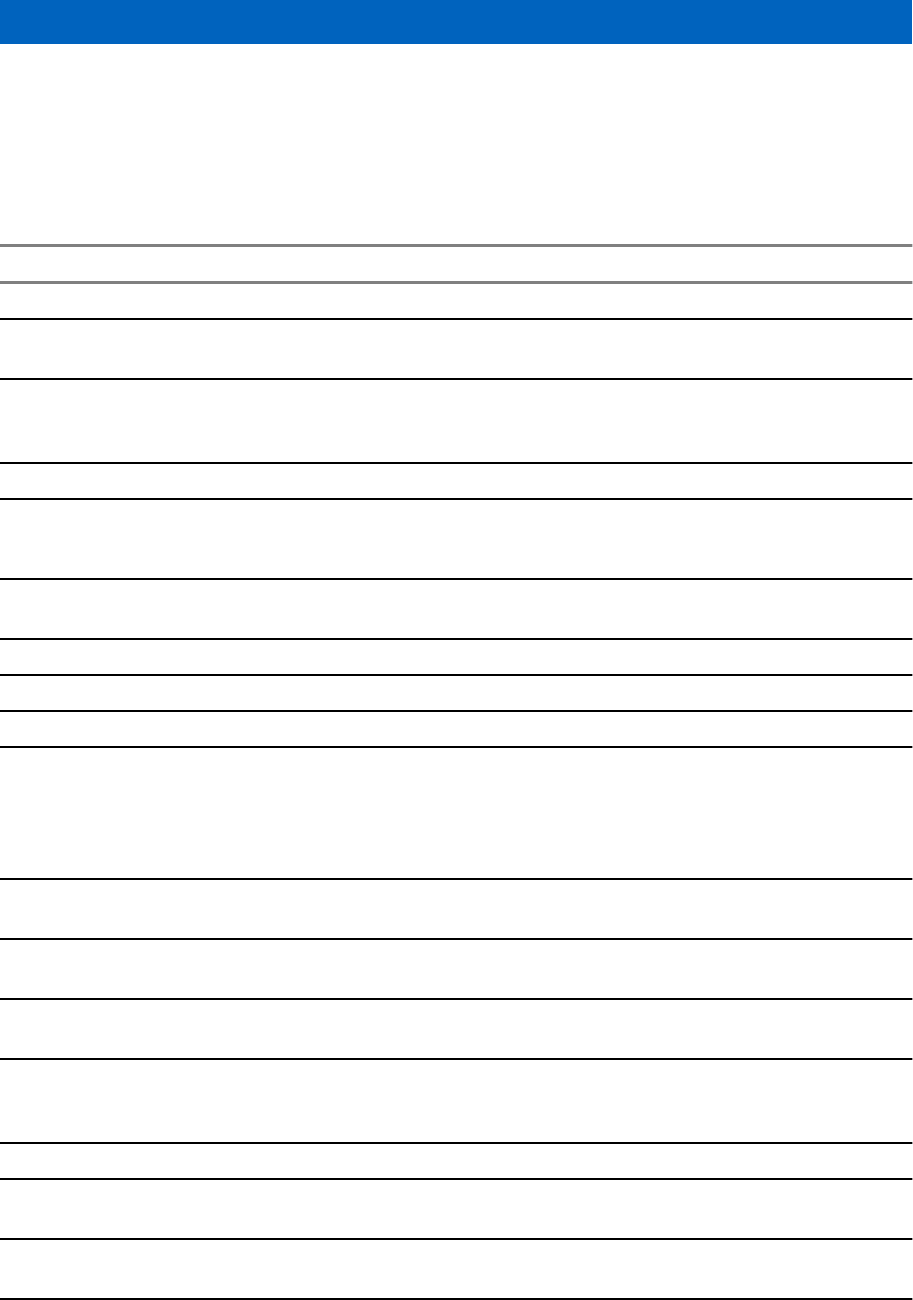
Appendix C
Troubleshooting
Your radio displays the following messages:
Table 27: Displayed Messages
Message Message Description
...-Received Call received but not answered, or rejected.
Attachment Failed Your radio could not perform talkgroup attachment. It keeps on
trying. If it does not succeed, try another talkgroup.
Authenticate Failure Your radio could not register on an authenticated system (for
example, the Authentication Key is incorrect, or authentication
is disabled).
Call Cancelled You have canceled the call.
Call Ended • Faulty channel. Please try later.
• You have ended the call.
Call Forwarding The radio you are trying to call is not available and the call is
being forwarded to another radio.
Call Modified The call you are participating in has been modified.
Call Preempted Channel being used for priority.
Decryption Failed: An error occurred while decrypting a message or call.
Emergency In Use
Wait For Mic
The Hot Microphone feature is active, but the channel transmit
grant has been given to another Emergency call on the same
talkgroup. Your radio microphone is not active during this time,
but it automatically tries to regain talk permit after a predeter-
mined time.
Emgcy Mic Ended The Hot Microphone timer automatically expired, or you press-
ed the PTT button to cancel the Hot Microphone feature.
Emergency Mic On The Hot Microphone feature is active, and your radio is auto-
matically transmitting hands free emergency audio.
Empty Entry The speed number you dialed does not exist, or the number
exists but the group is non-selectable.
Faulty Unit
Error
Self-test failed. An operational fault has been detected with
your radio. Record the error number. Turn your radio off and
contact service.
Gateway available Your radio has connected to a gateway.
Gateway not available Your radio cannot connect to a gateway, or connection has
been lost.
This group already exists The group you are attempting to add exists in the My Groups
folder.
Table continued…
Troubleshooting
Send Feedback 135

Message Message Description
Individual Calls Only You can make only individual (private) calls.
Insufficient visible data Your radio is in the process of determining your location. This
process may take several minutes to complete.
Insufficient visible satellites Your radio is in the process of determining your location. This
process may take several minutes to complete.
Invalid ID The entered number is not valid.
Invalid Shortcut Position The entered number is not valid.
Limited Service Emergency Calls, Emergency Alarms, and mobility operations
(for example group attachment) are allowed. All other incoming
and outgoing call and data services are blocked.
List Empty There are no programmed entries in the scrolling list. Type the
entry.
List Not Attached All talkgroups in the scan list are not attached.
List Partially Attached The scan list is active, but not all talkgroups are attached to it.
Message Delivered Indicates mail successfully delivered.
Message Failed Indicates mail delivery failure.
New Delivery Status You have received a new Delivery Status.
No Service Your radio is outside coverage. Return to coverage.
Not allowed in repeater mode The service or feature is not available in the Repeater Mode..
My Groups
Is Empty
You cannot view/delete groups when the My Groups folder is
empty.
My Groups
Is Full
You are not allowed to add a group to the My Groups folder
as it already contains the maximum allowed number of groups.
Network Trouble Network problems. Please try again later.
No Answer The called party does not answer.
No Entries This message is displayed when accessing an empty list.
No Group • Attachment failed. Your radio detached from current talk-
group. Please wait until it attaches again to the current talk-
group.
• Displayed when you are out of the normal coverage area of
your selected talkgroup. Please select a new talkgroup that
is valid for your working location.
• Indicates a favorite group was removed from the My
Groups folder.
No List The network list is empty.
No New or Old Messages Indicates there are no new or old messages in the Inbox.
No Selected Scan List You selected an empty network list.
No Service Your radio is out of coverage.
Table continued…
Appendix C: Troubleshooting
136 Send Feedback

Message Message Description
Not Allowed To Initiate Call You are not allowed to dial a number which is not in the ad-
dress book.
Not Allowed To Transmit Release the PTT button and try again later. You are not al-
lowed to send a text message or a status message to a num-
ber which is not in the address book.
Single TalkGroup Only There is only one programmed entry in the scrolling list.
Overheating, Please Turn Radio Off Your radio turns off. Keep it turned off for 5 minutes.
Party Busy Called radio is busy.
Party Not Available Called radio is out-of-range or turned off. Please try again later.
Please Try Again You could not call.
Please Wait Connecting A message during startup.
Registration Failure Your radio could not register within the system. Please try
again later.
Repeater available Your radio has connected to a repeater.
Repeater not available Your radio cannot connect to a repeater, or connection has
been lost.
Service Denied Invalid number. Call your service provider.
Service Not Available This service is not available on the current network.
Service Restricted This service or feature is restricted by your service provider, it
has not been purchased, or it is not available.
TalkGrp ... cannot be deleted Your service provider set this group so you cannot delete it
from the favorite talkgroup folder.
Try Again Later The requested service is temporarily unavailable.
Radio Disabled Check with your service provider.
Unit is OK
Warn:
Self-test error. A minor fault has been detected. Your radio is
still fully operative. If this error recur, note the error code and
contact service.
Unit Not Attached You radio could not attach to the system. The talkgroup may
not be defined in the system. Please try another group.
Unassigned Button The message is displayed when no feature is assigned to a
button.
Appendix C: Troubleshooting
Send Feedback 137
This page intentionally left blank.
